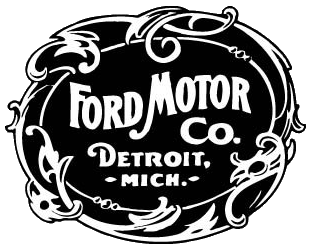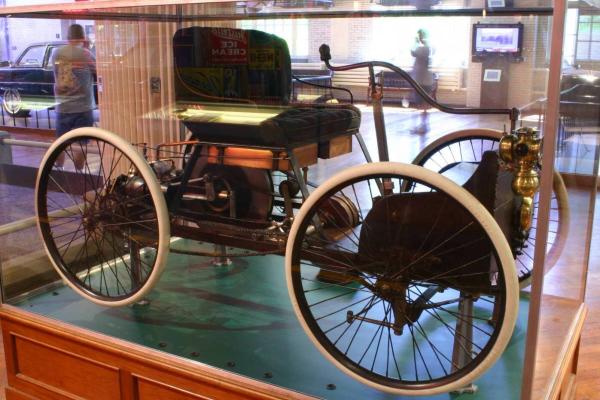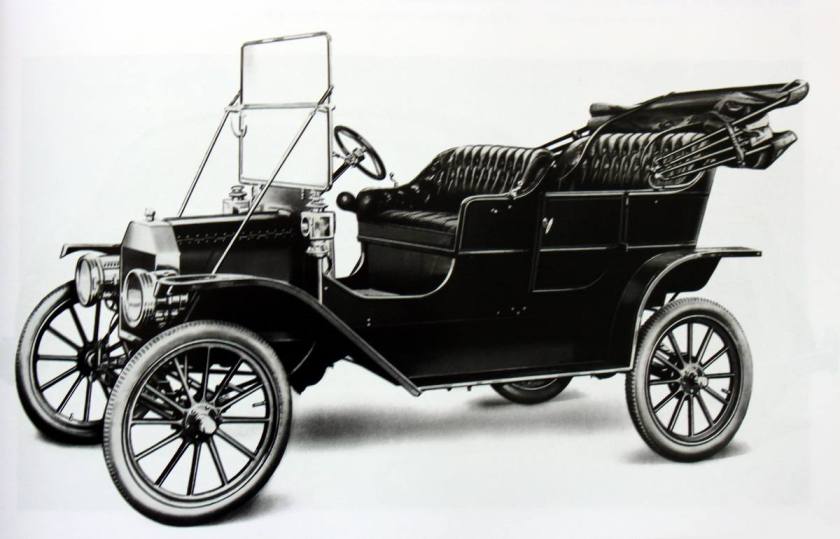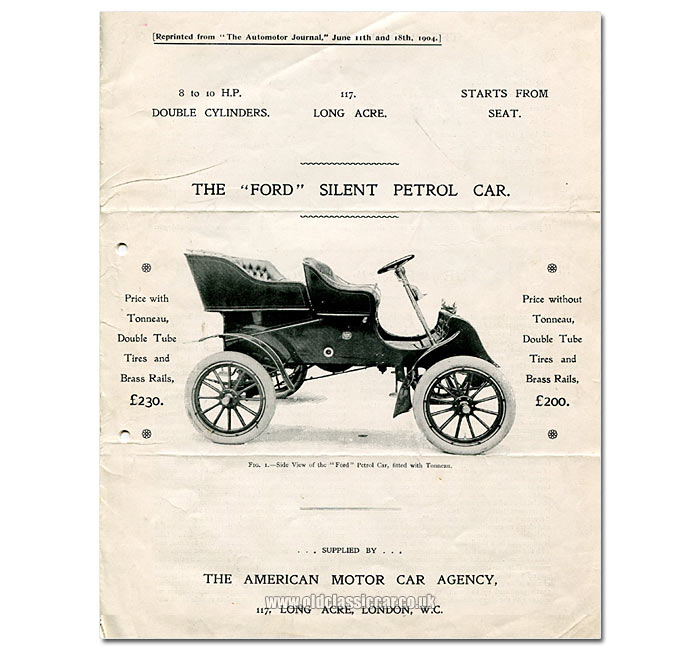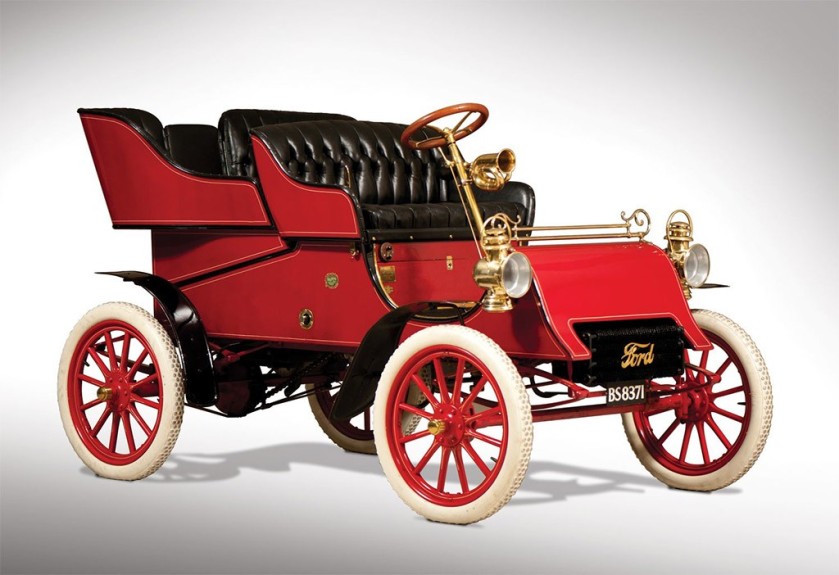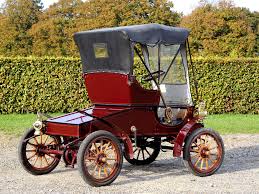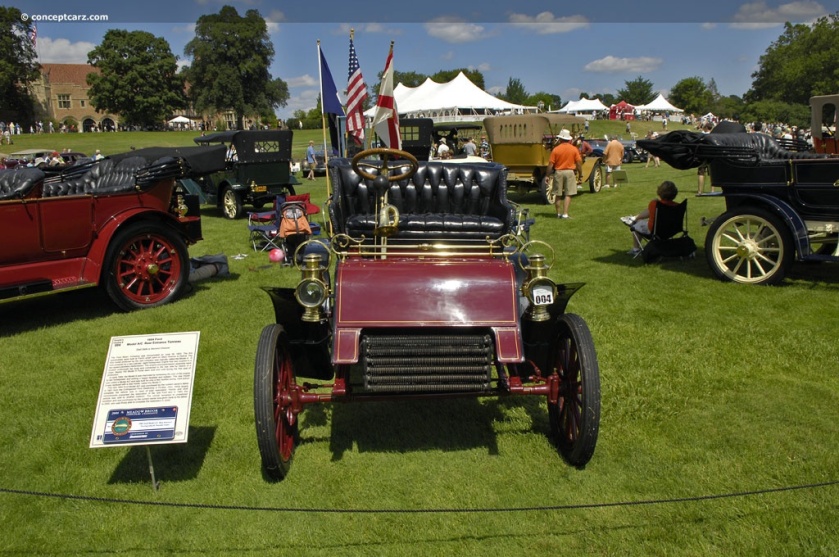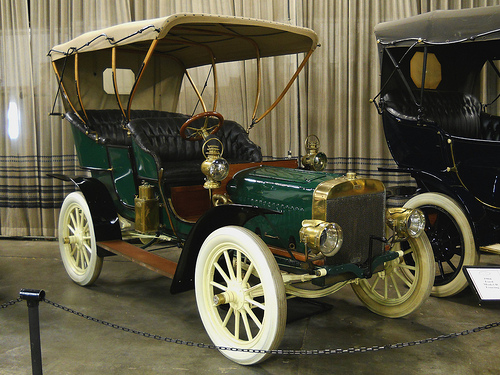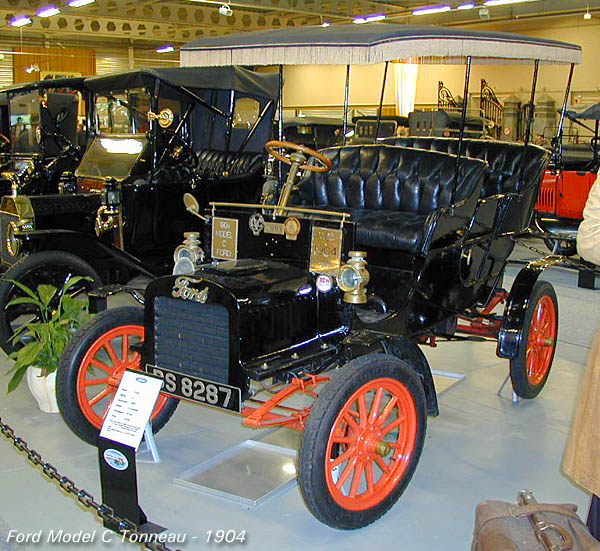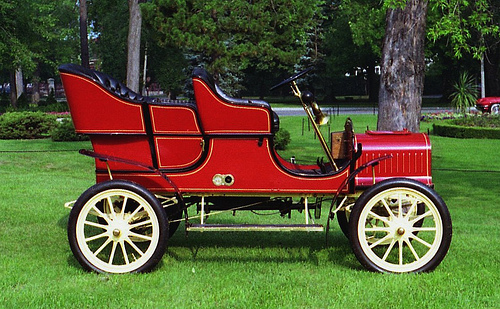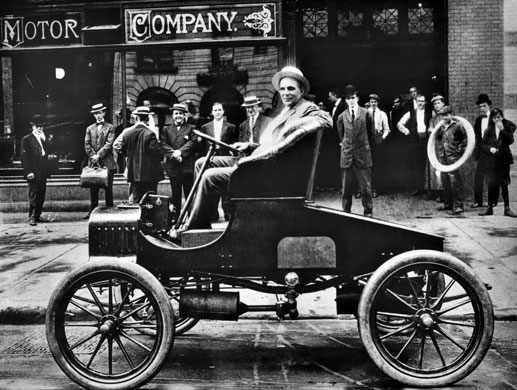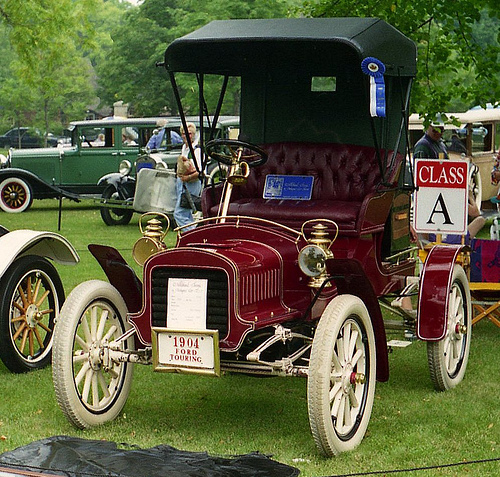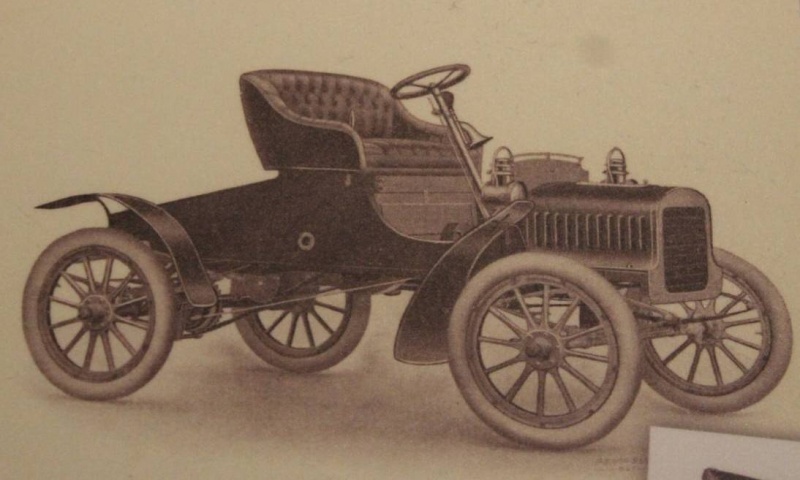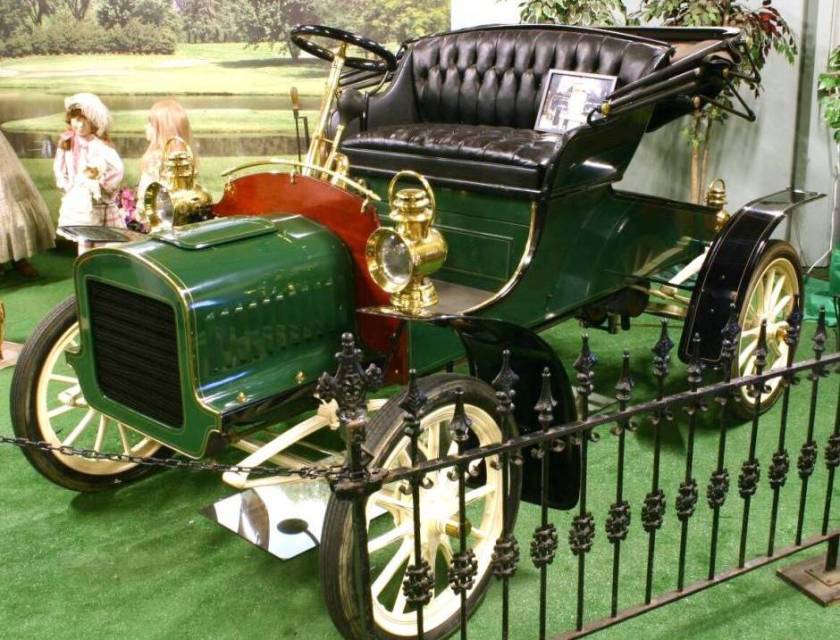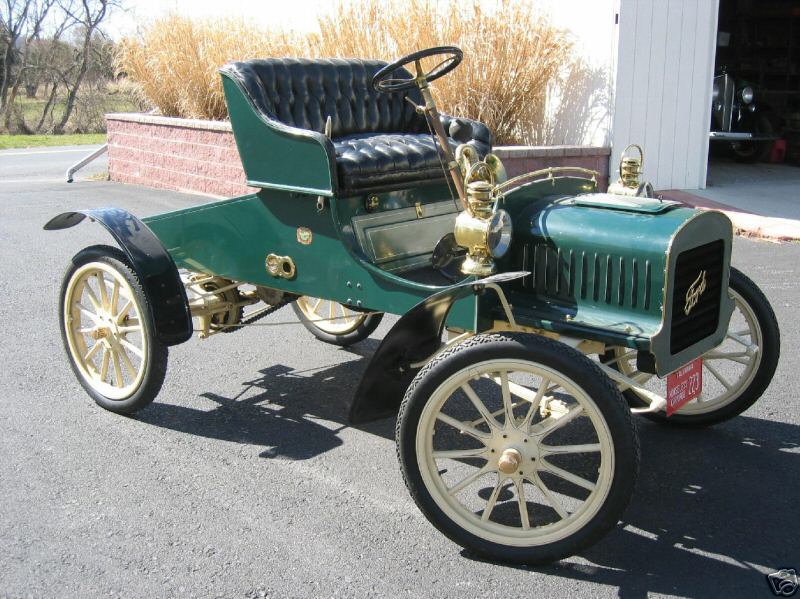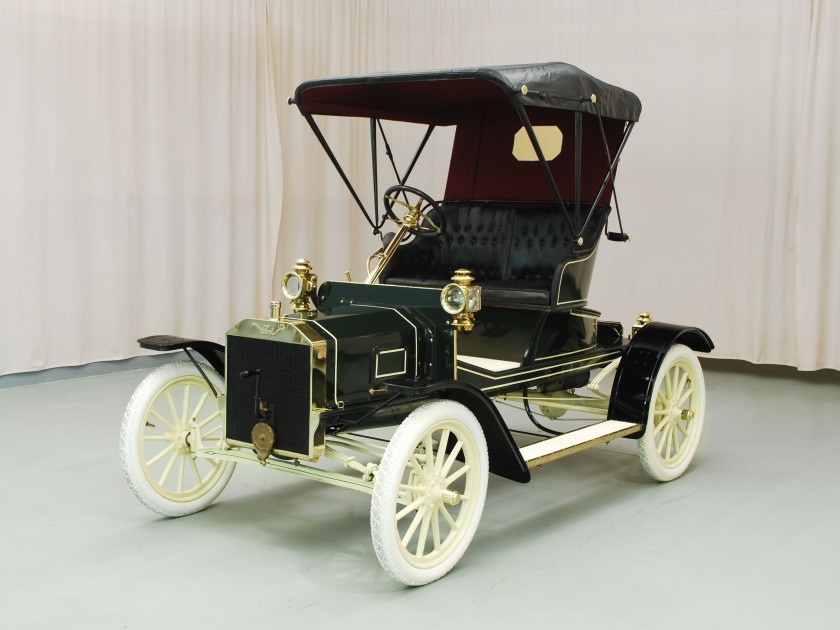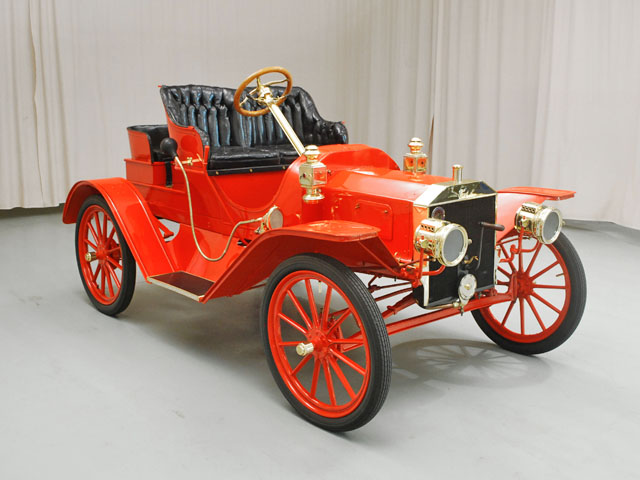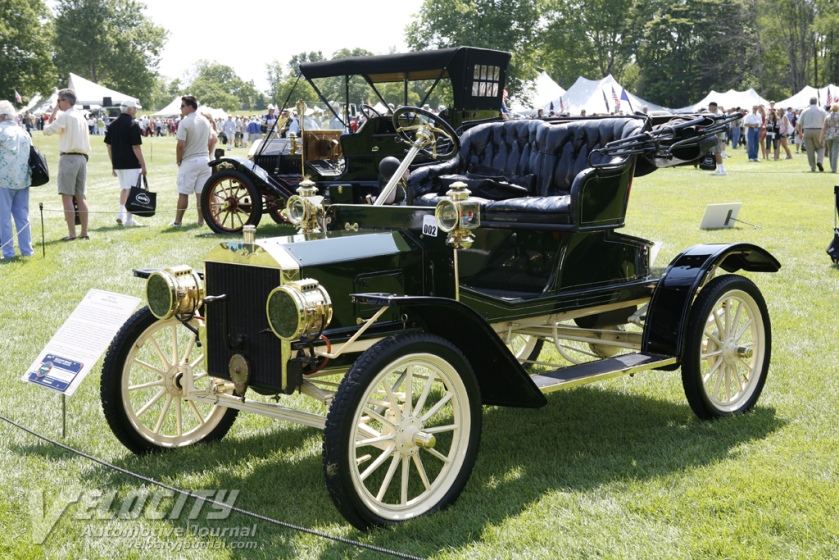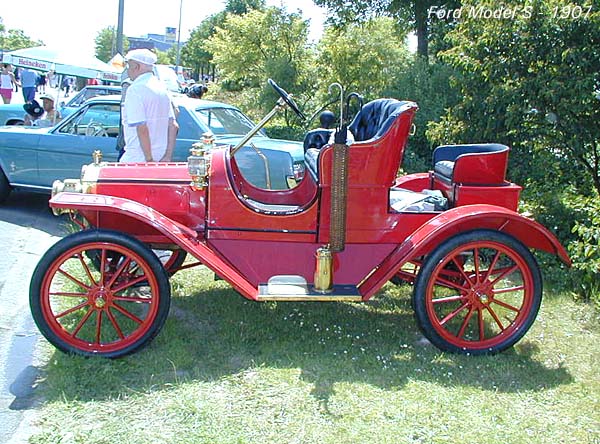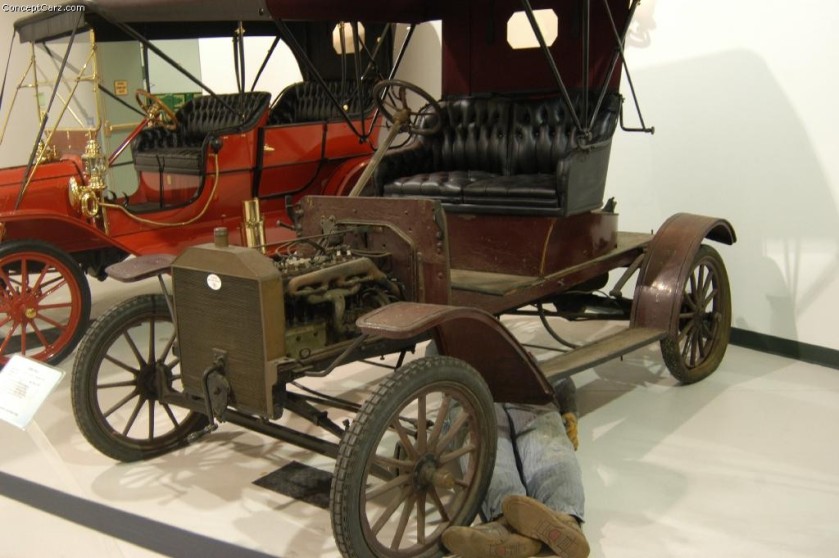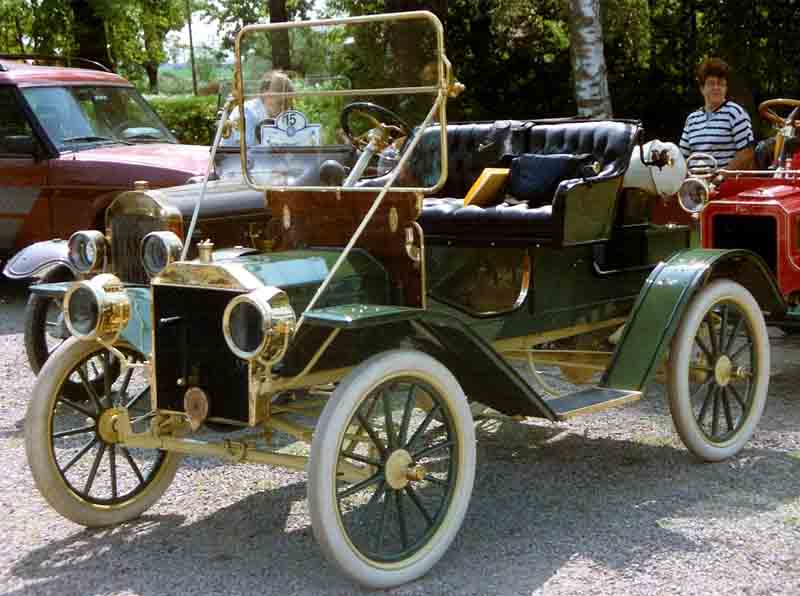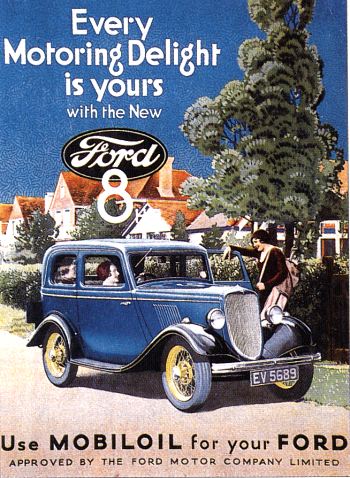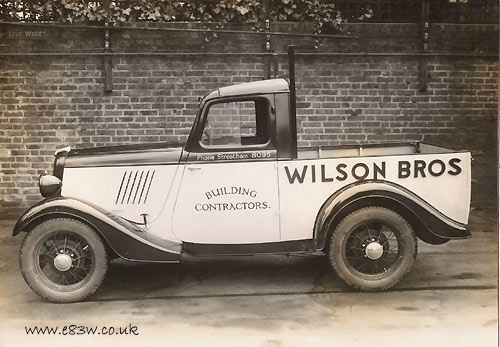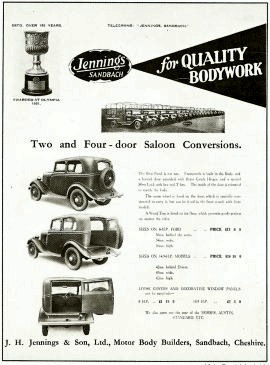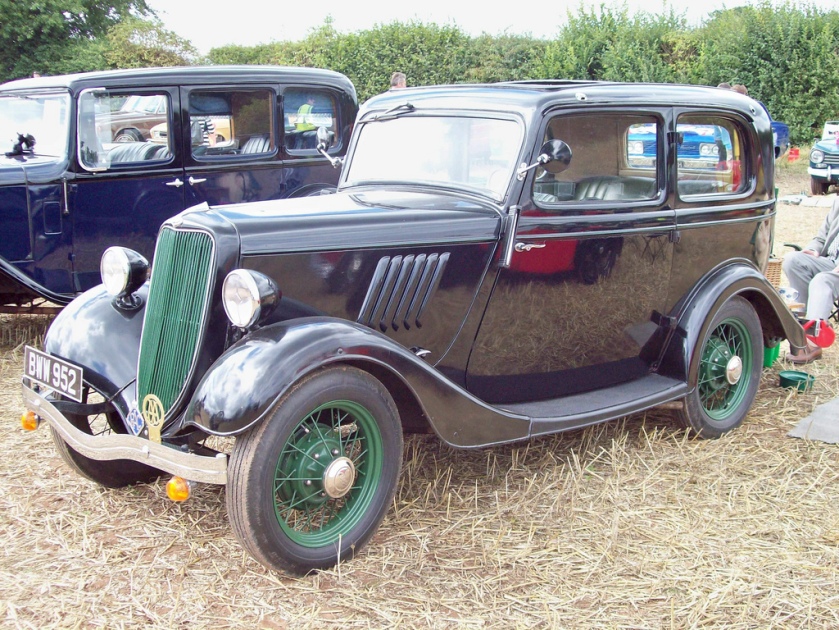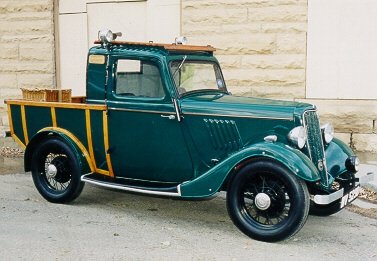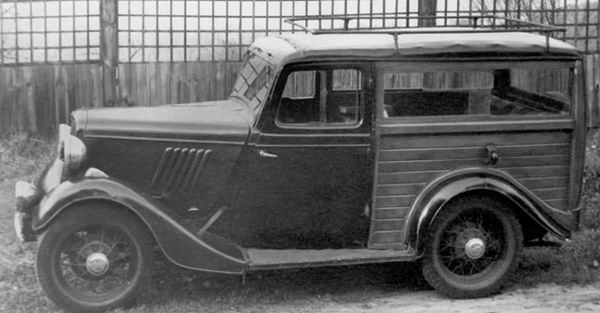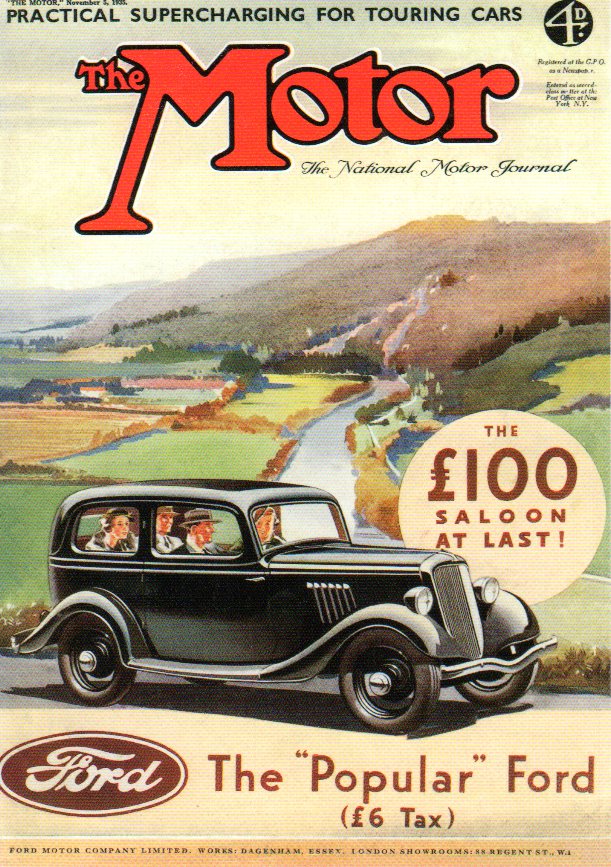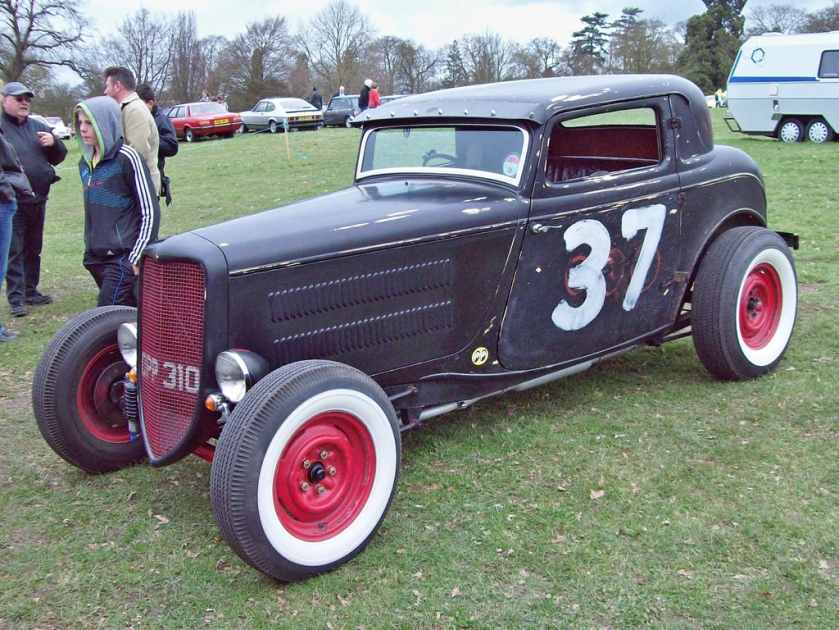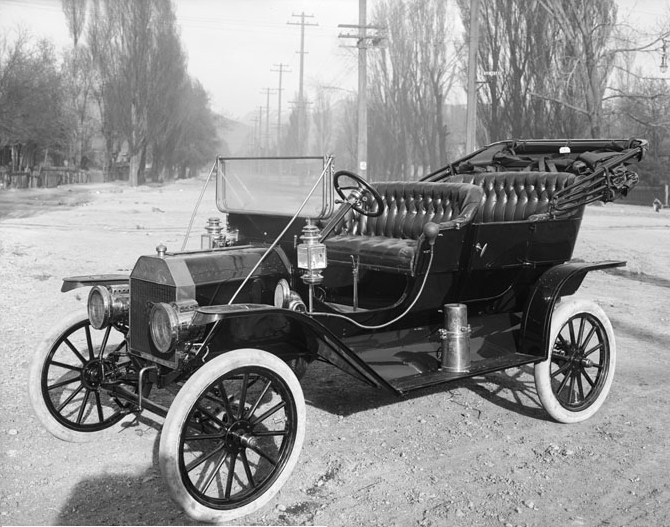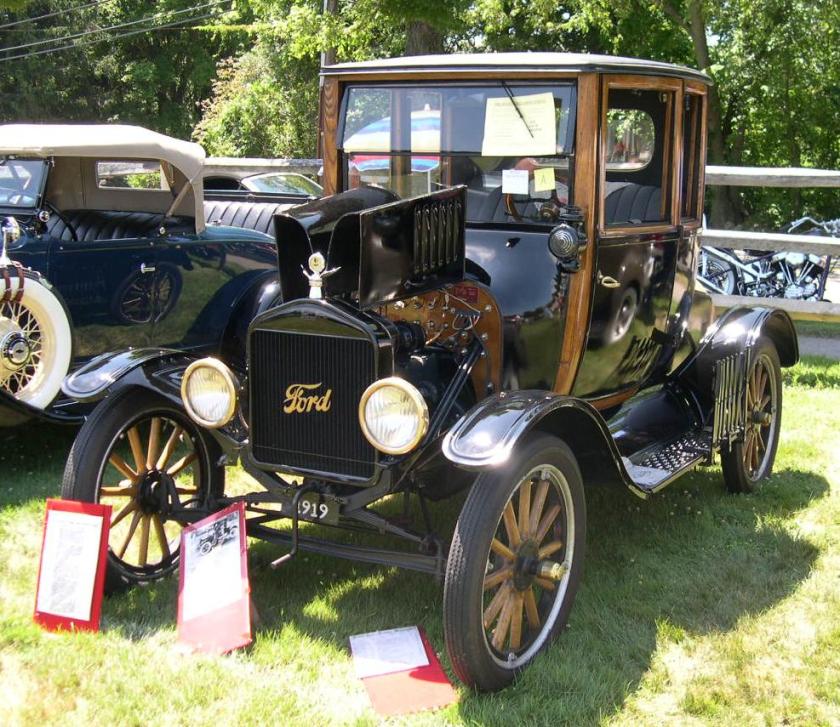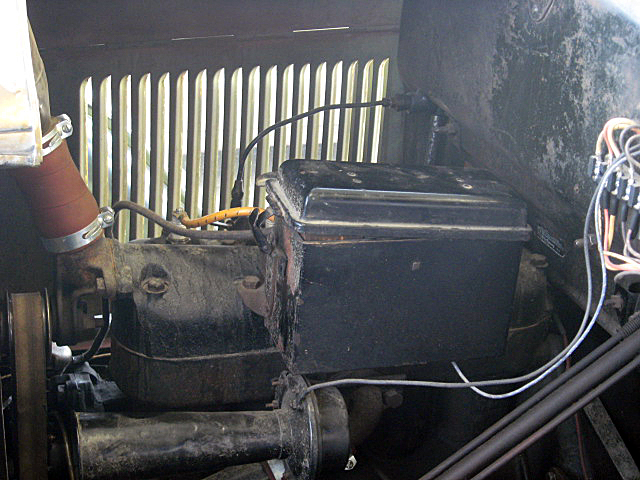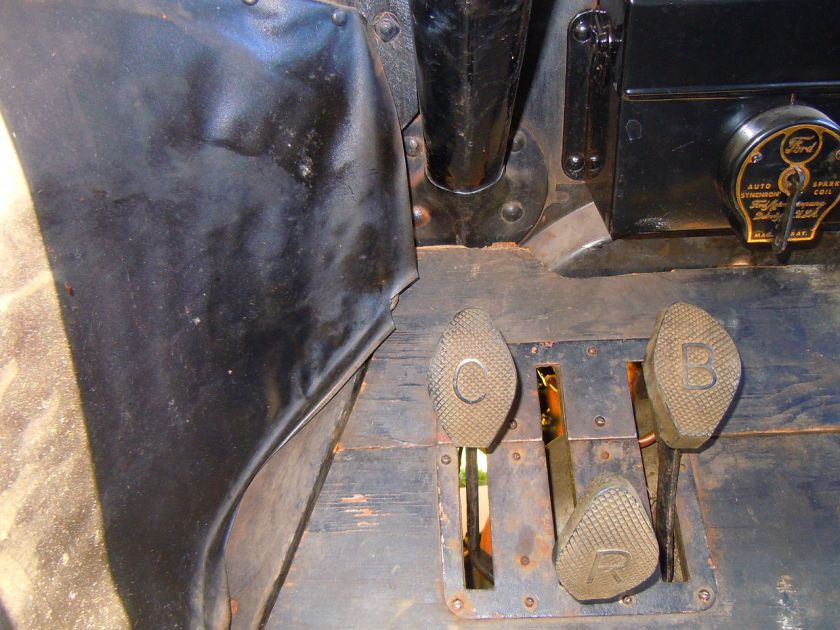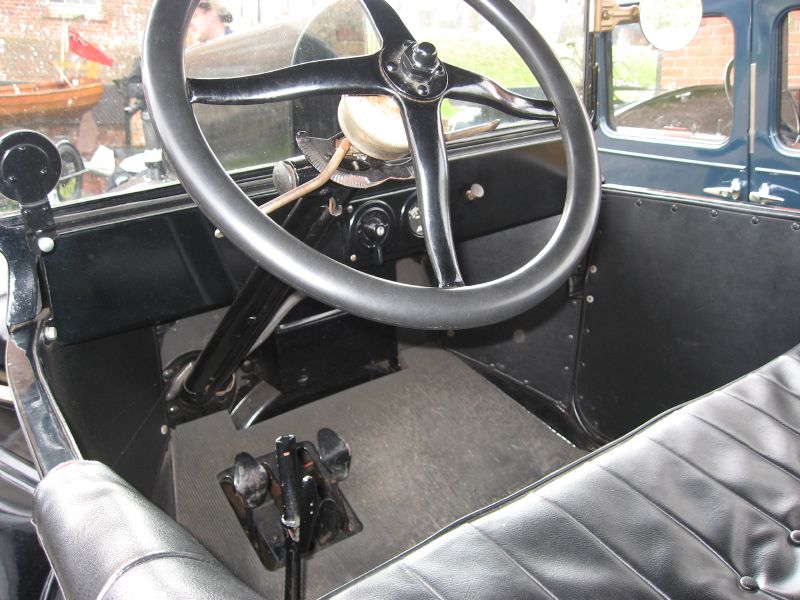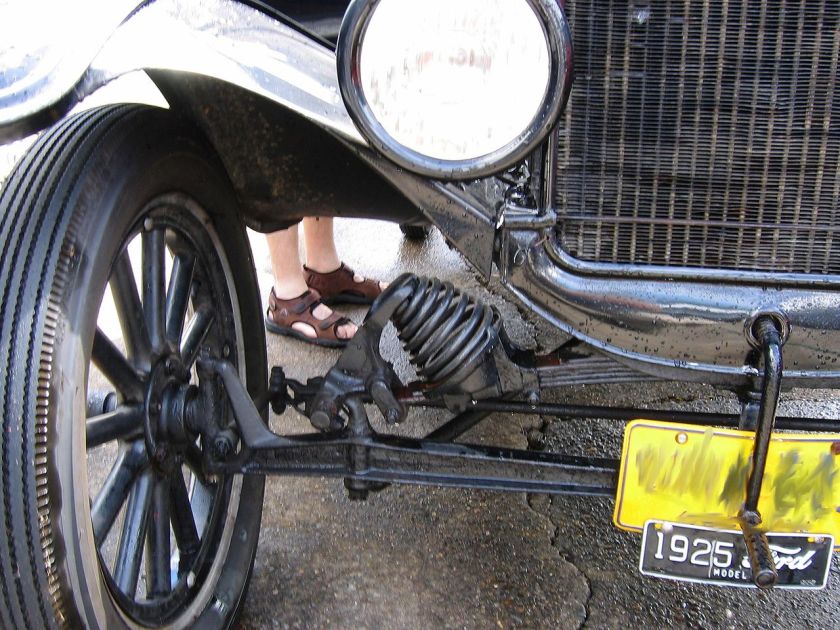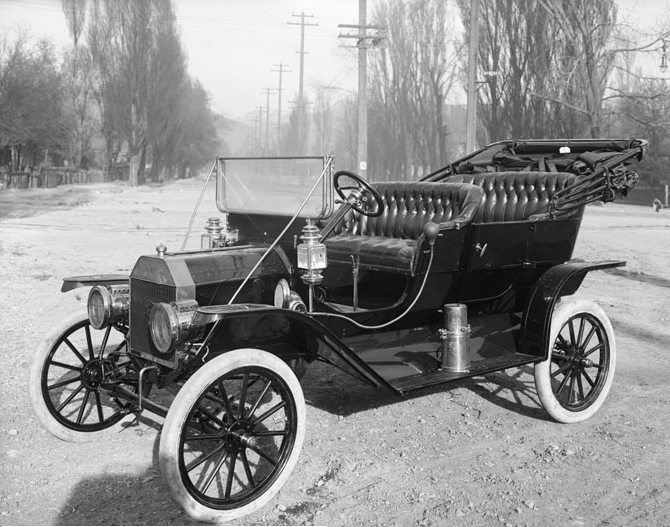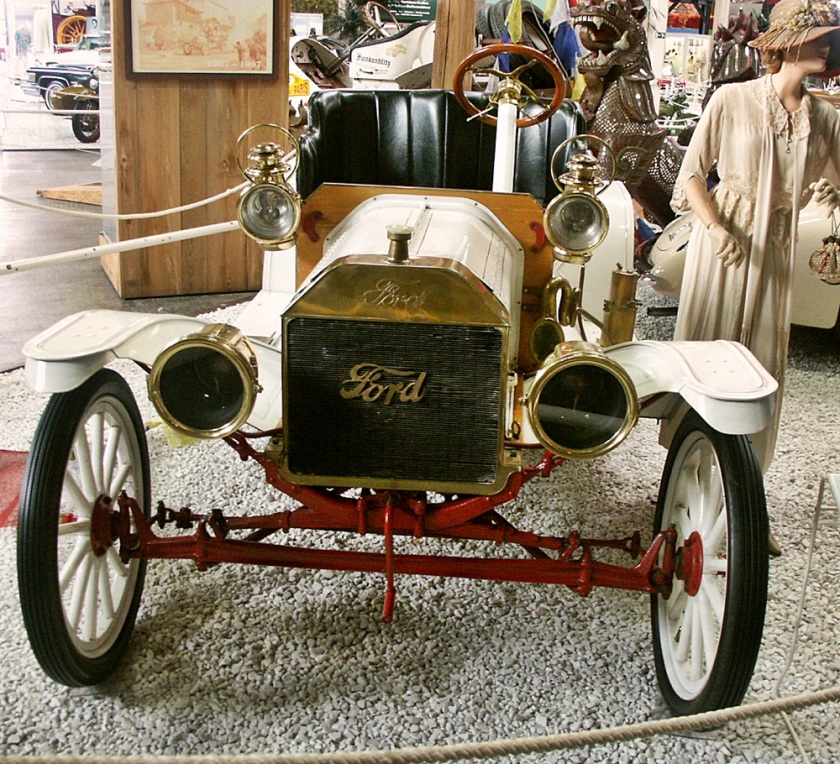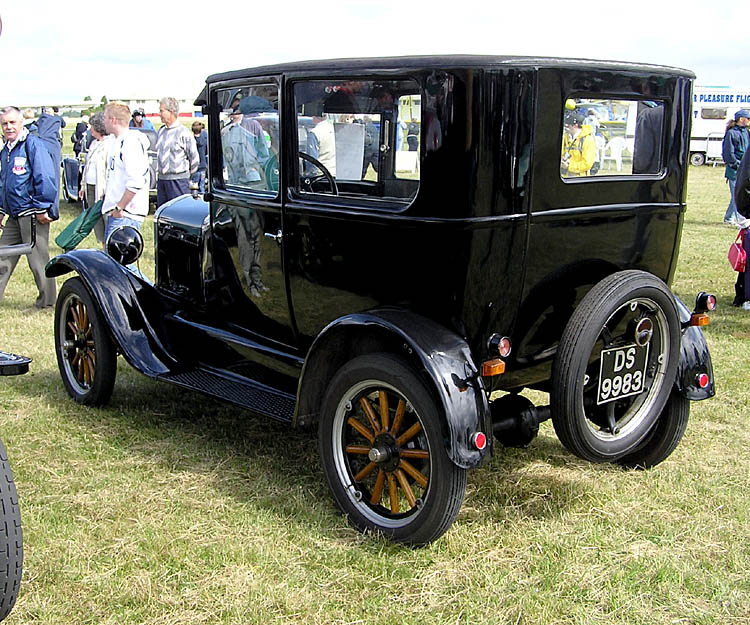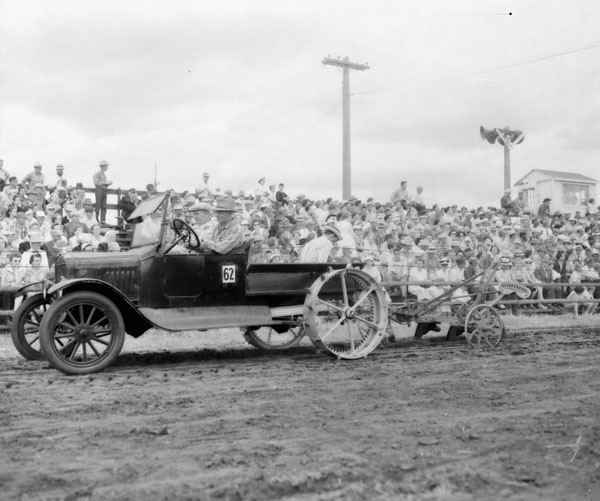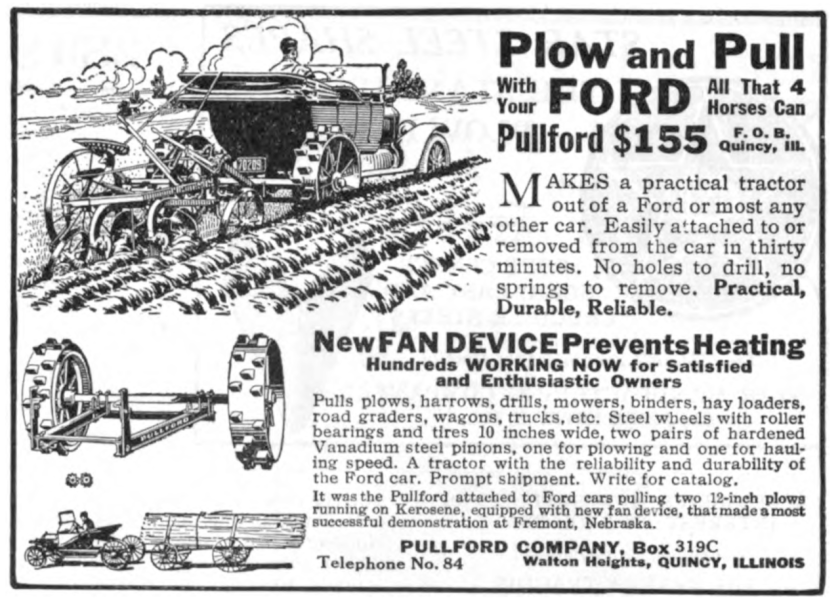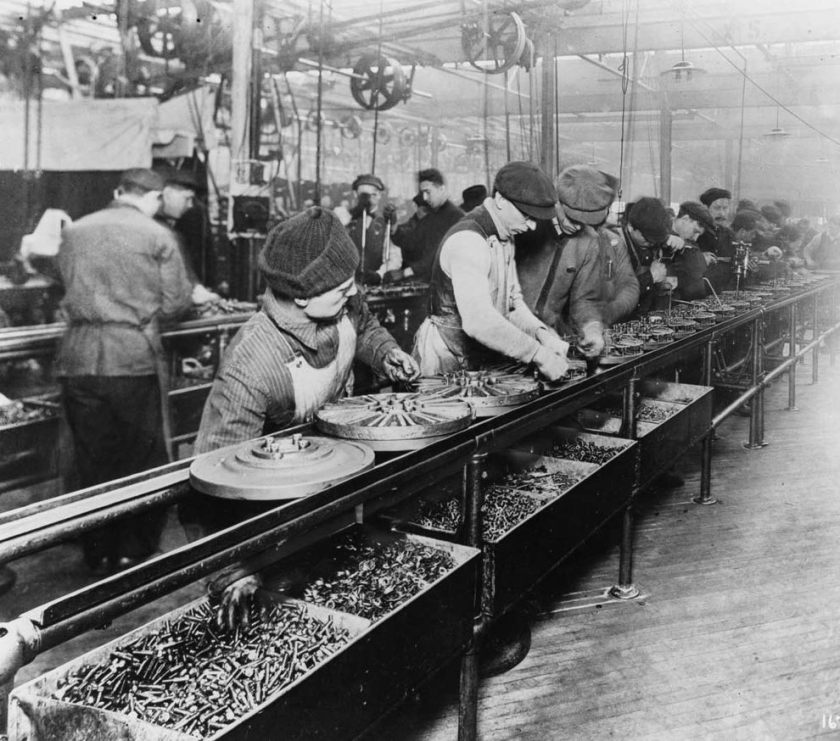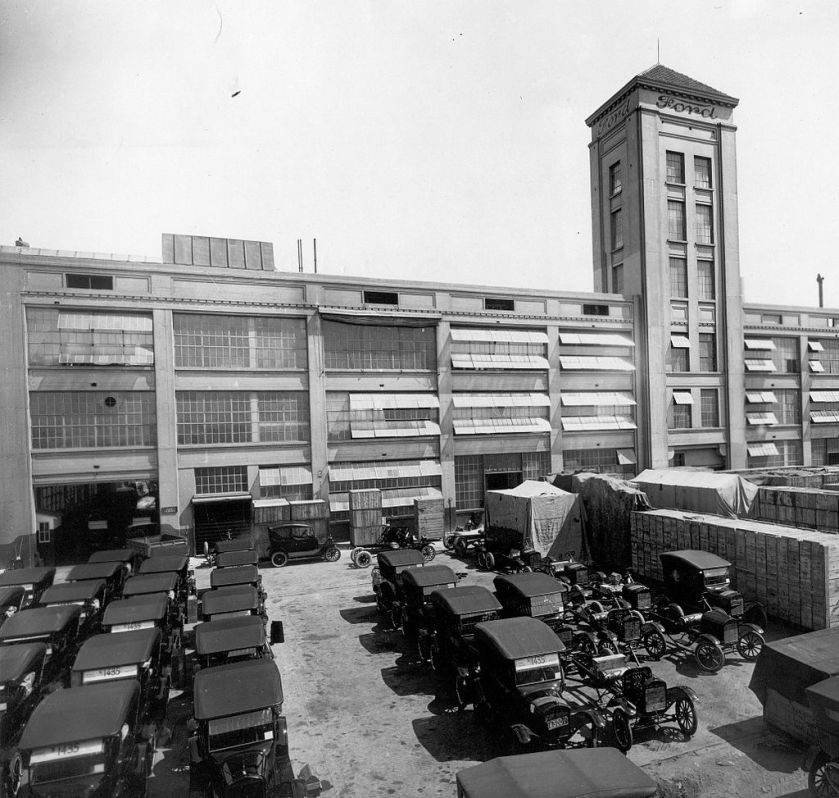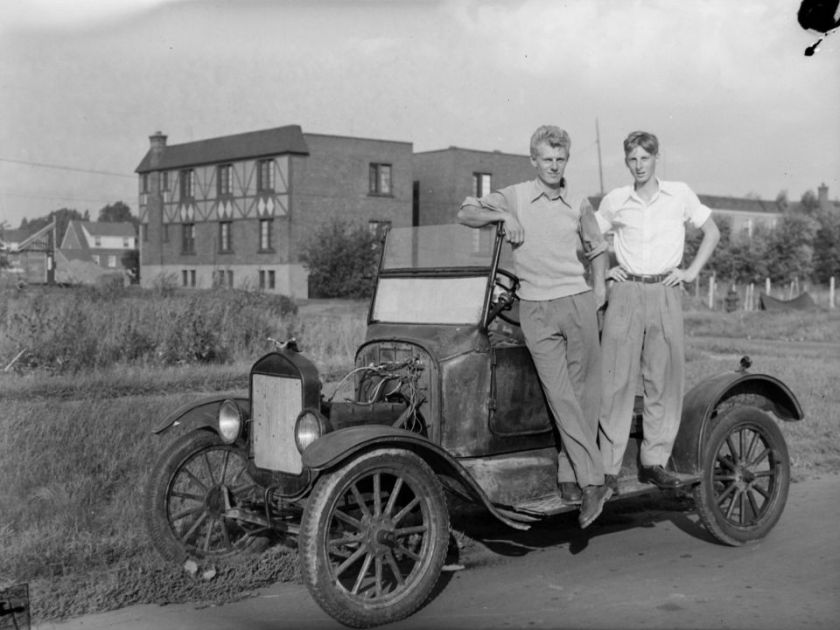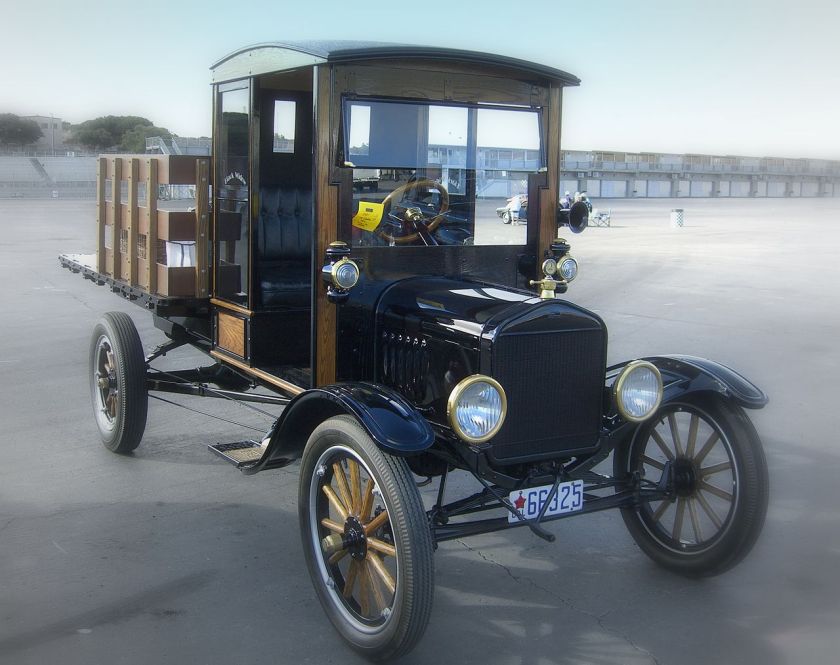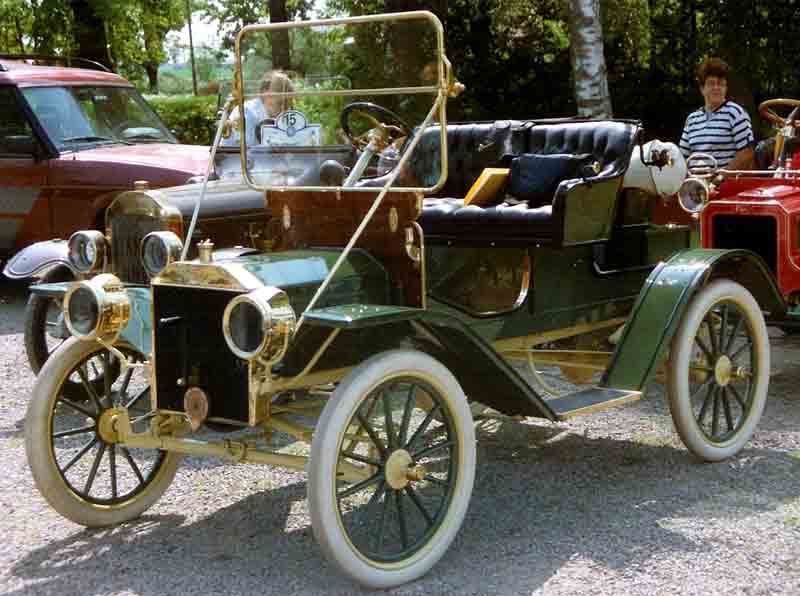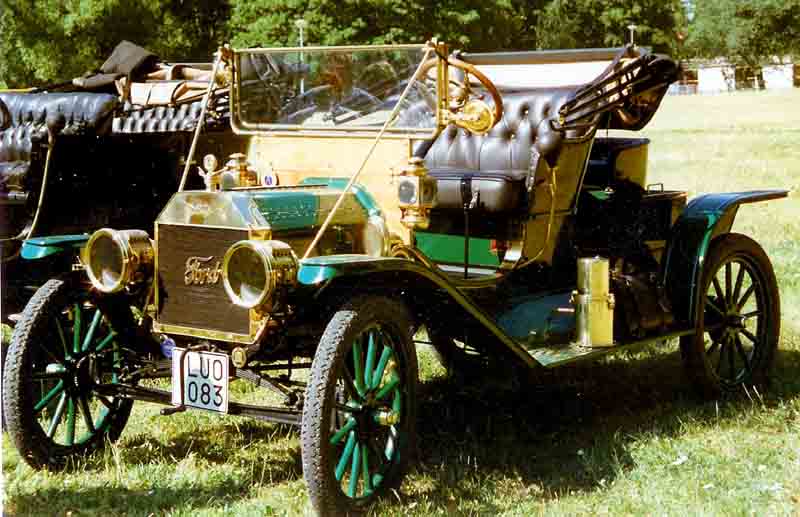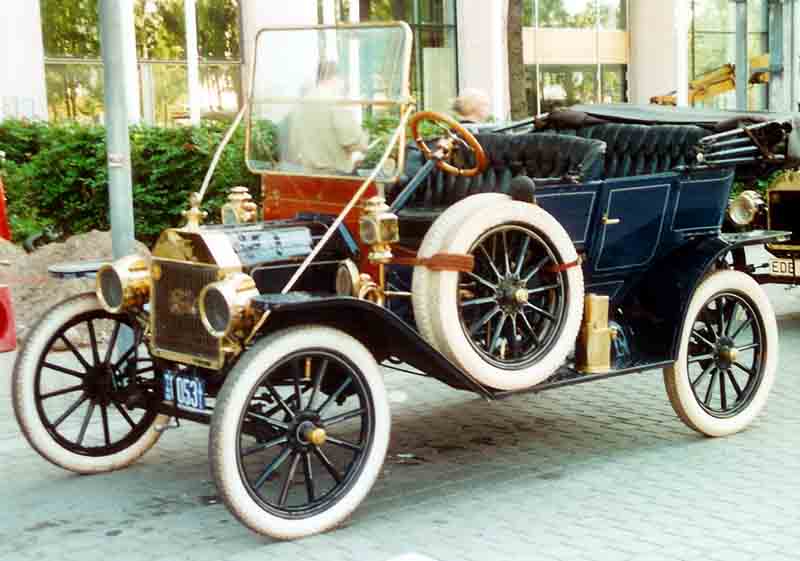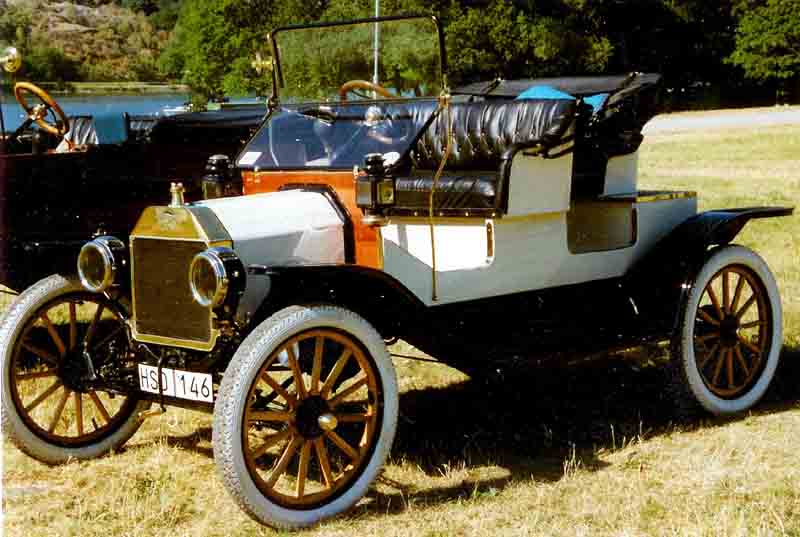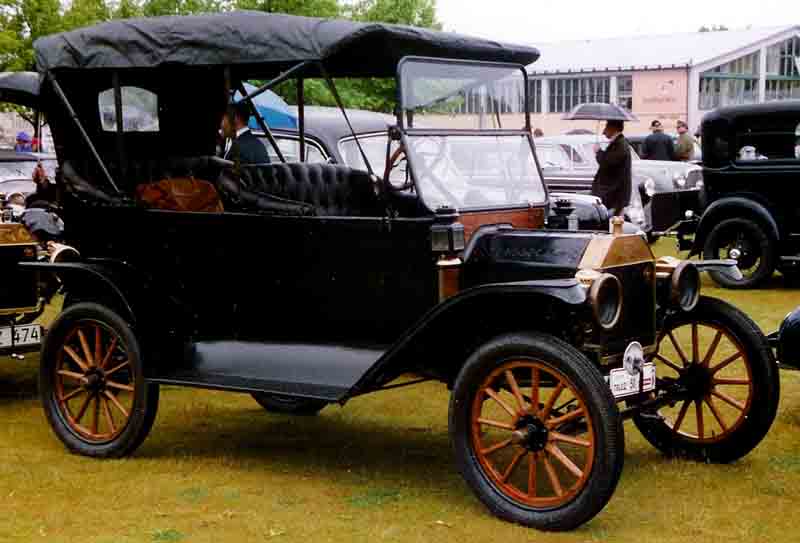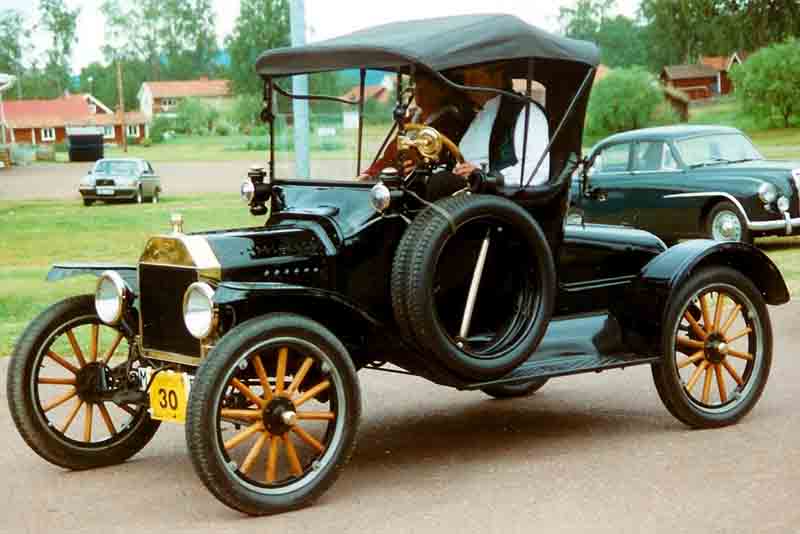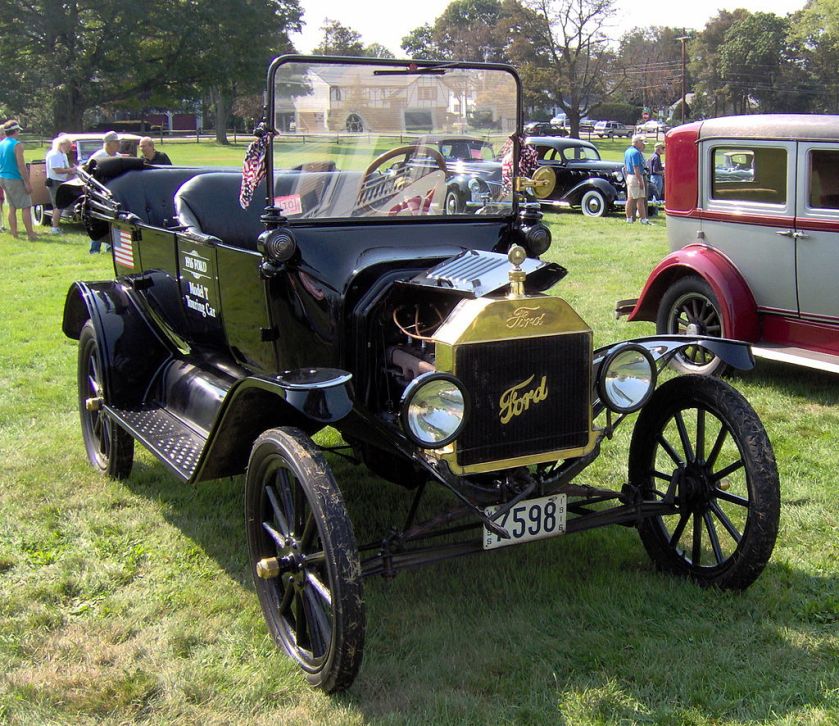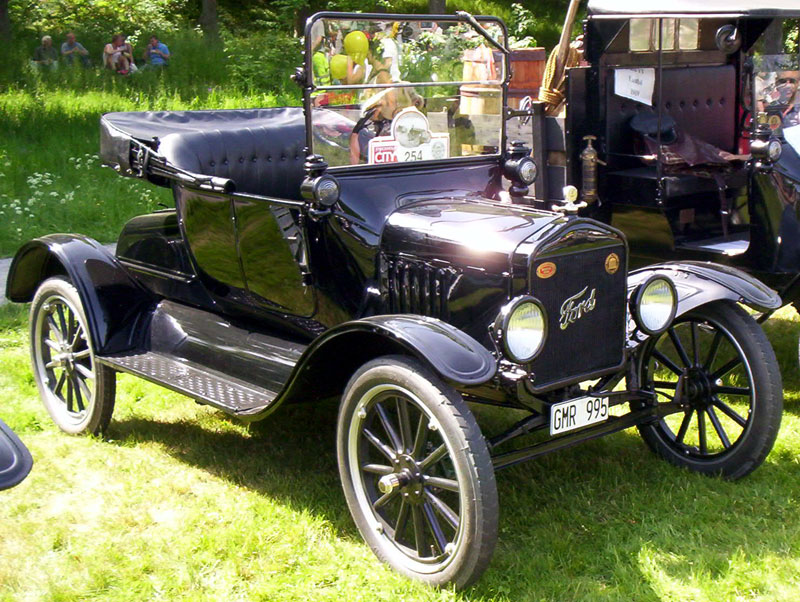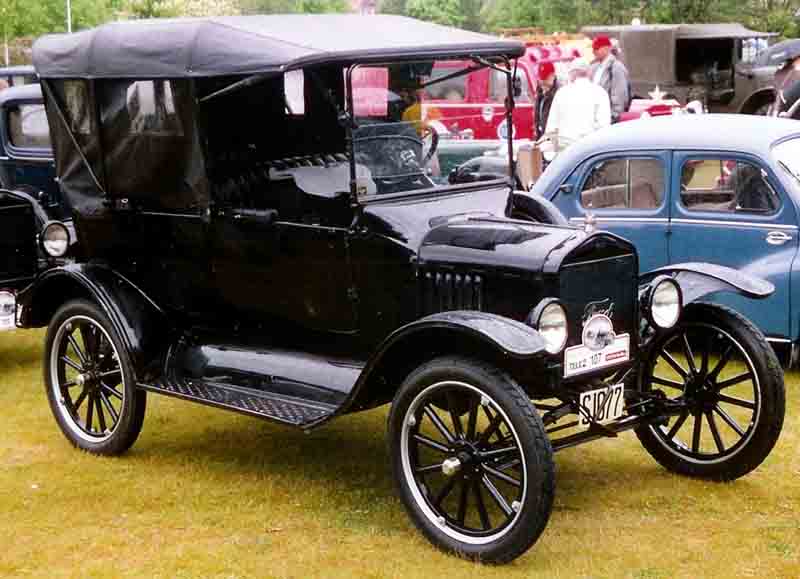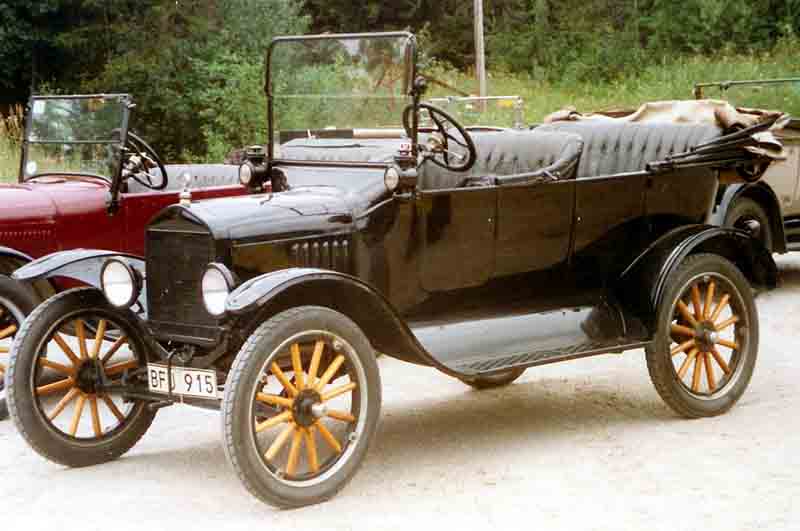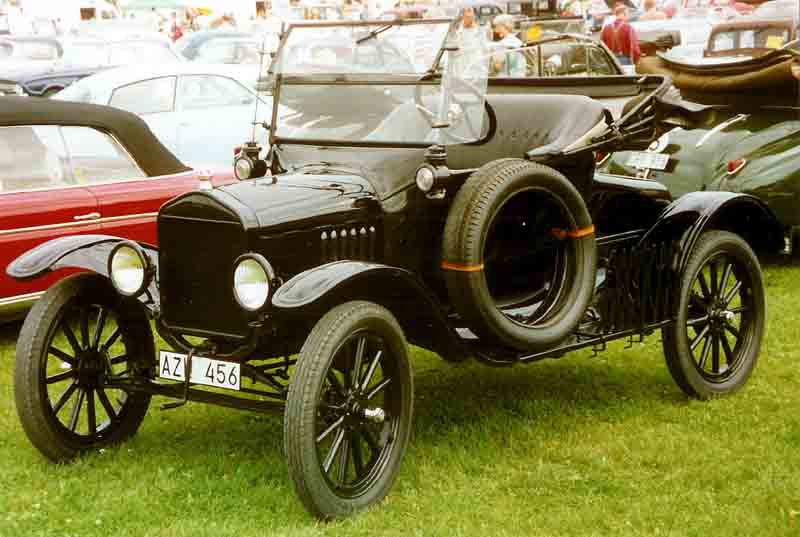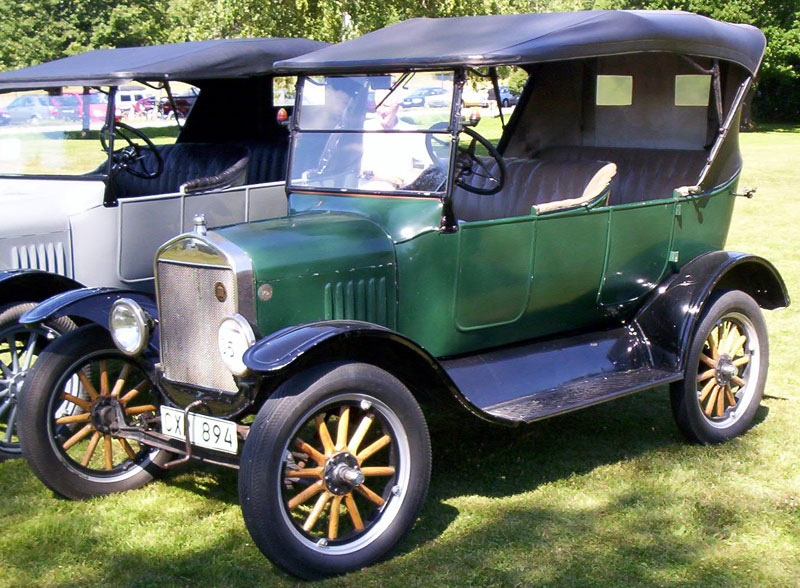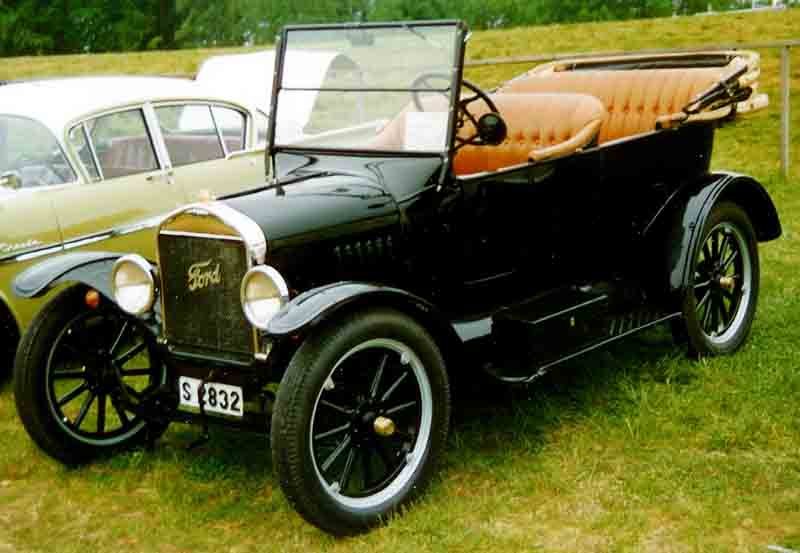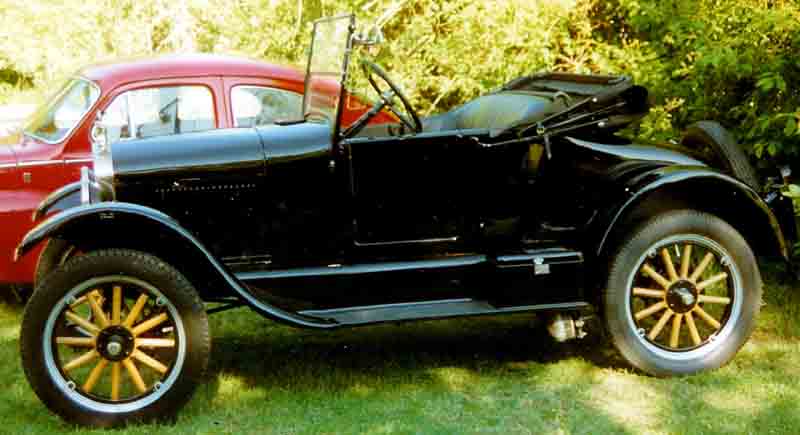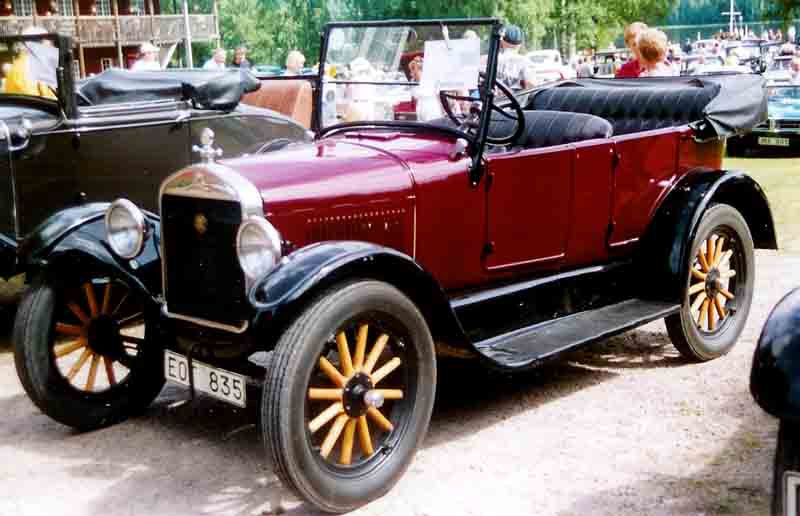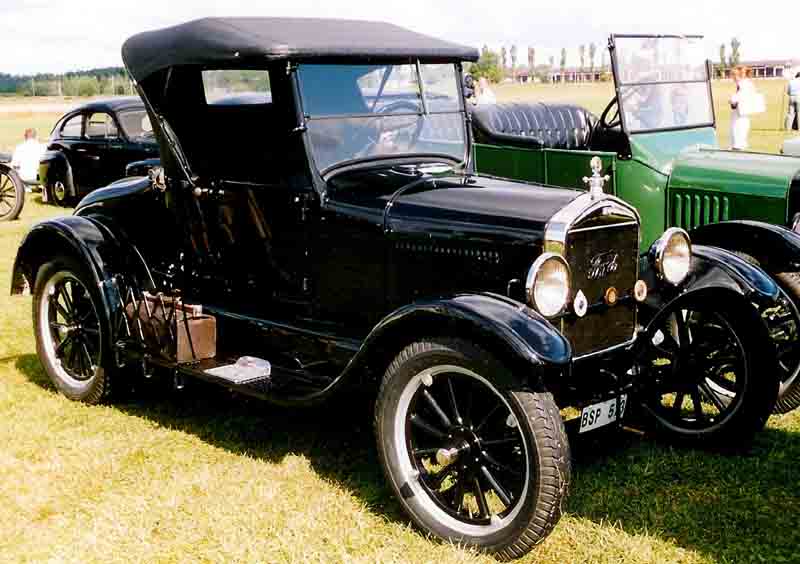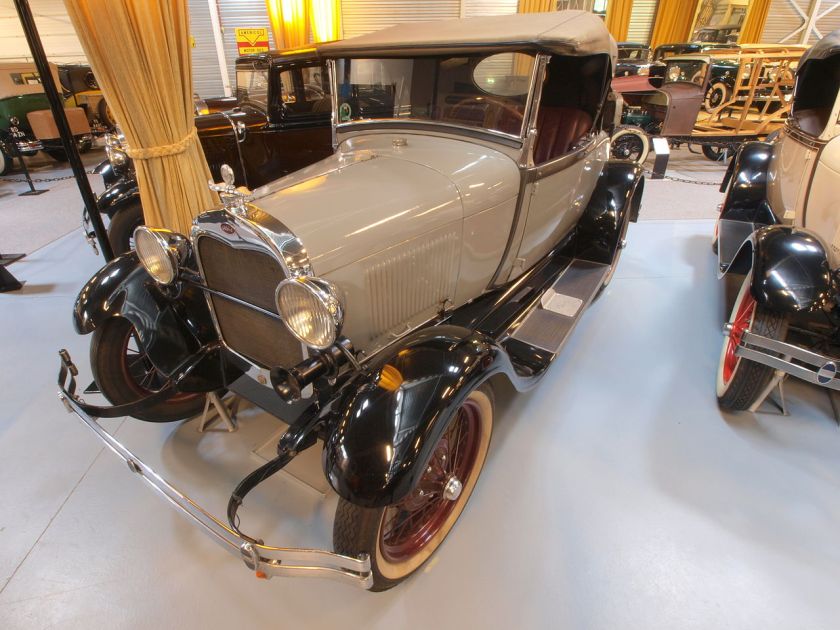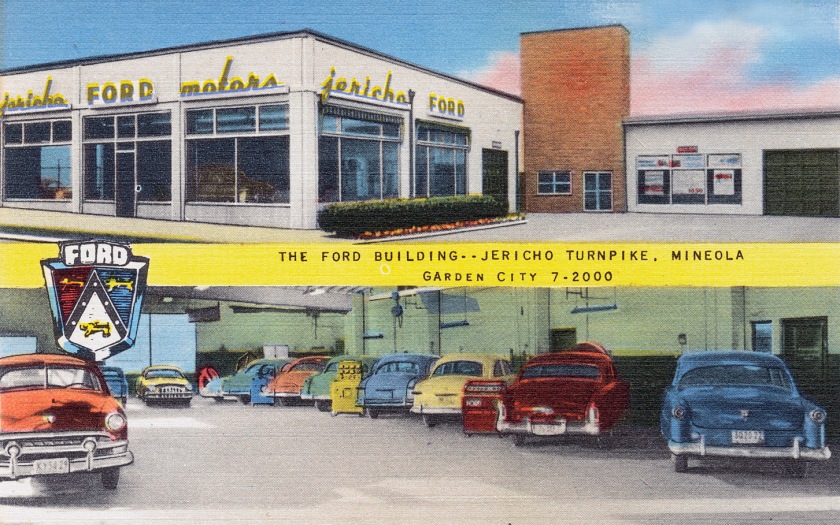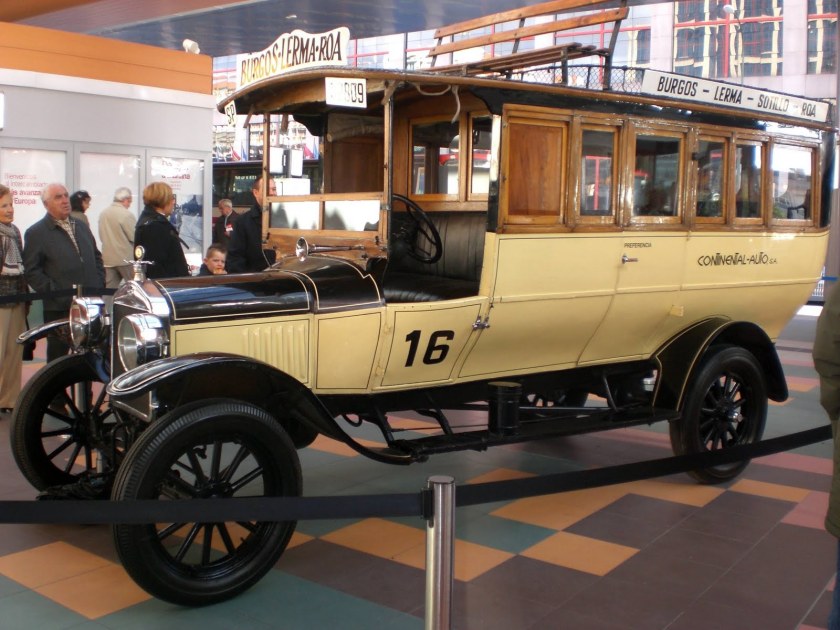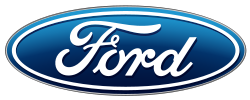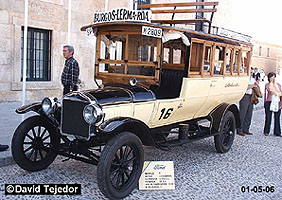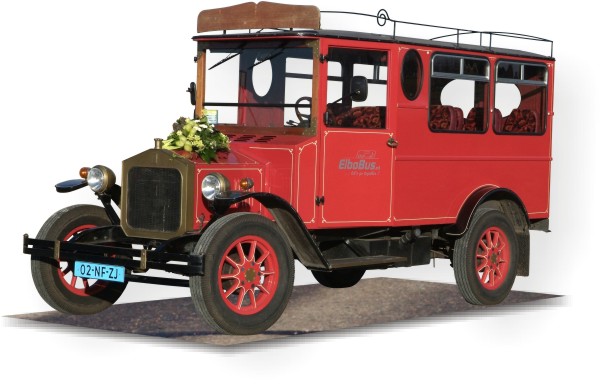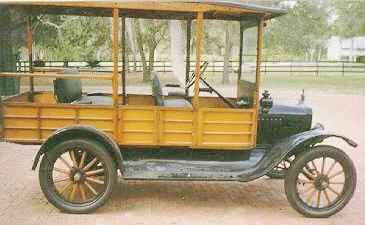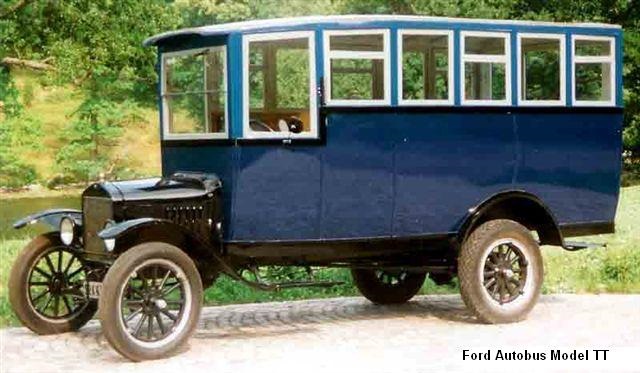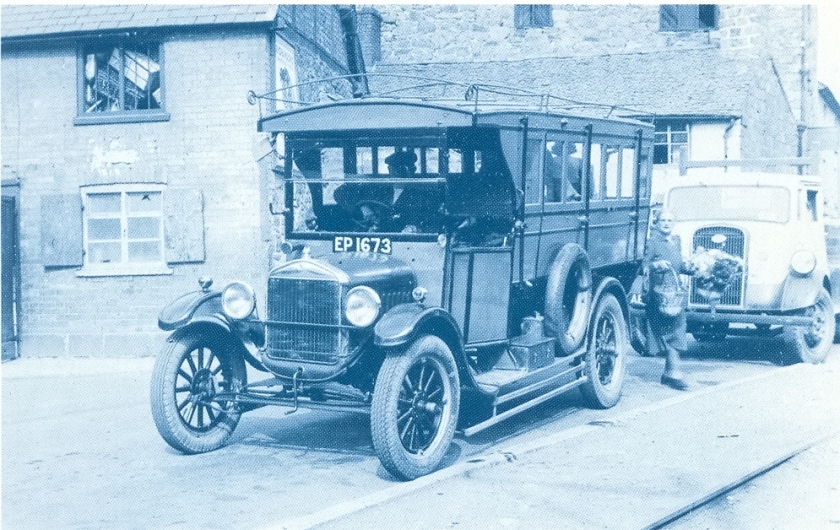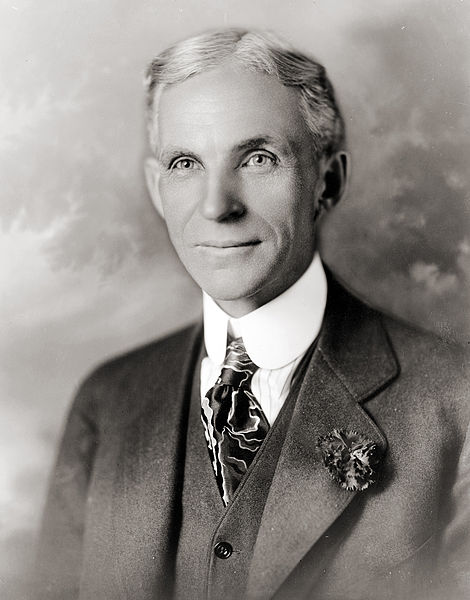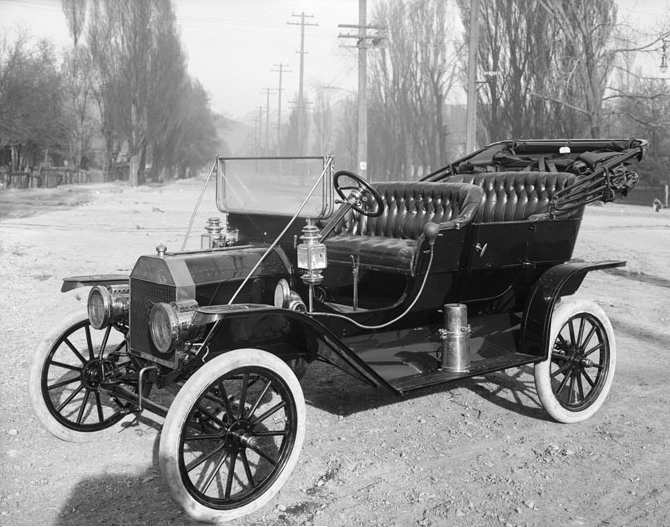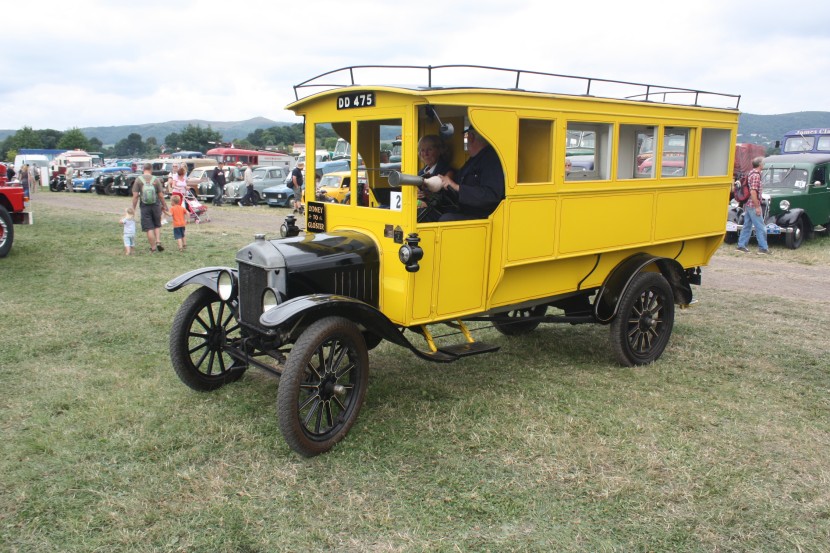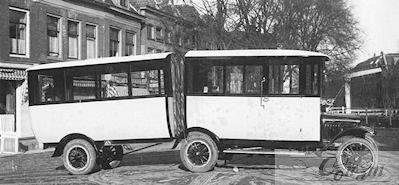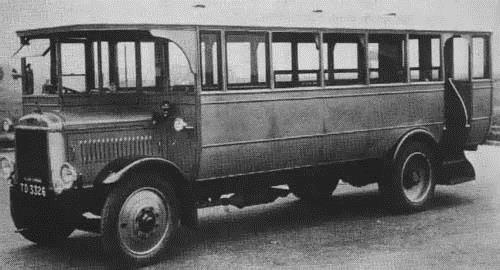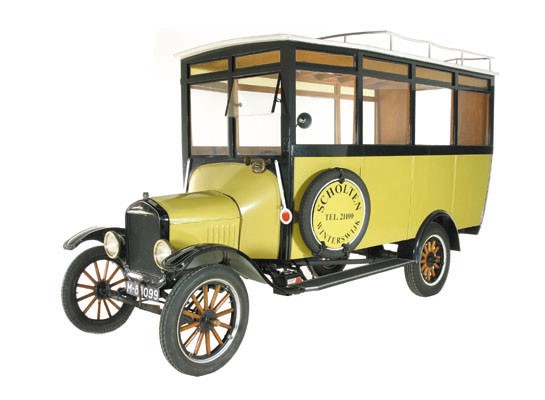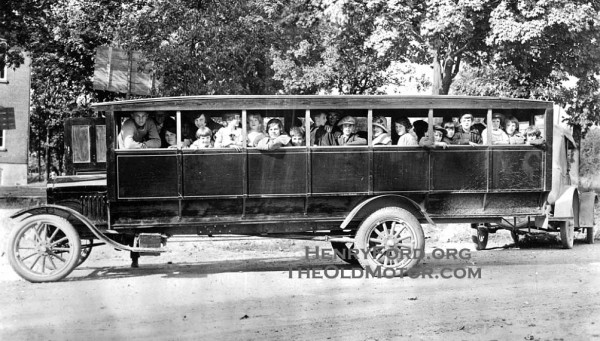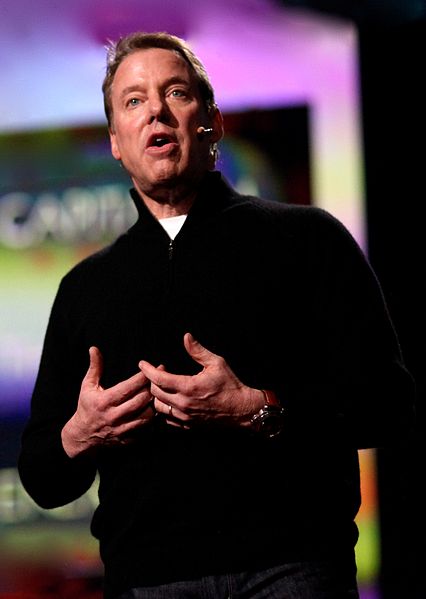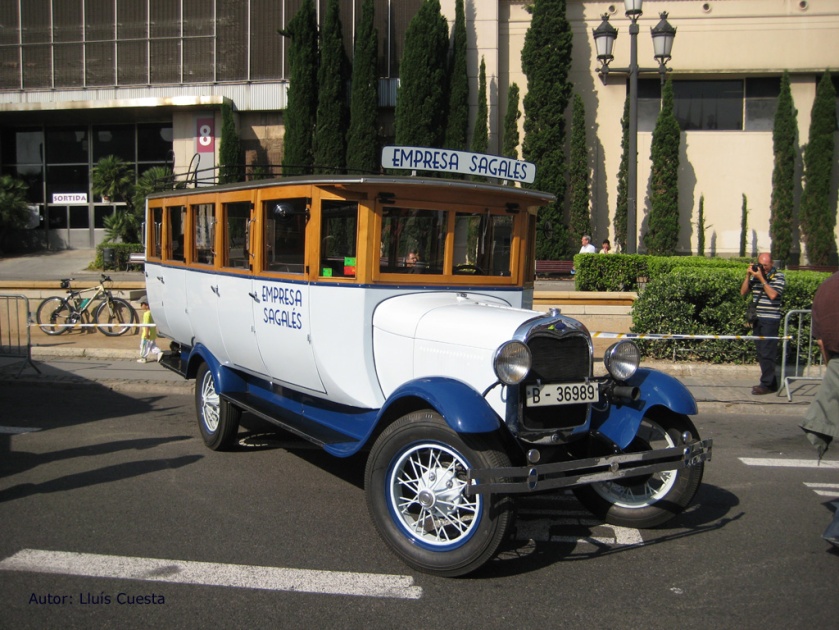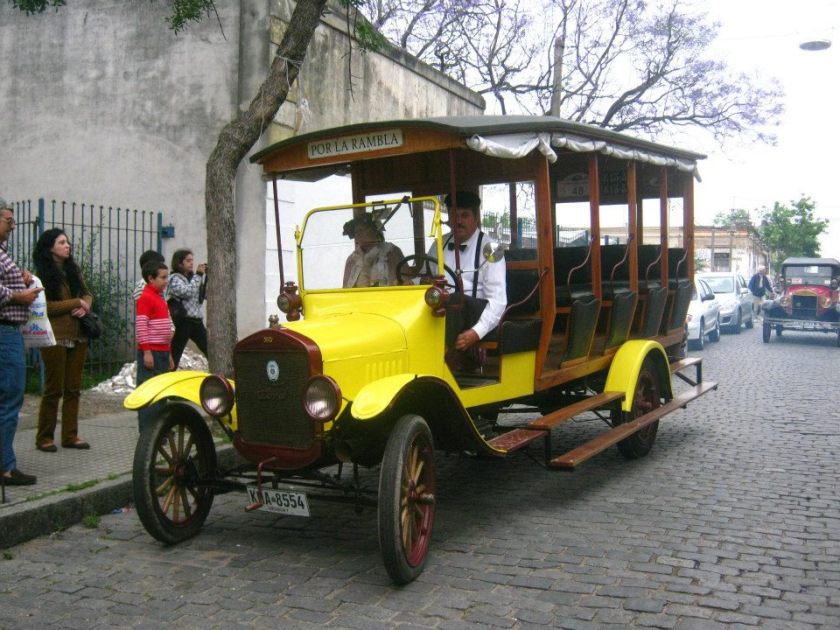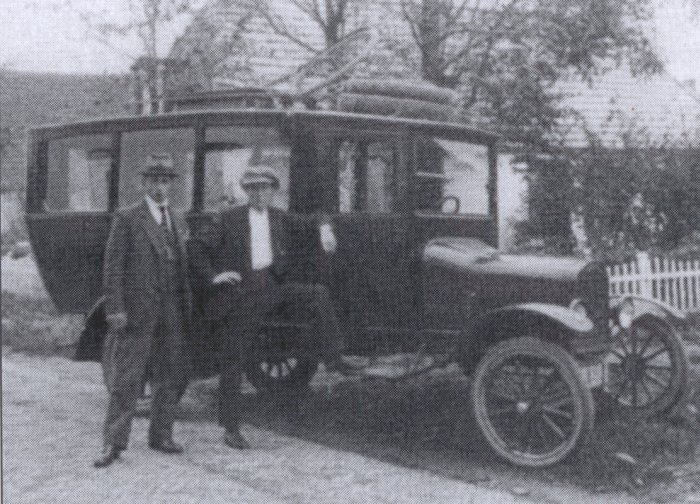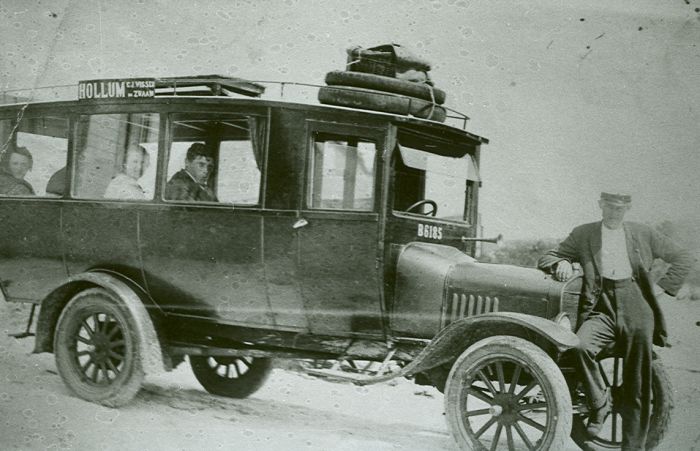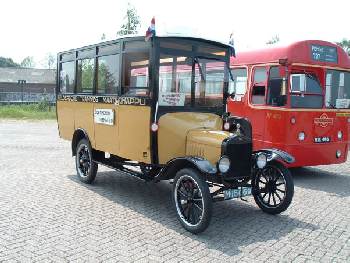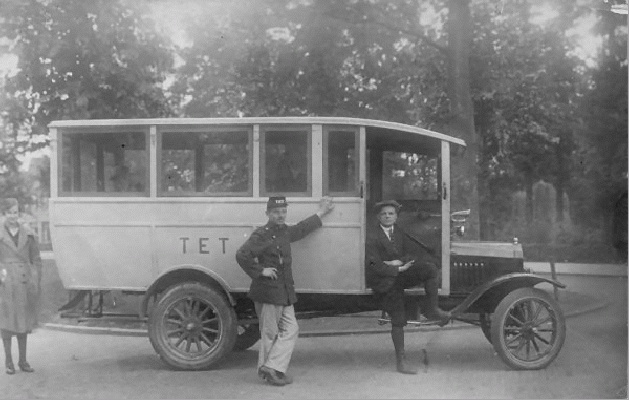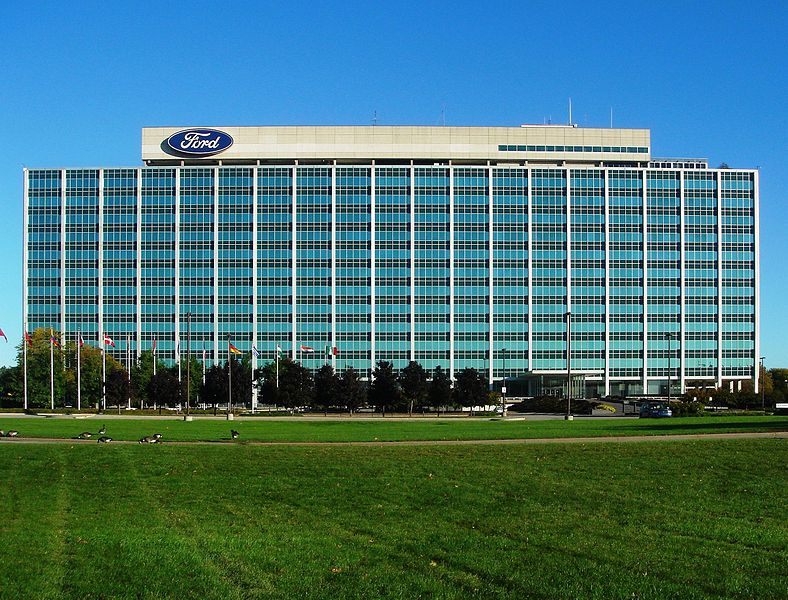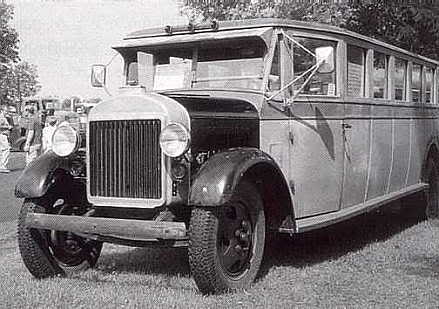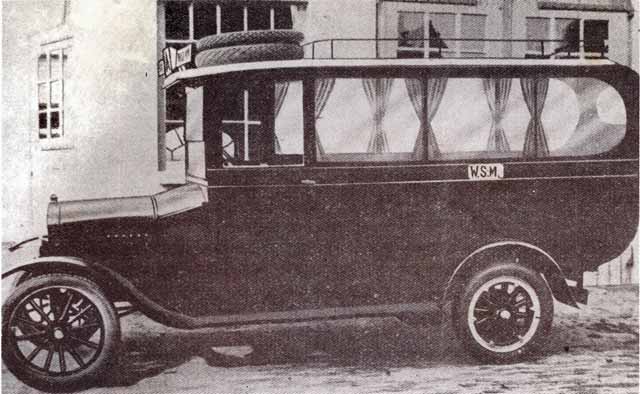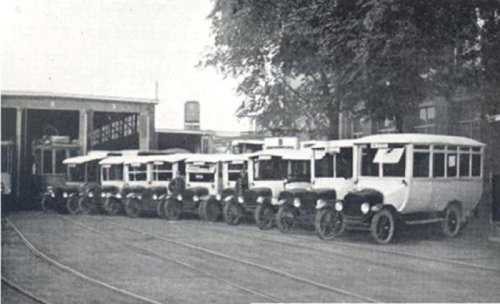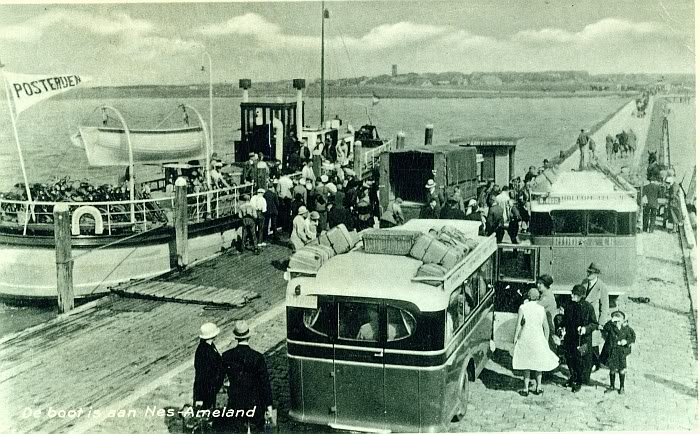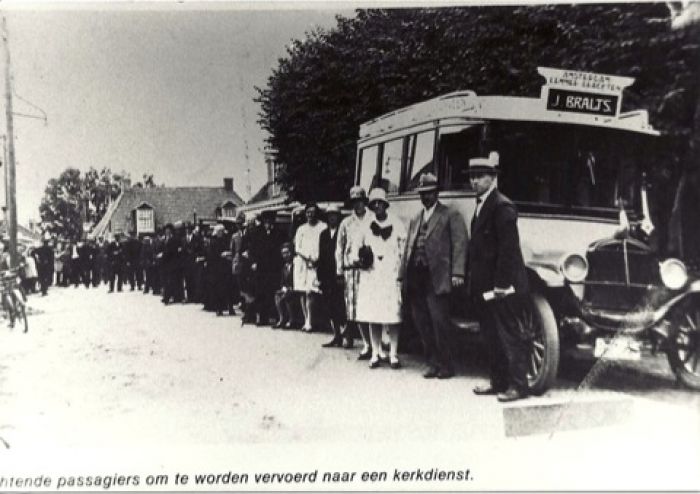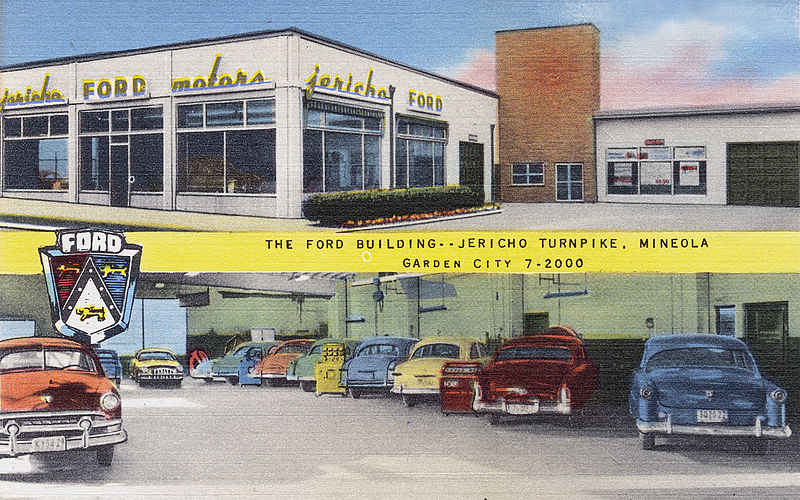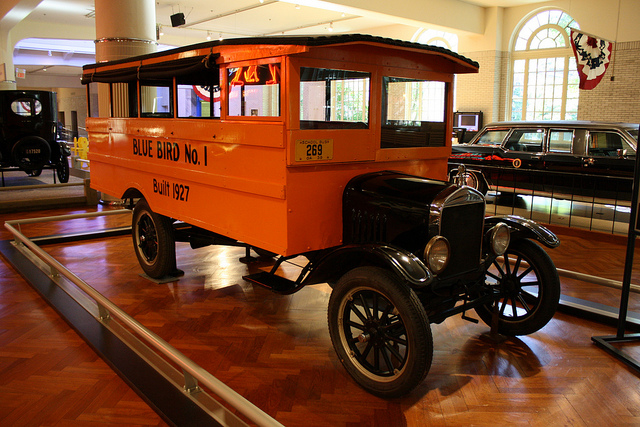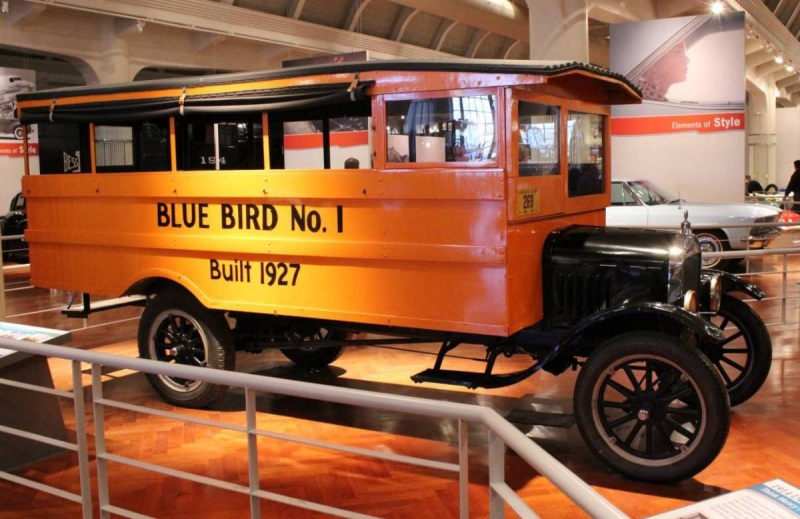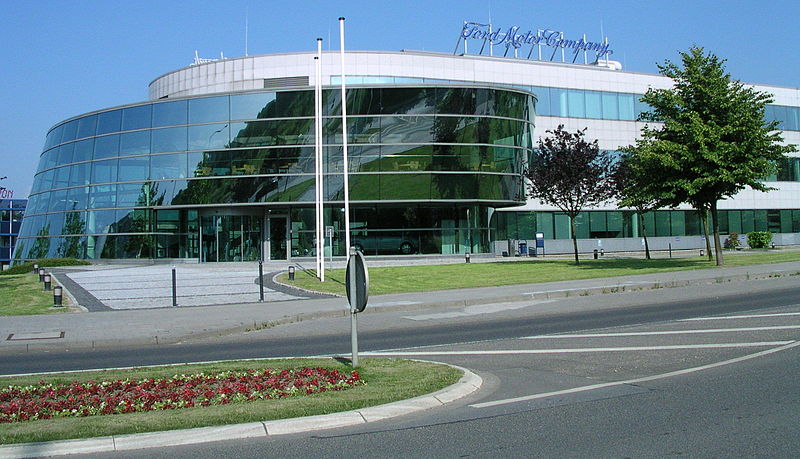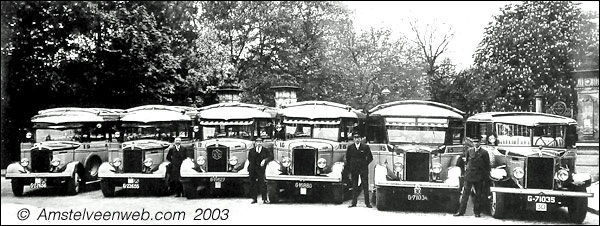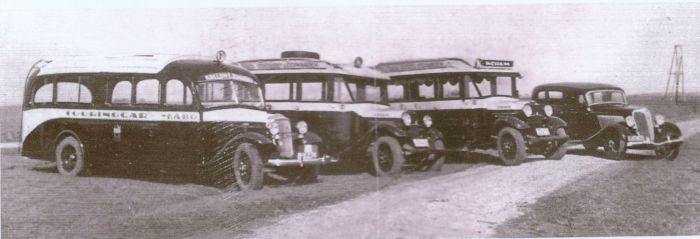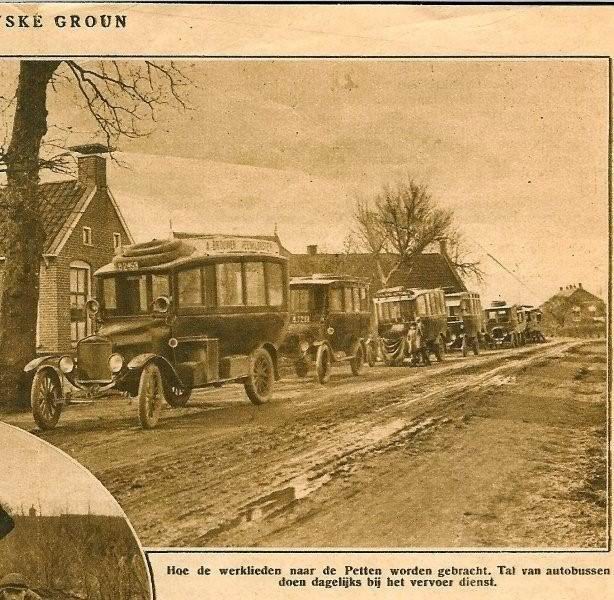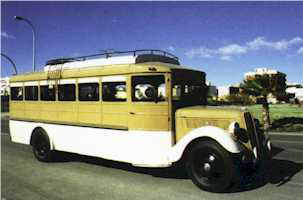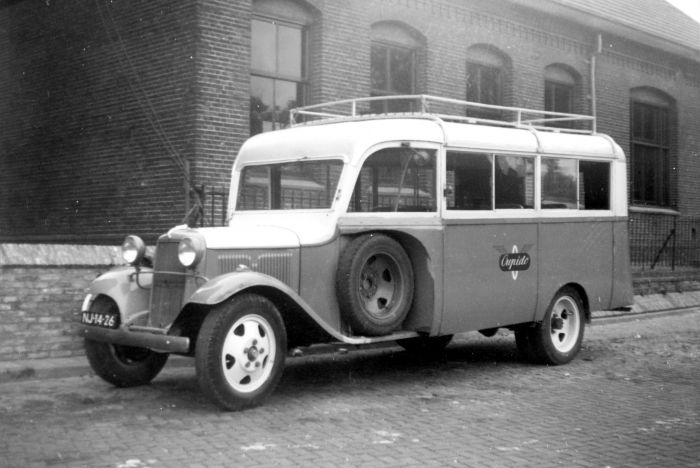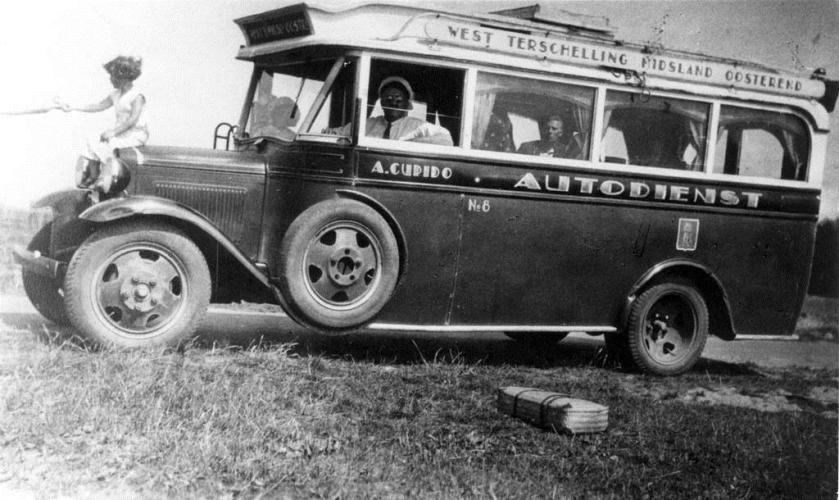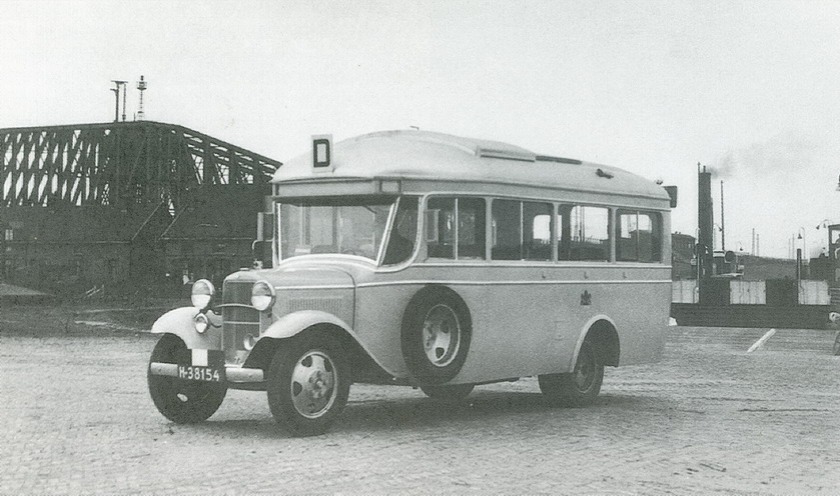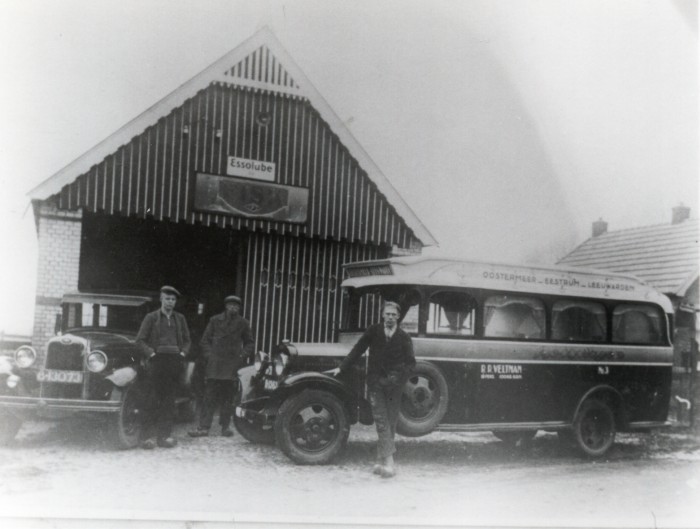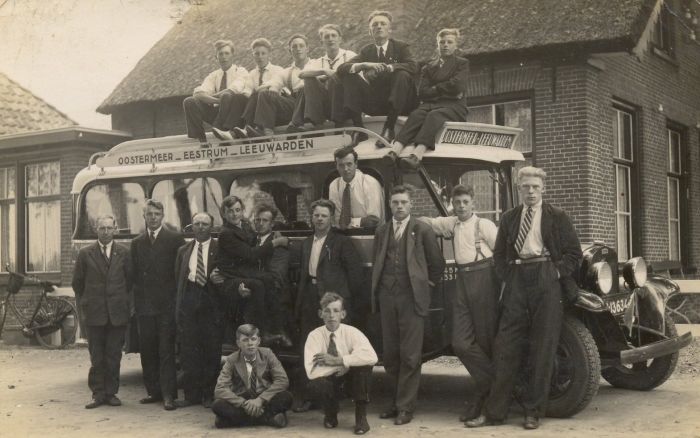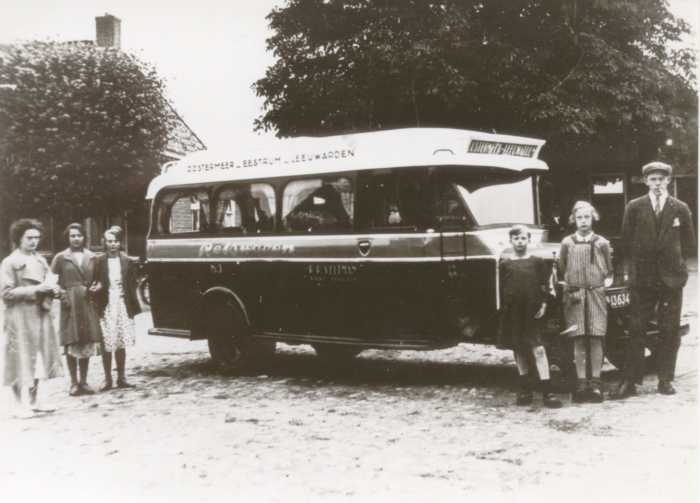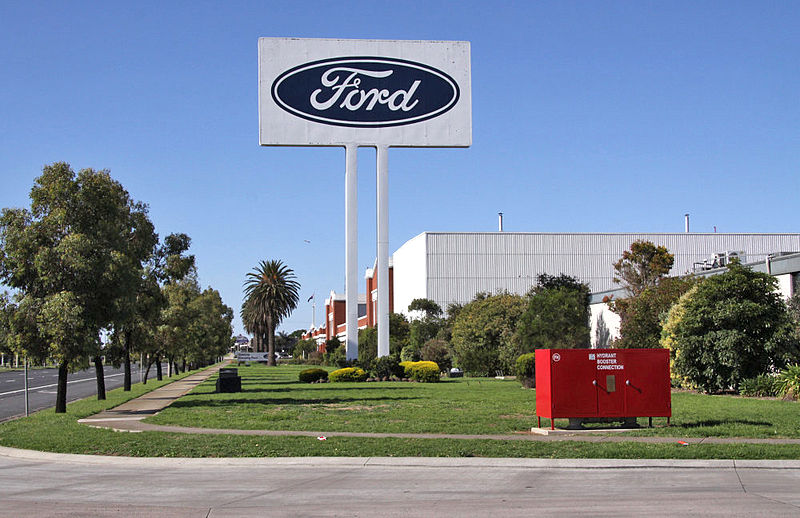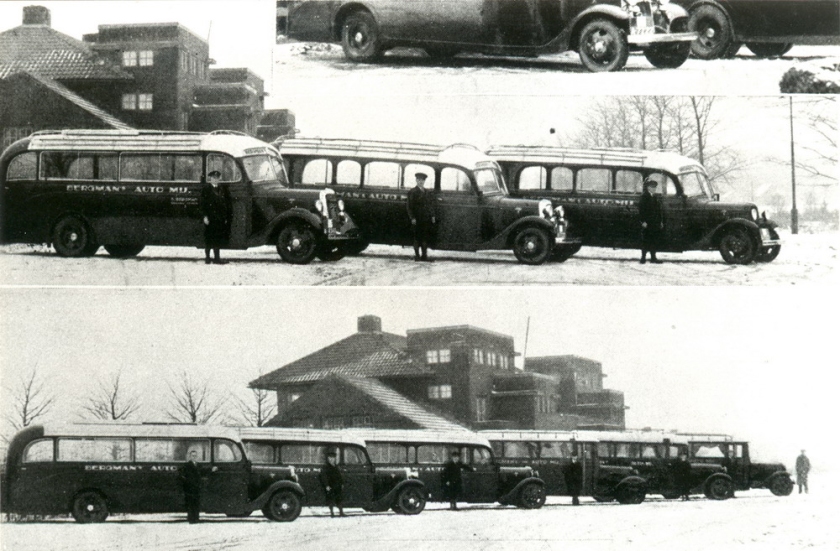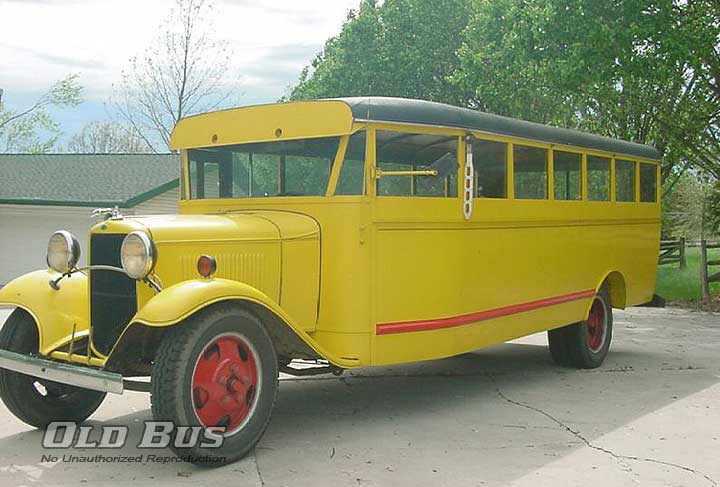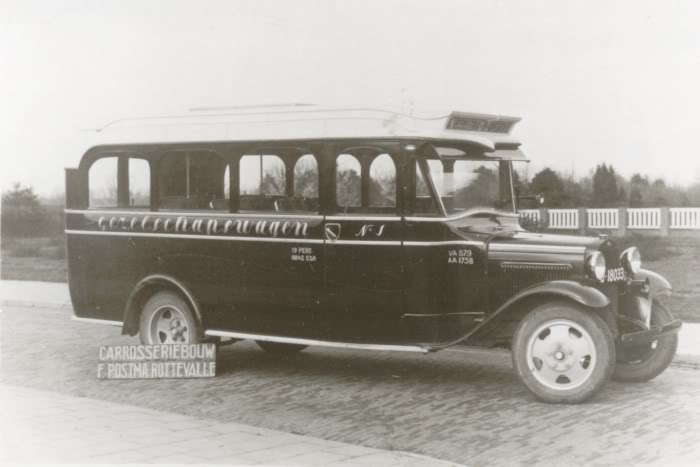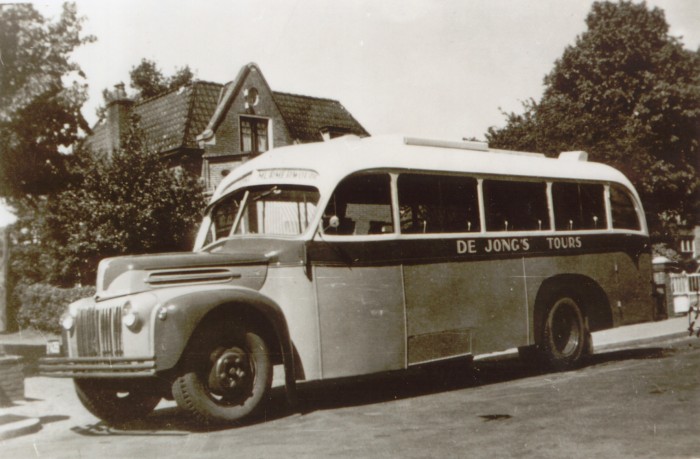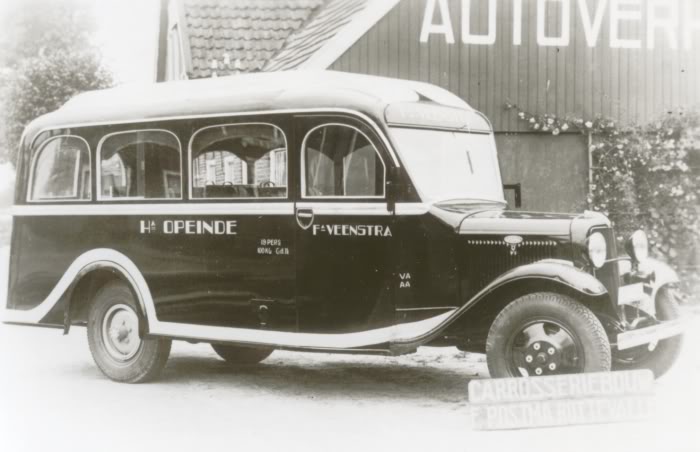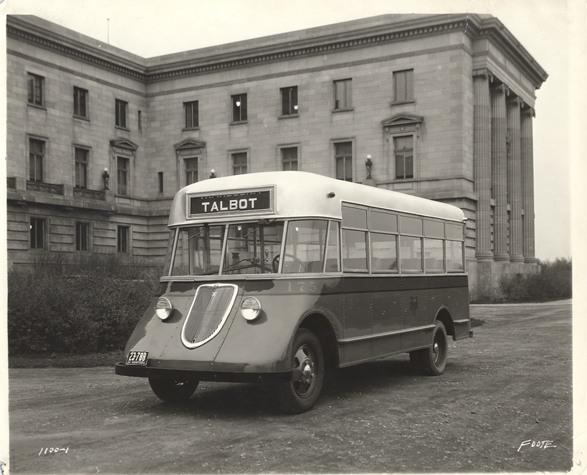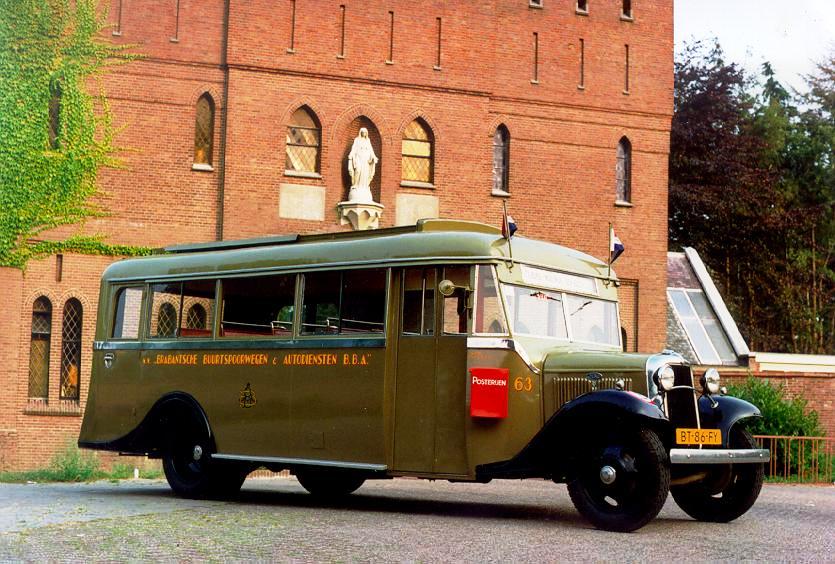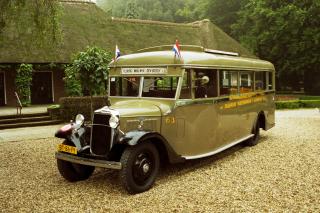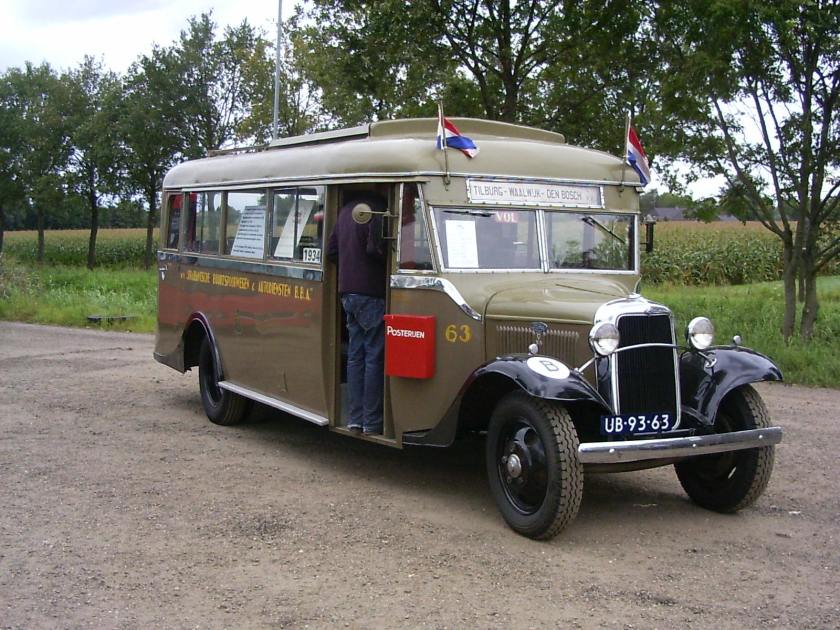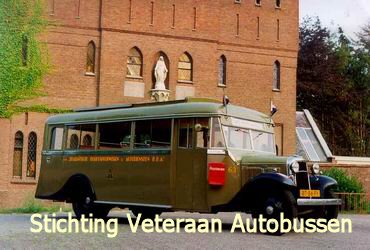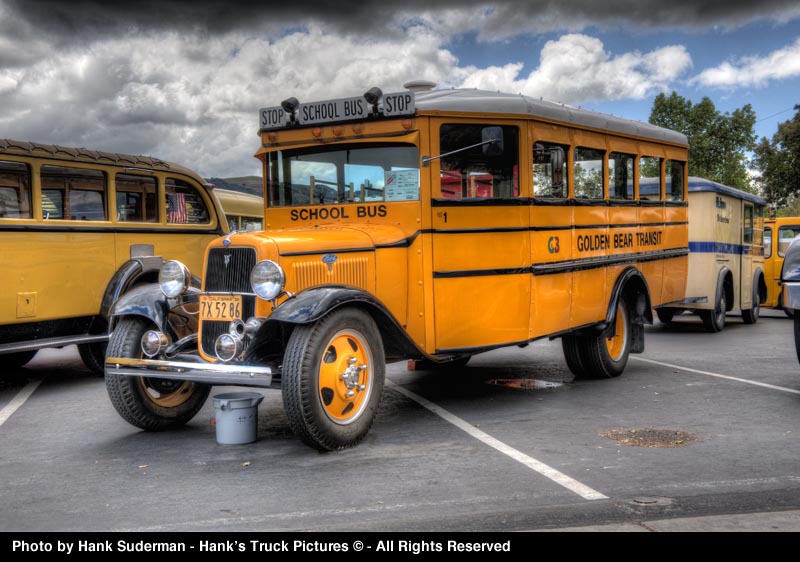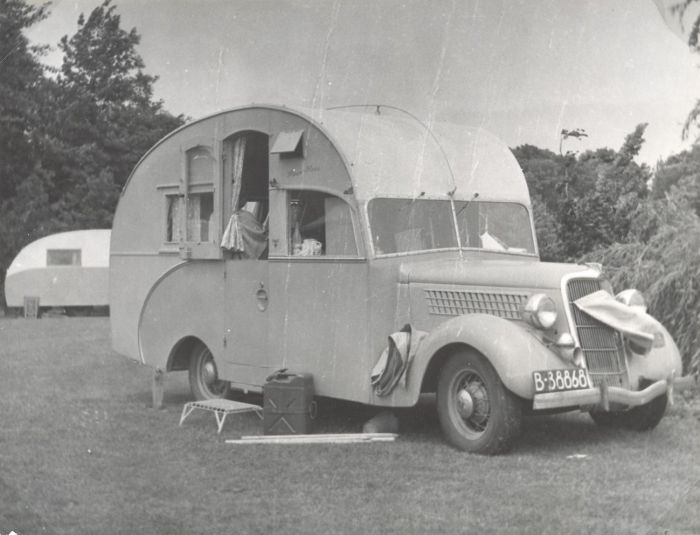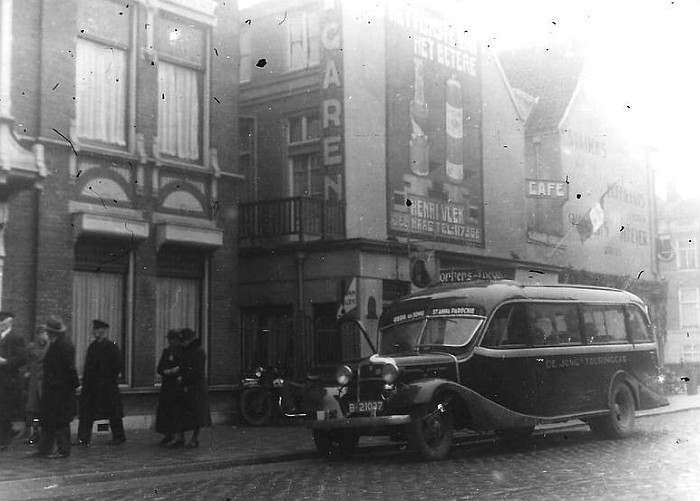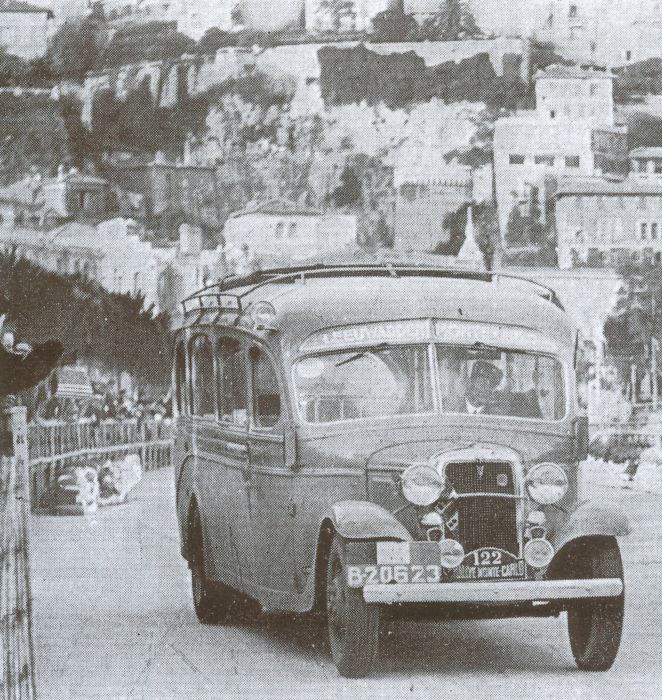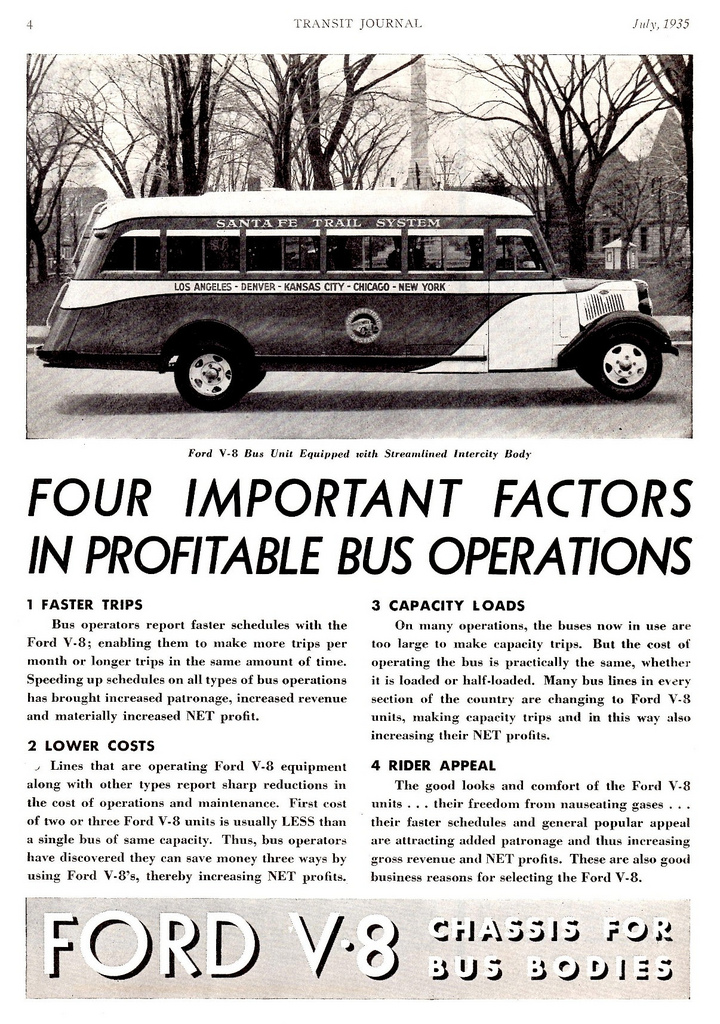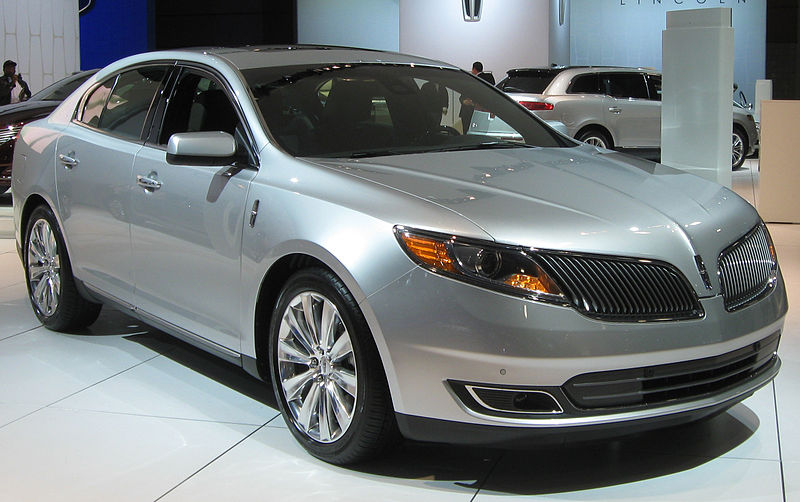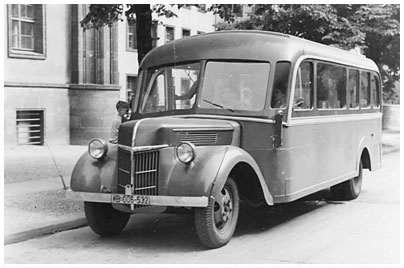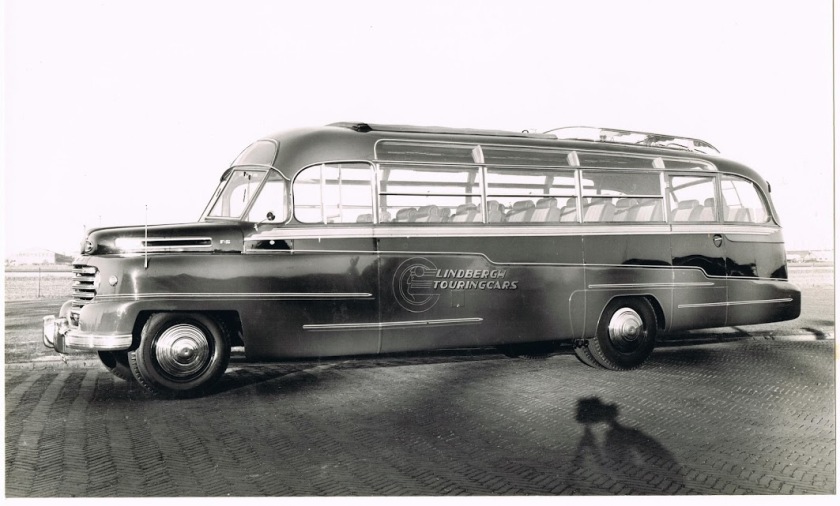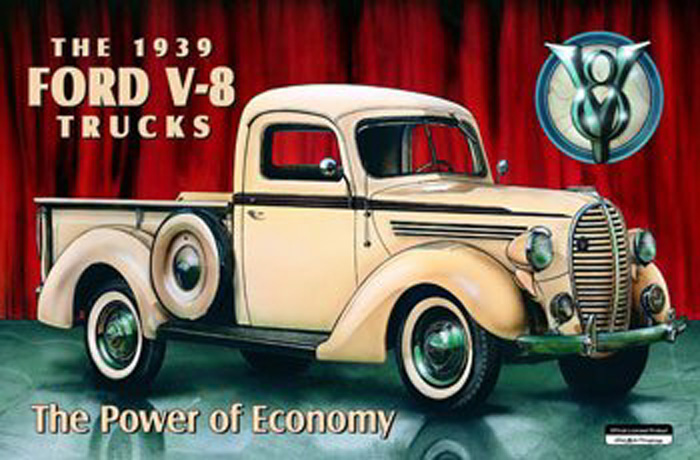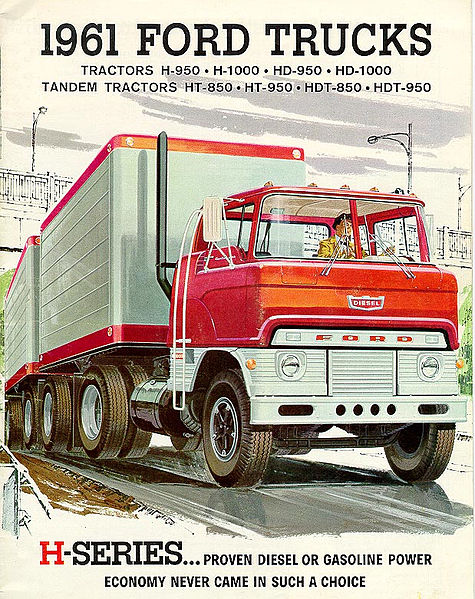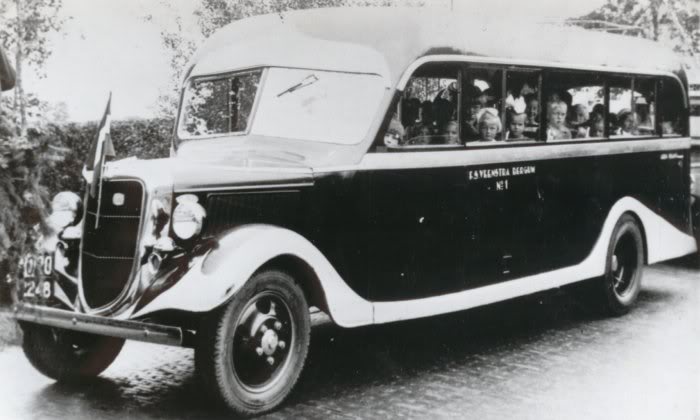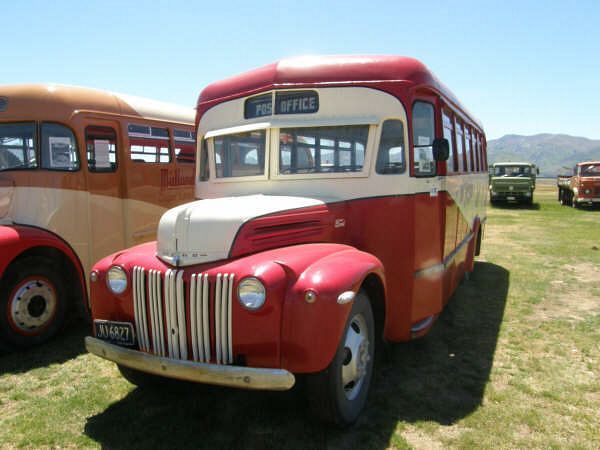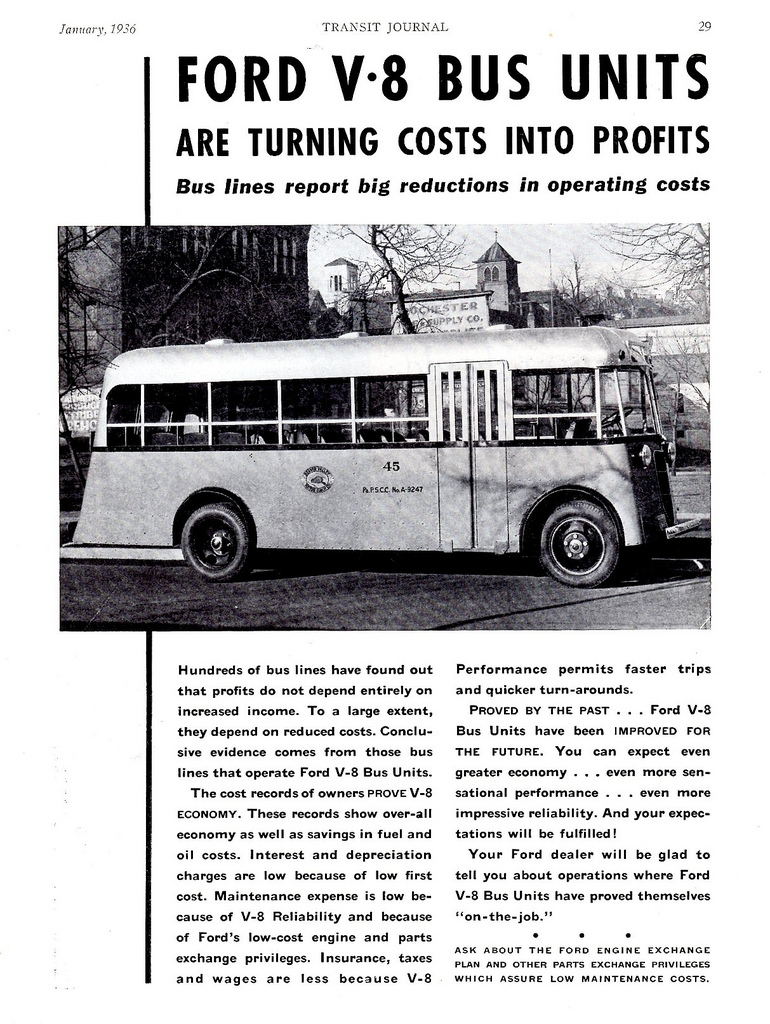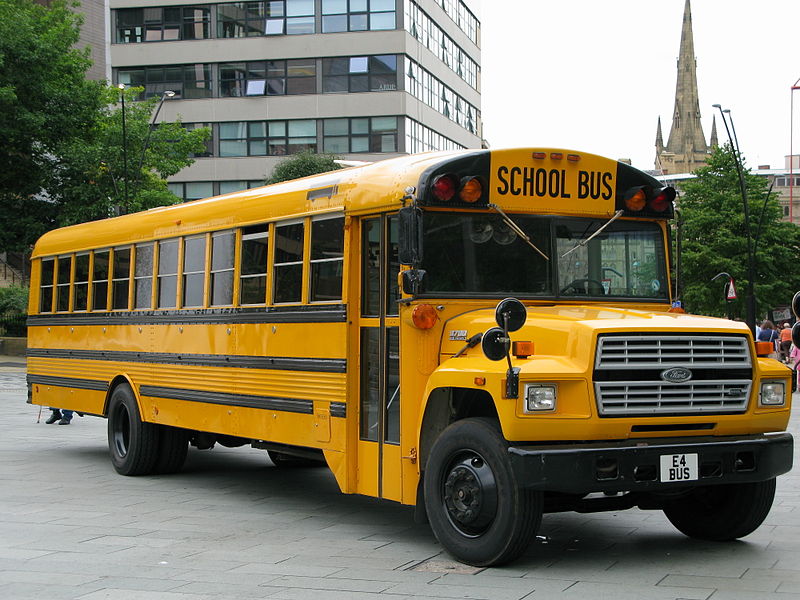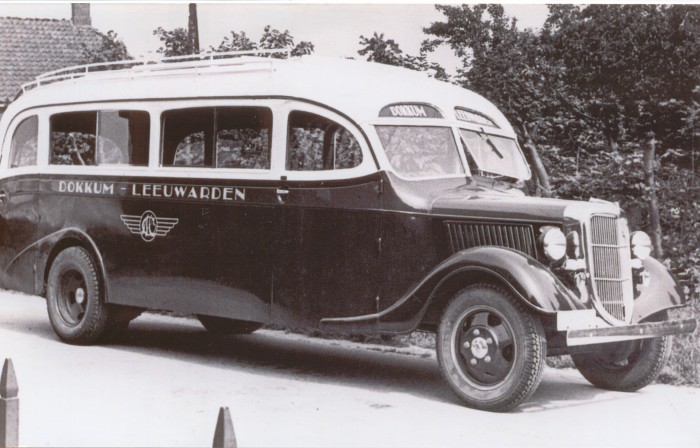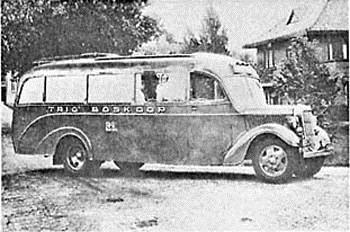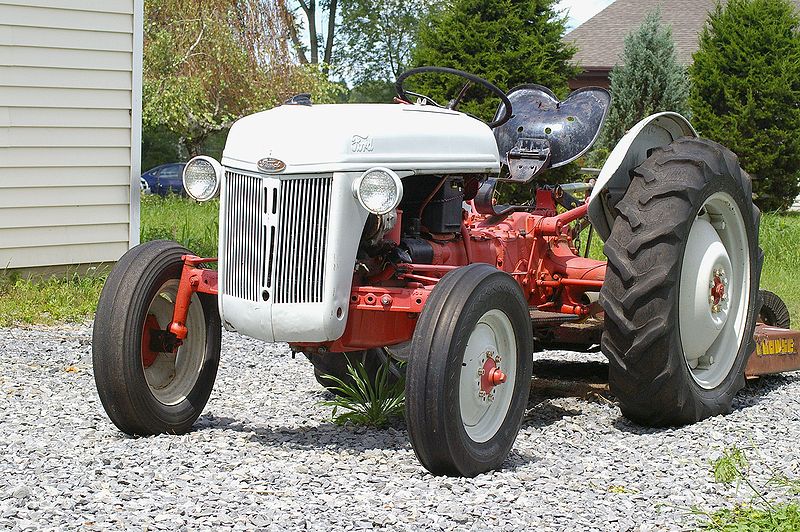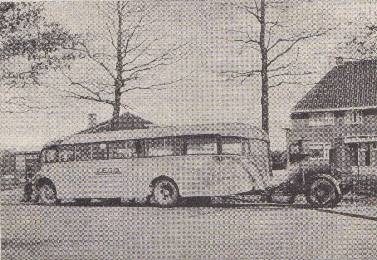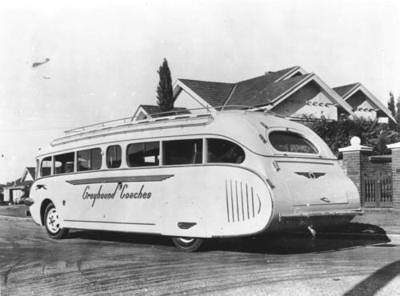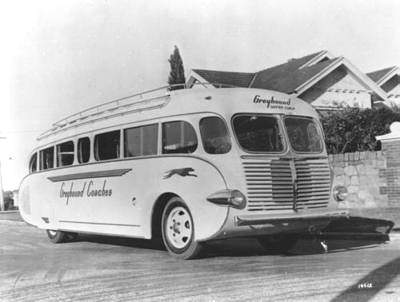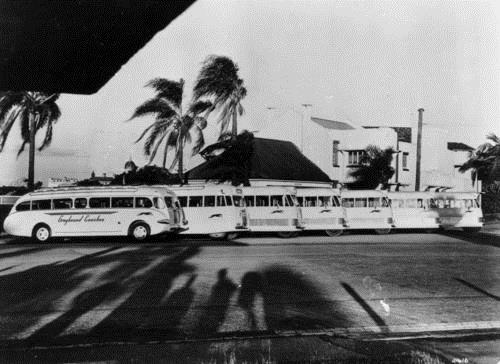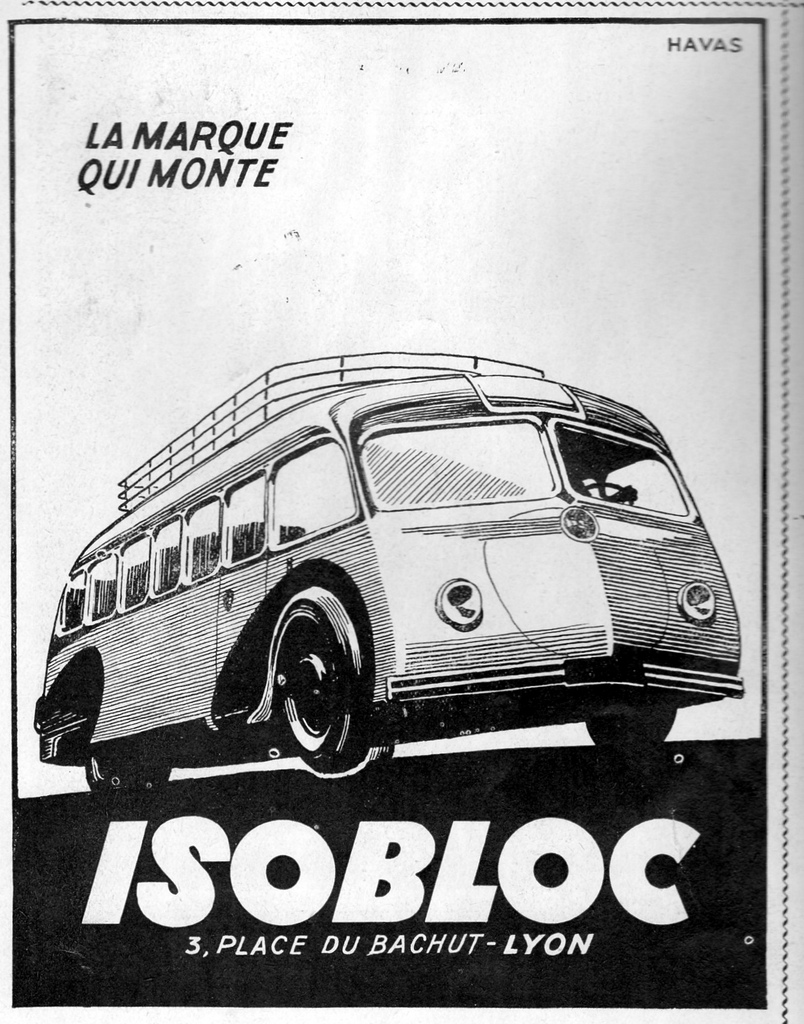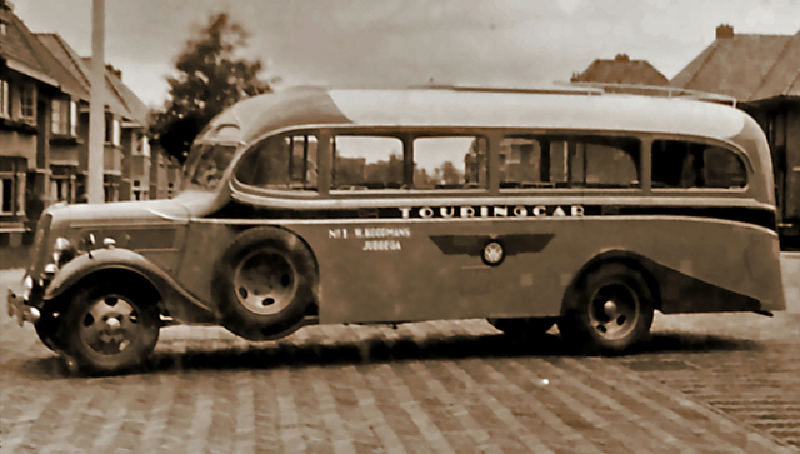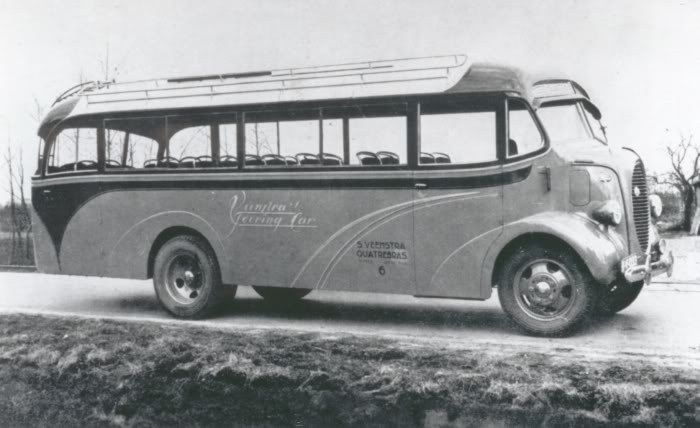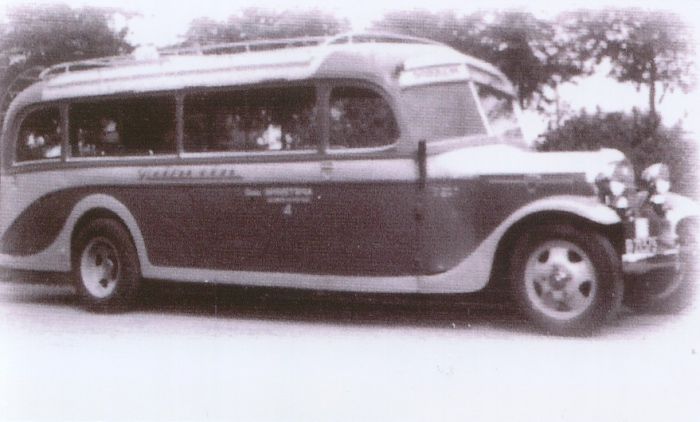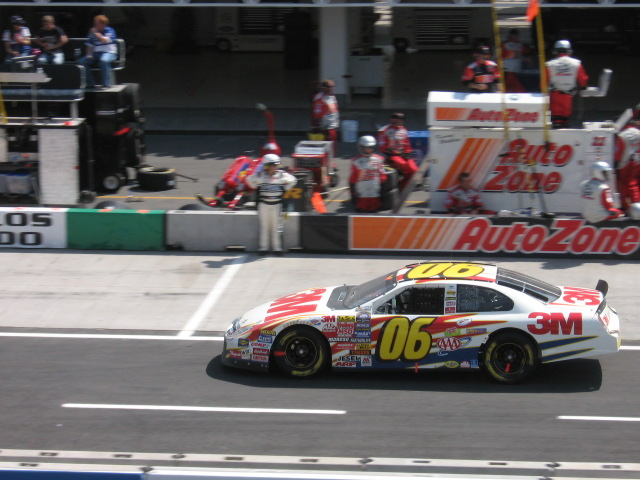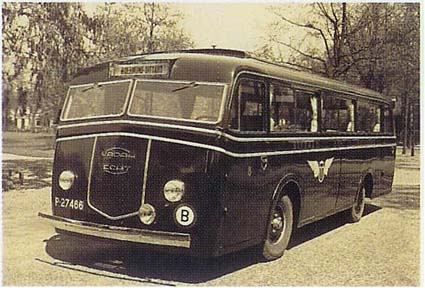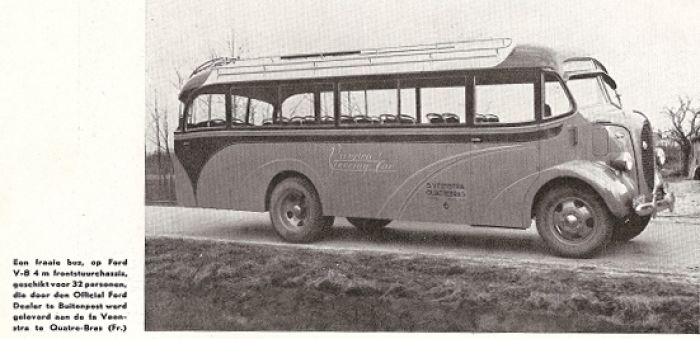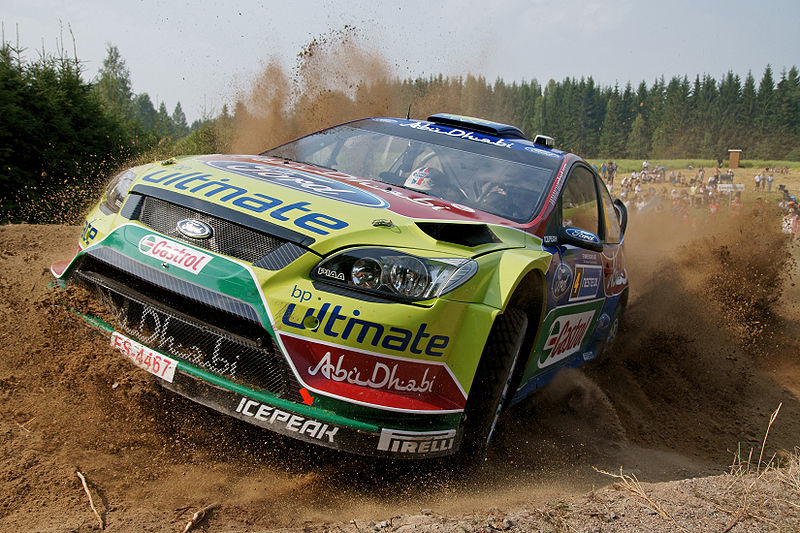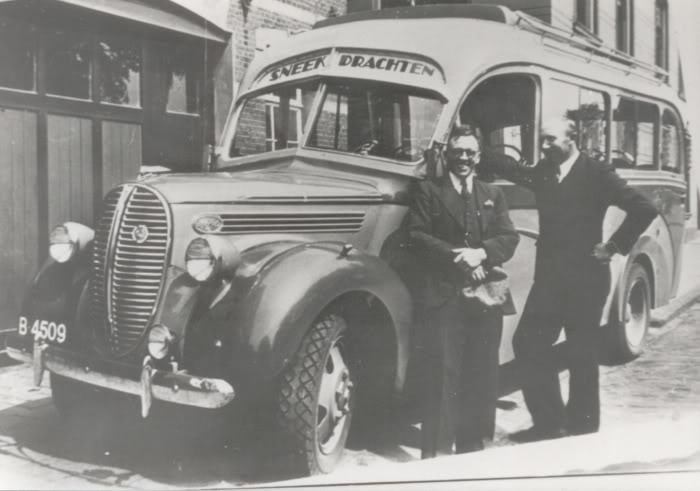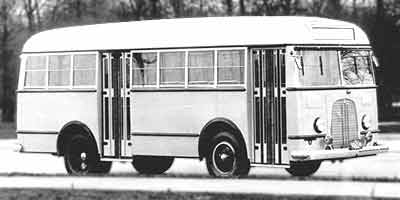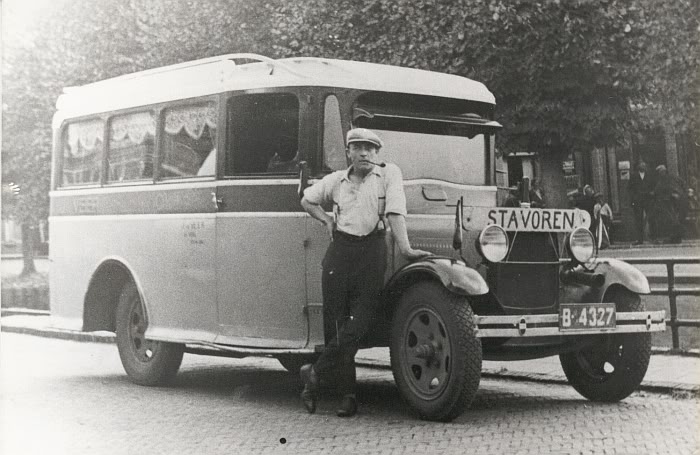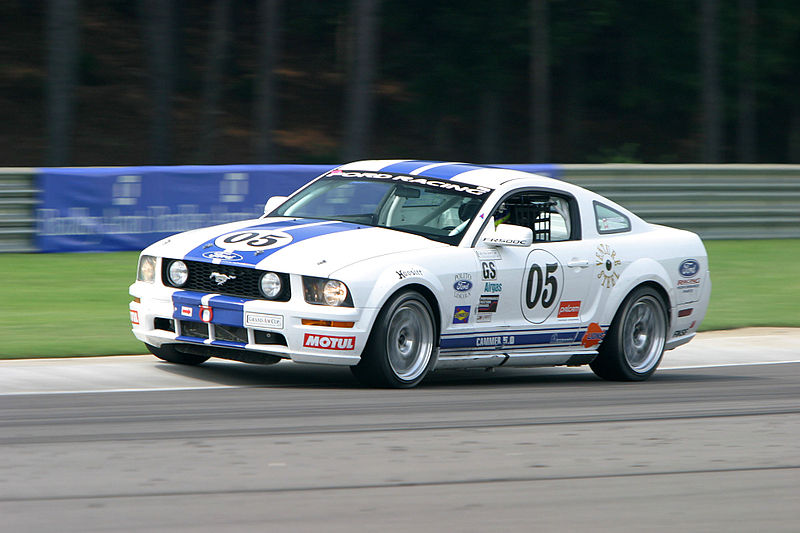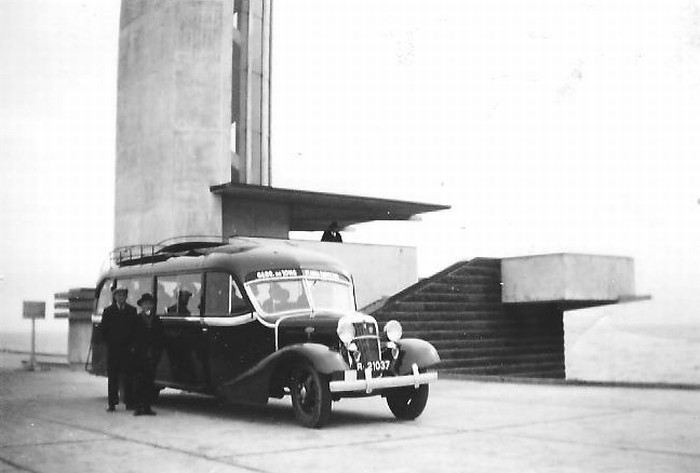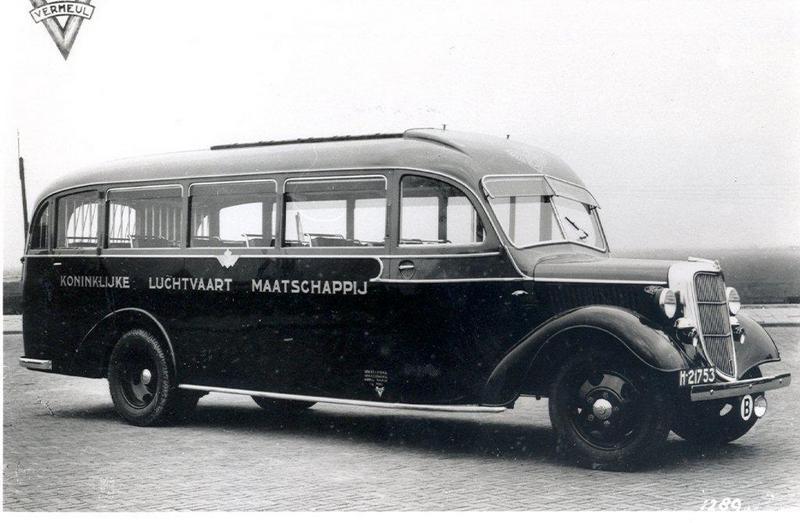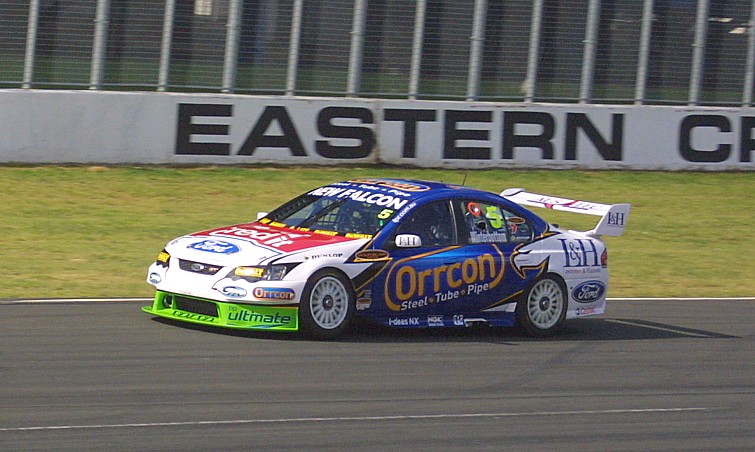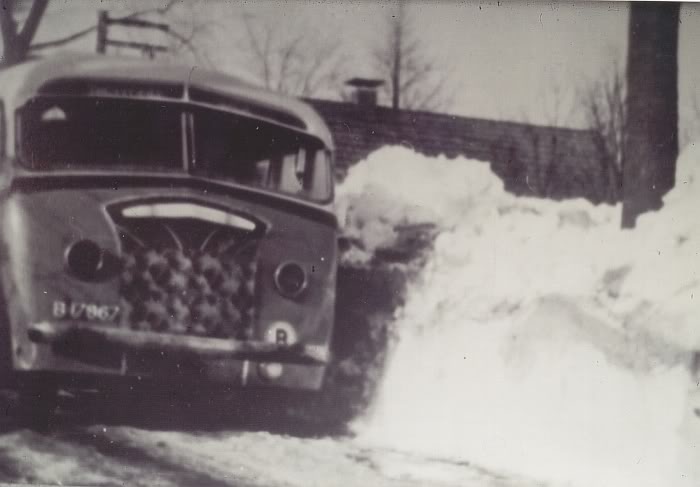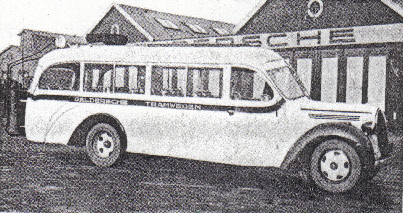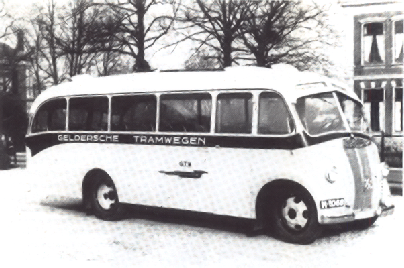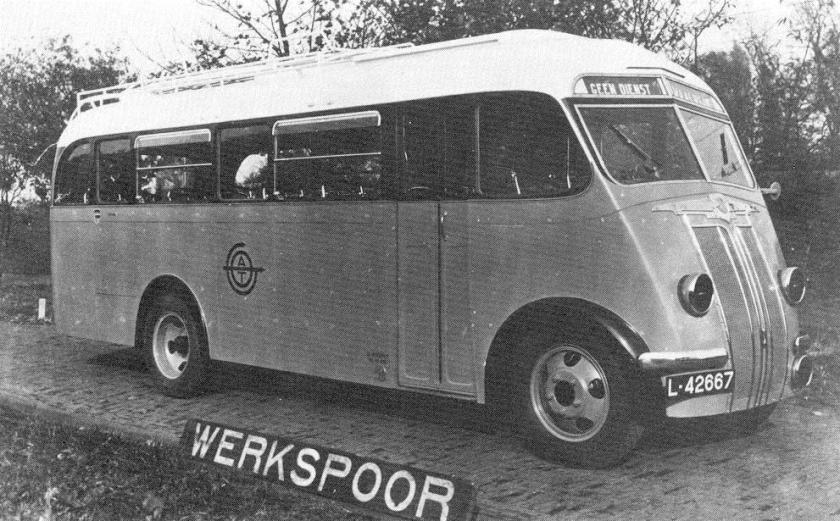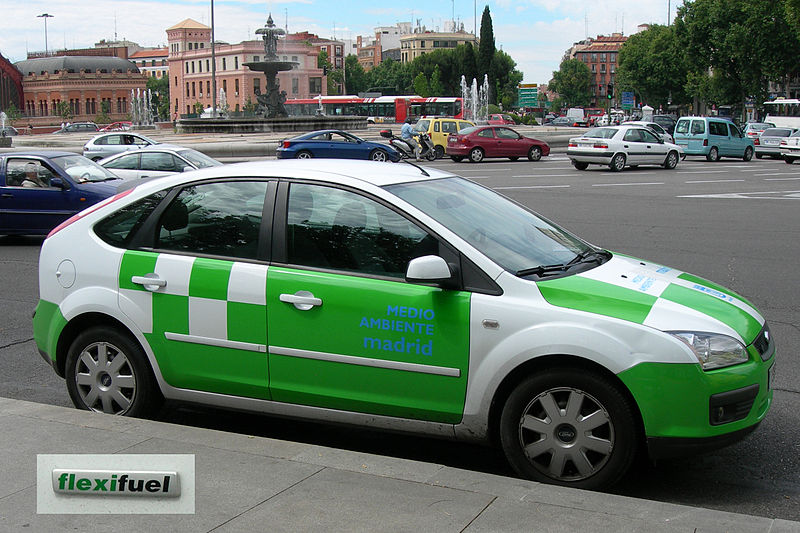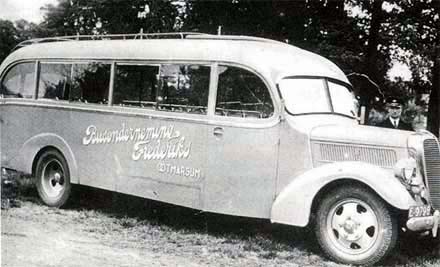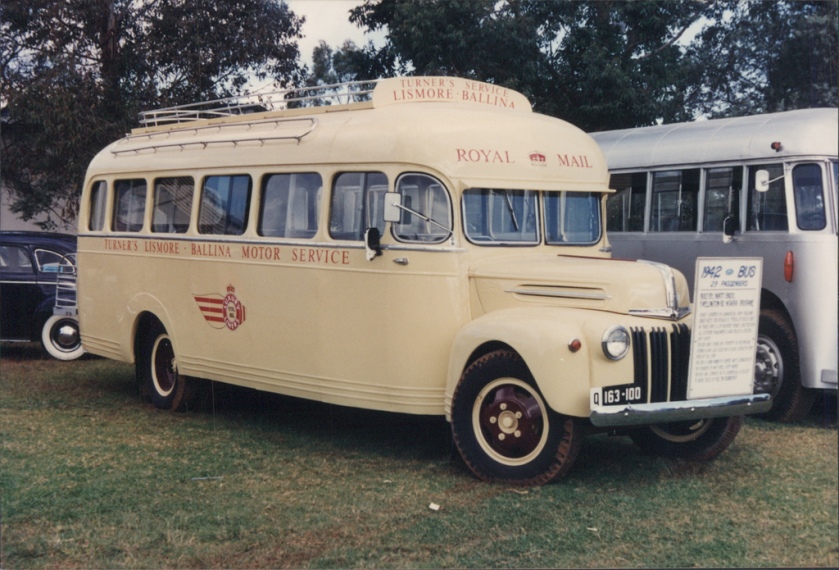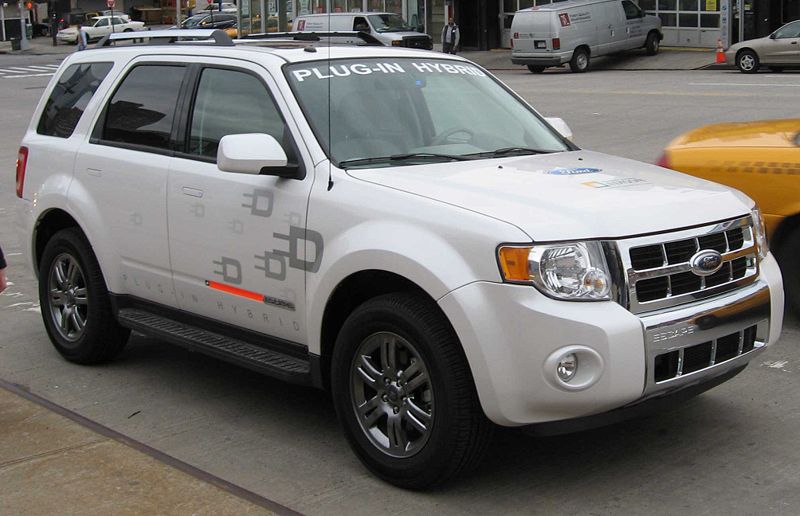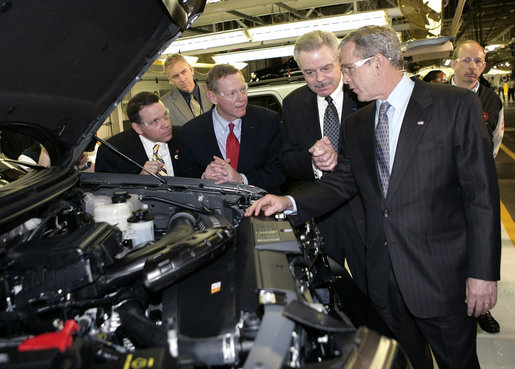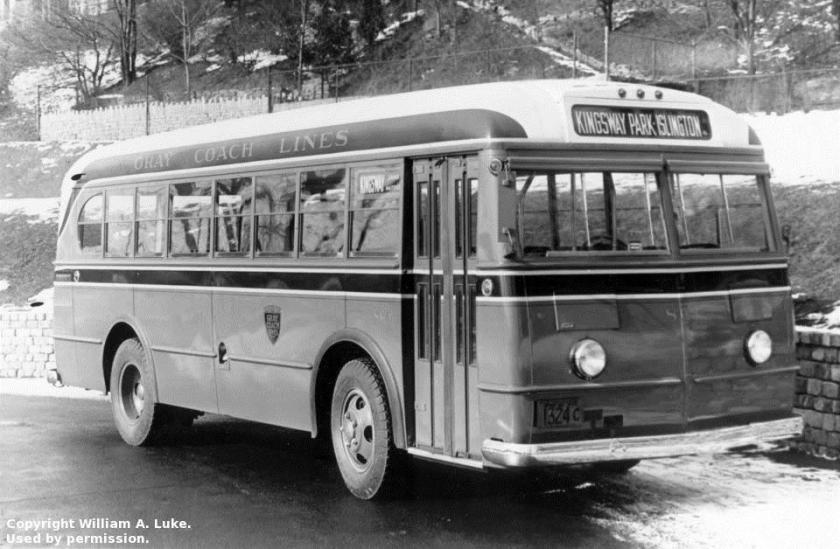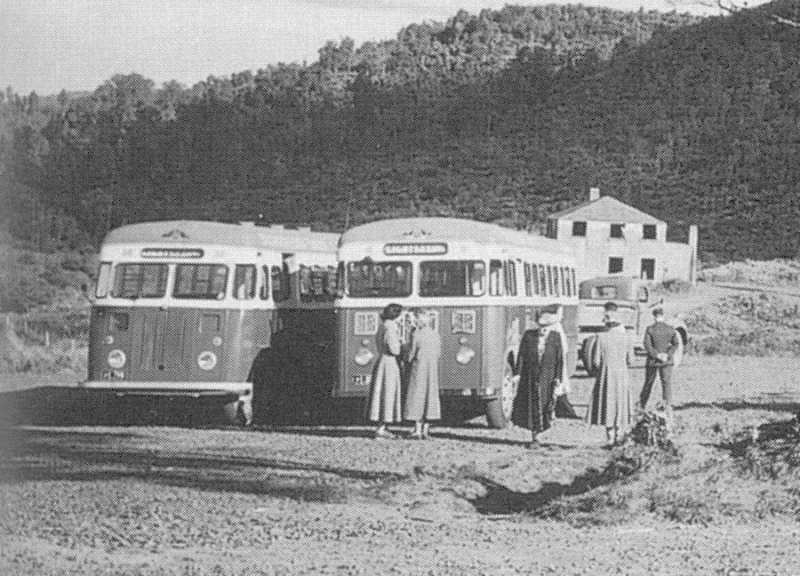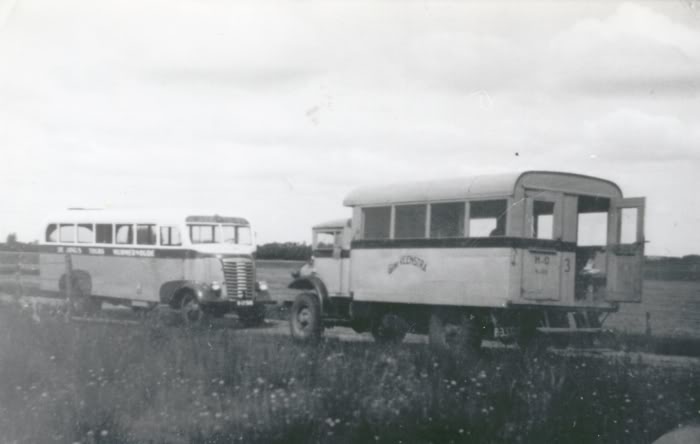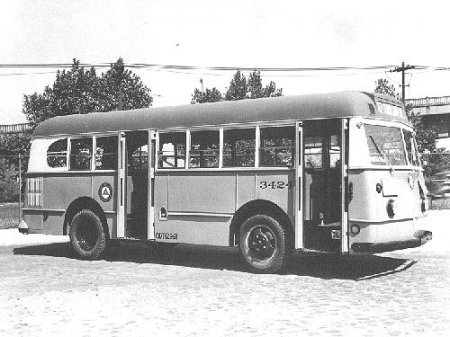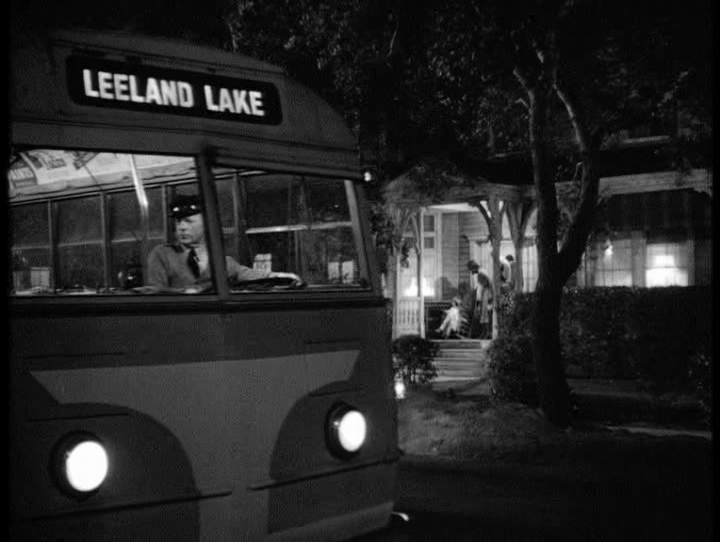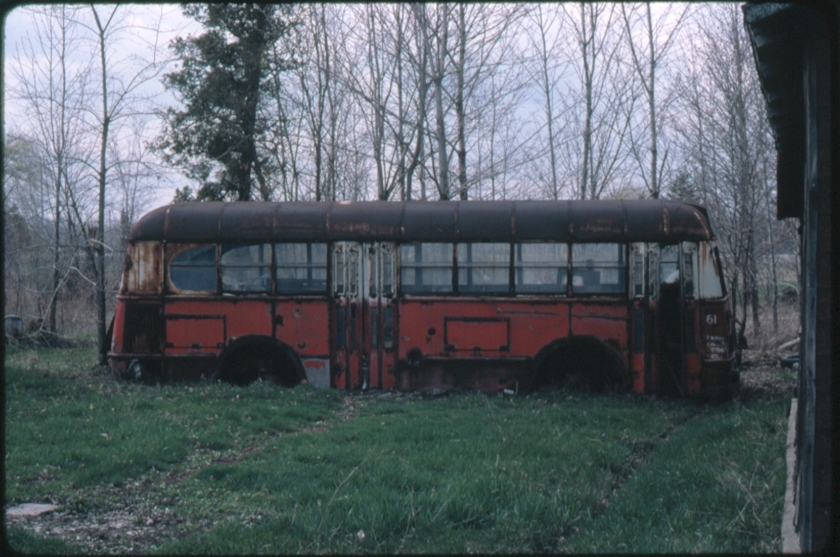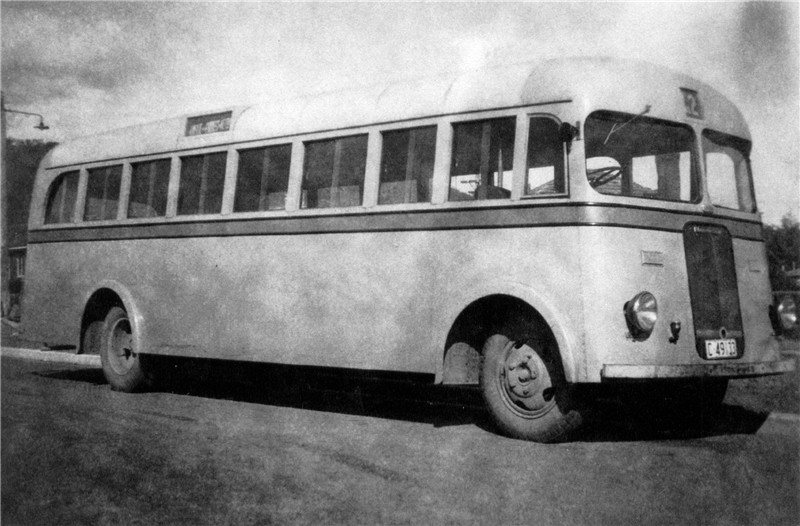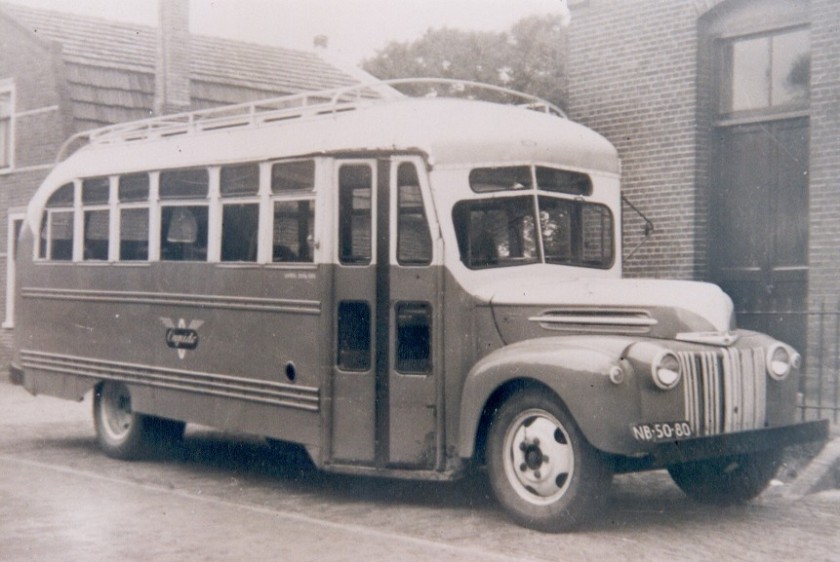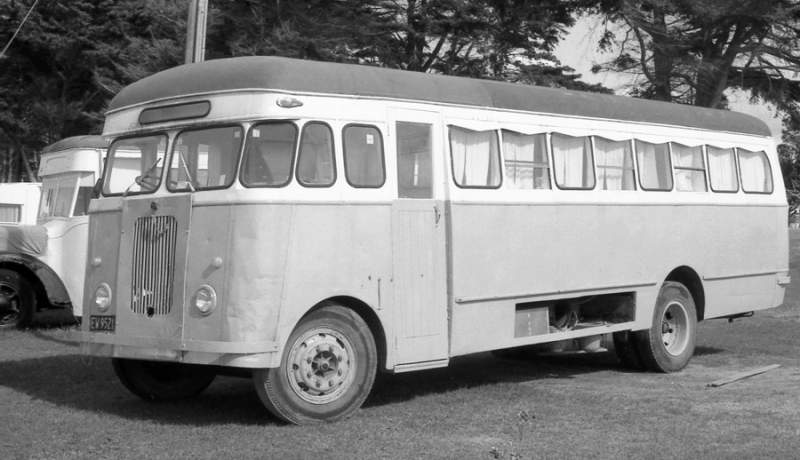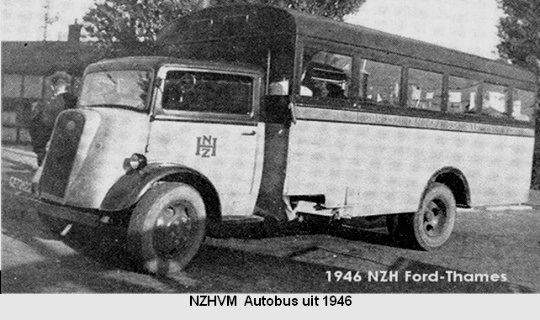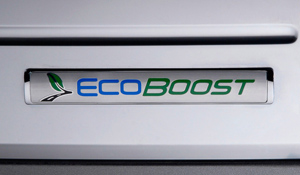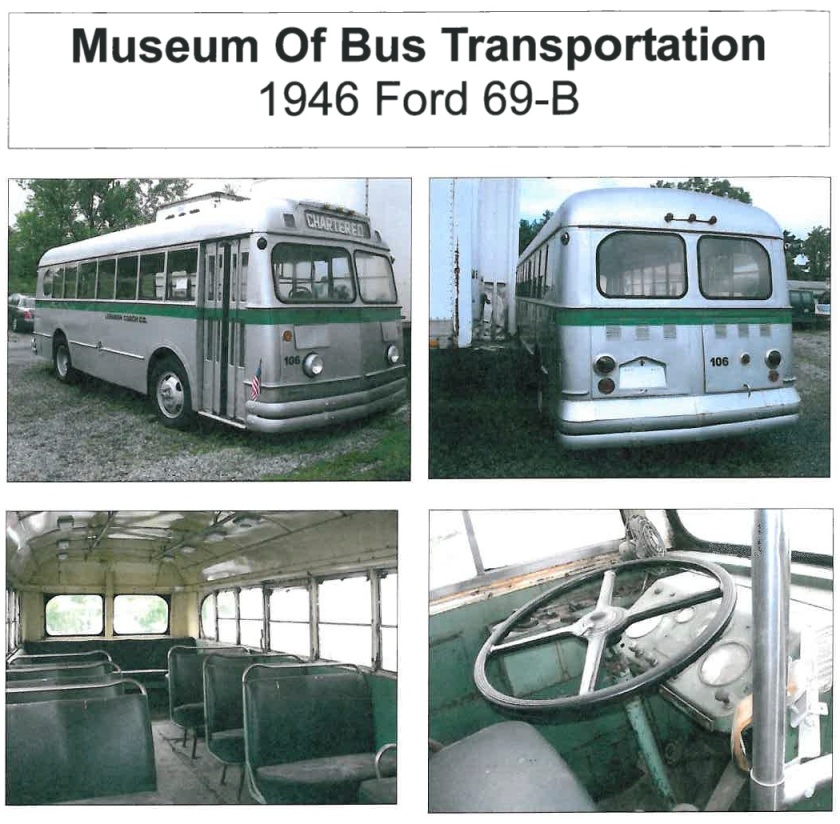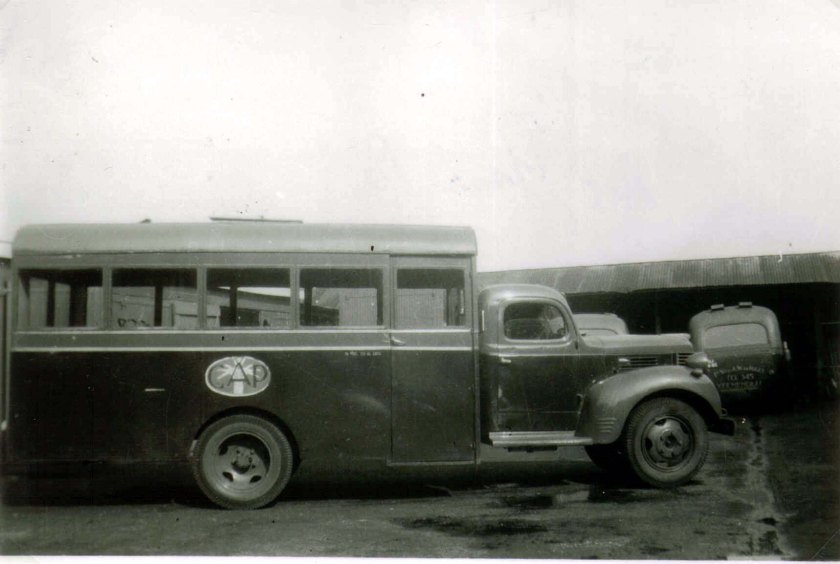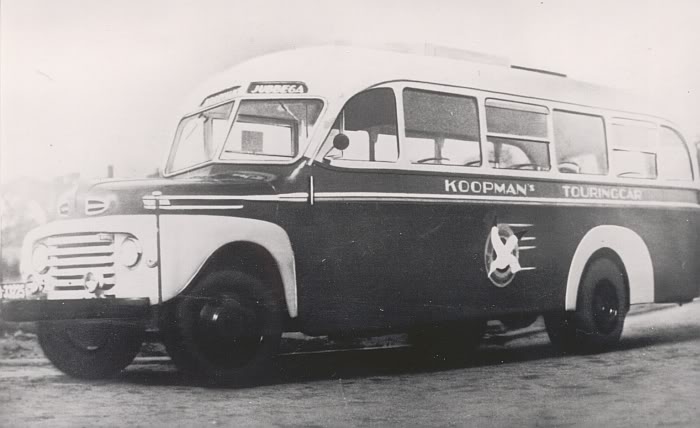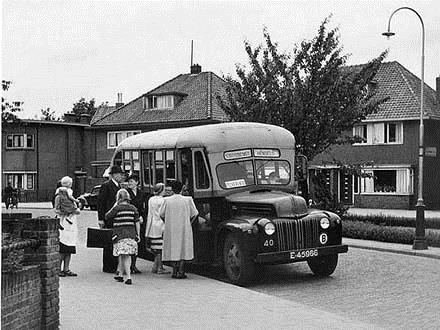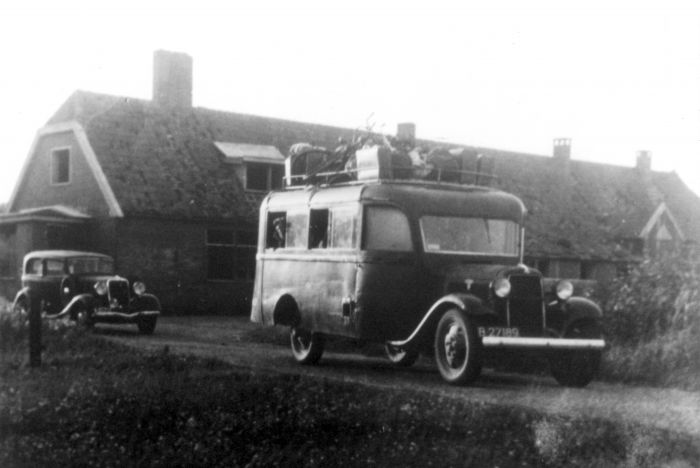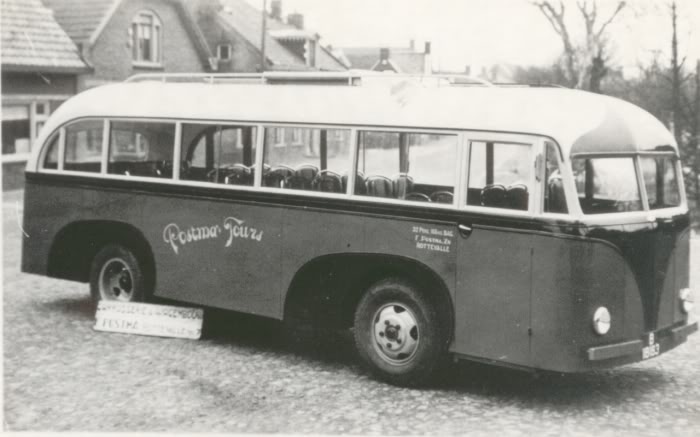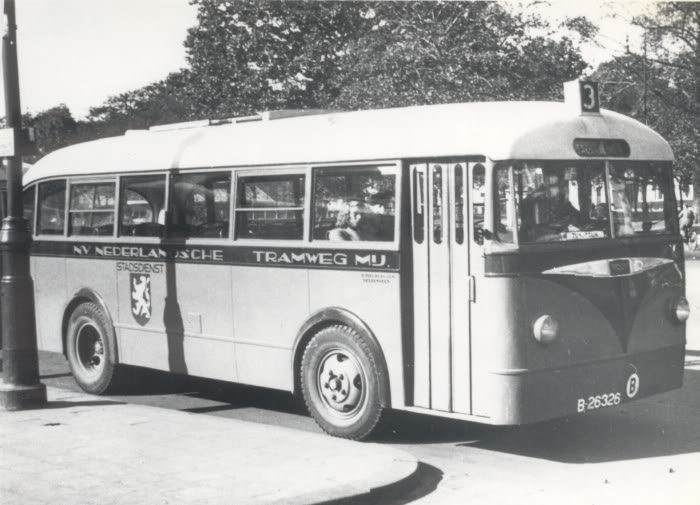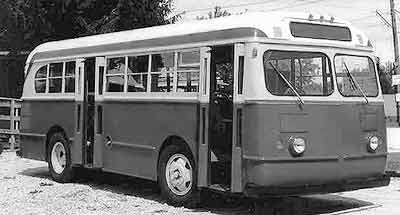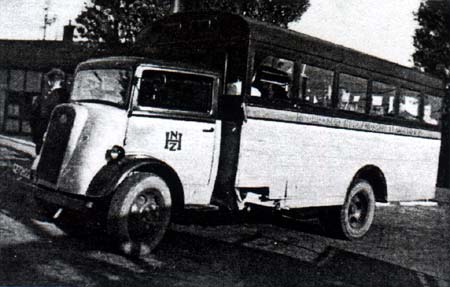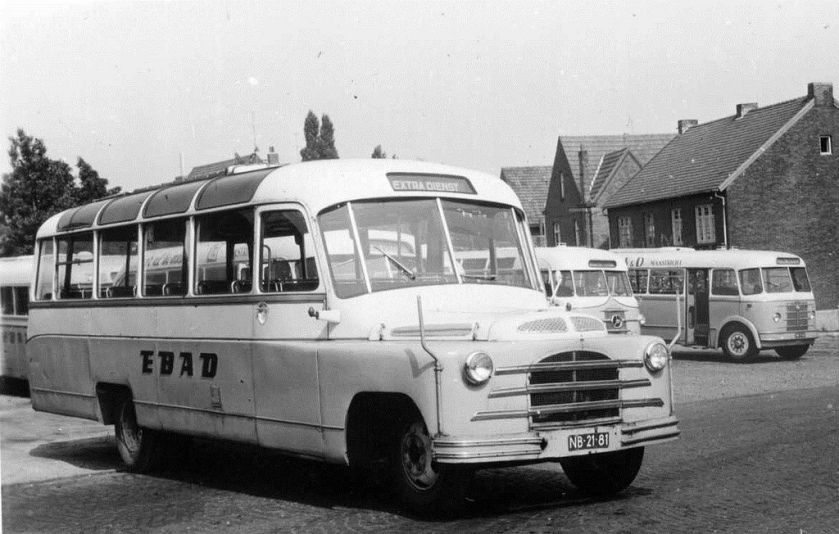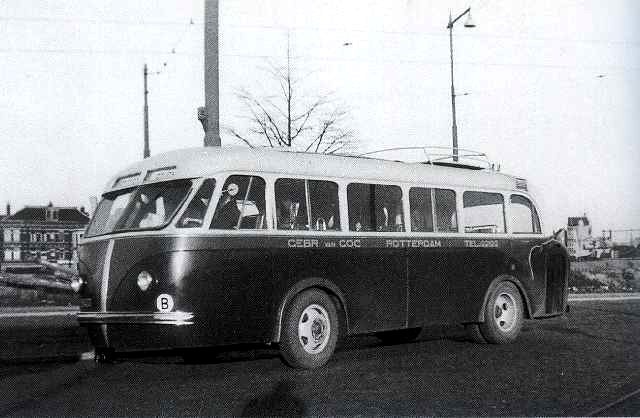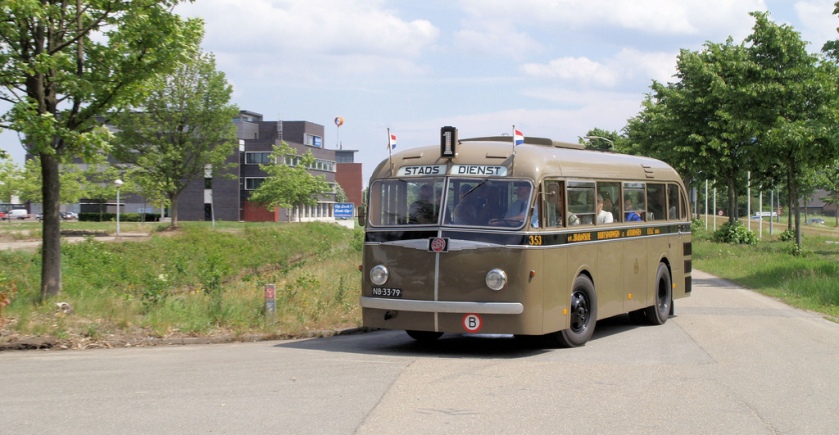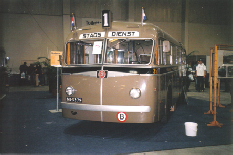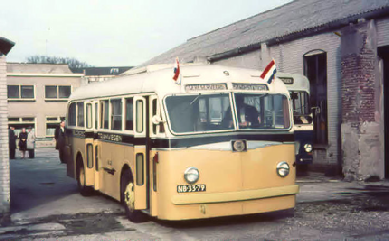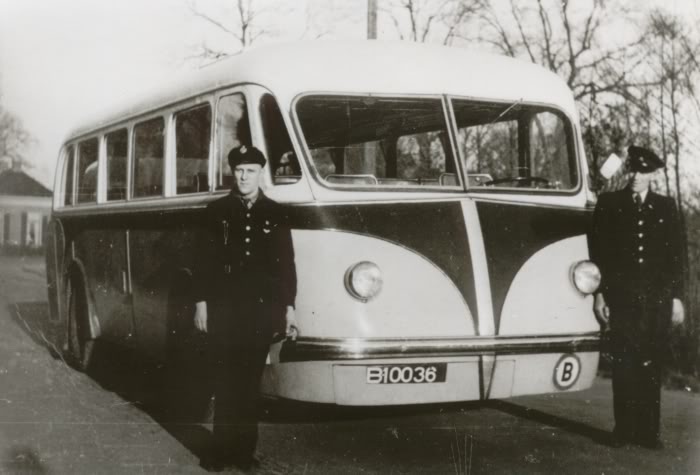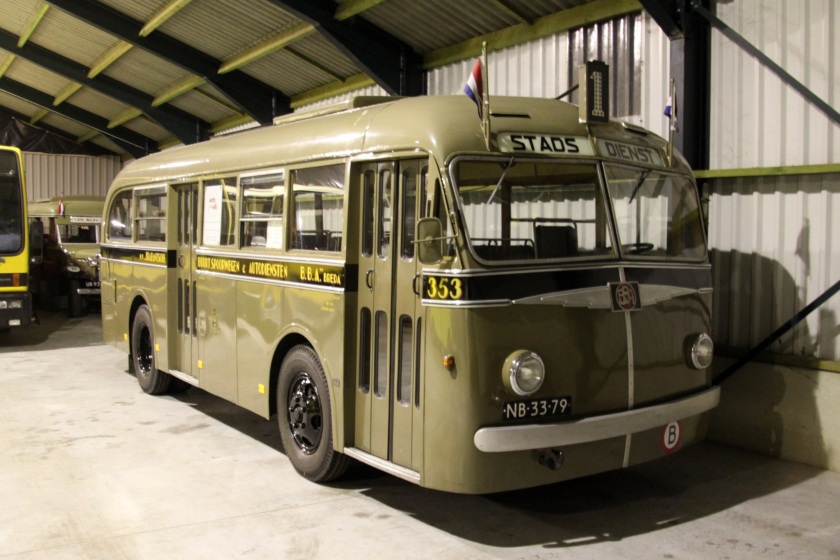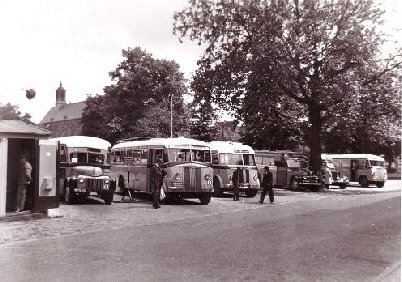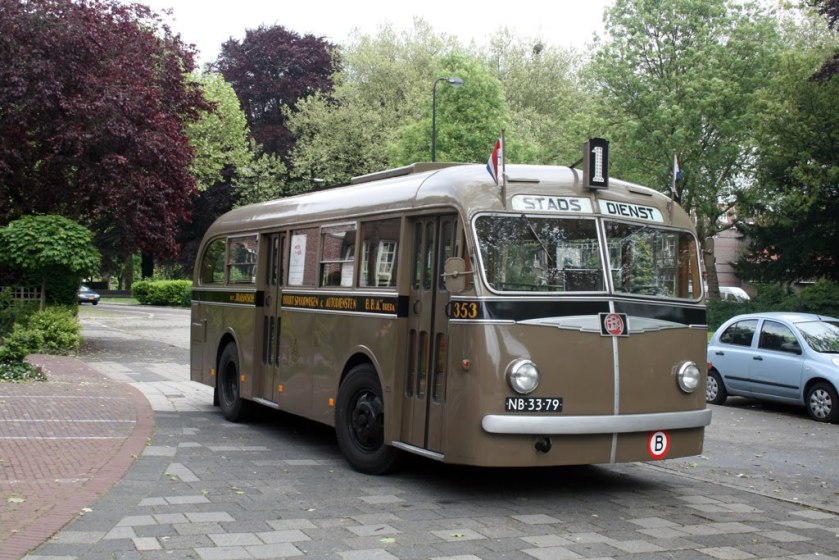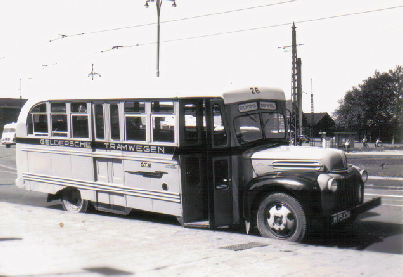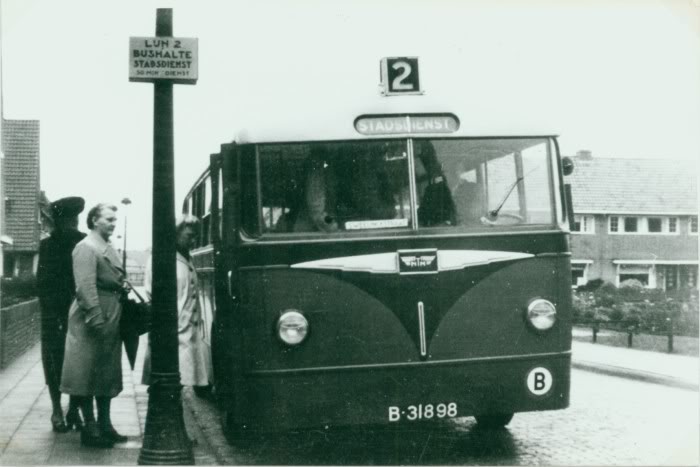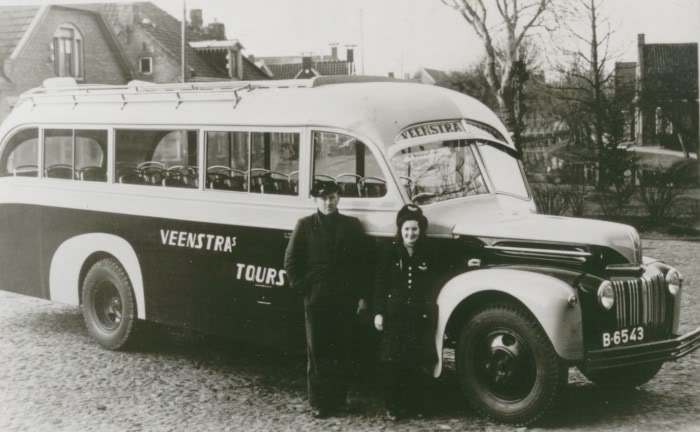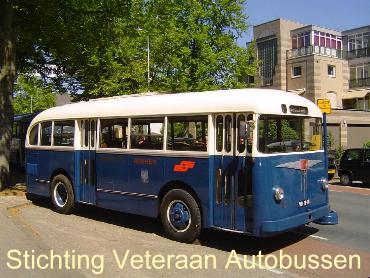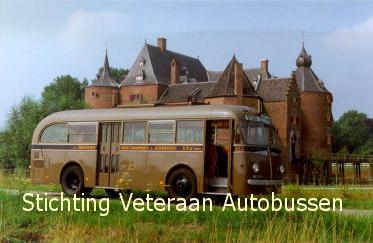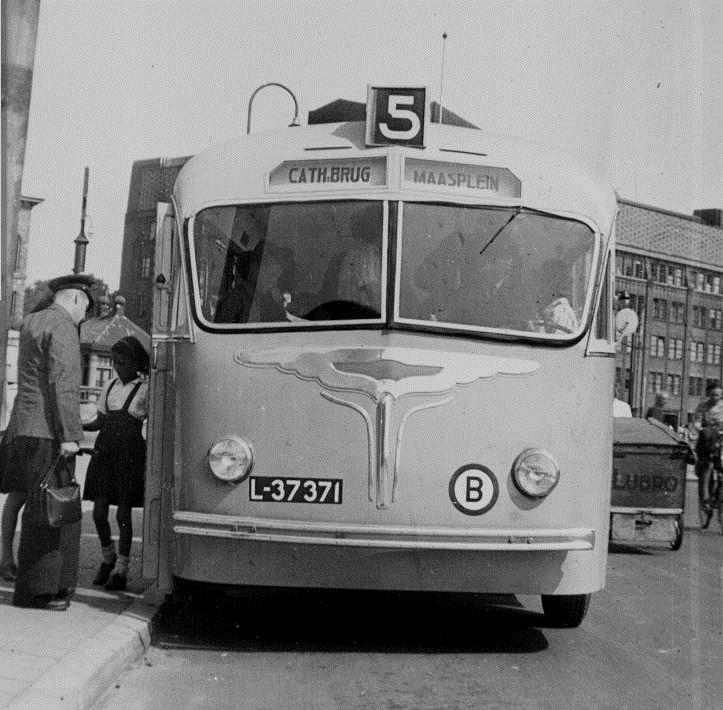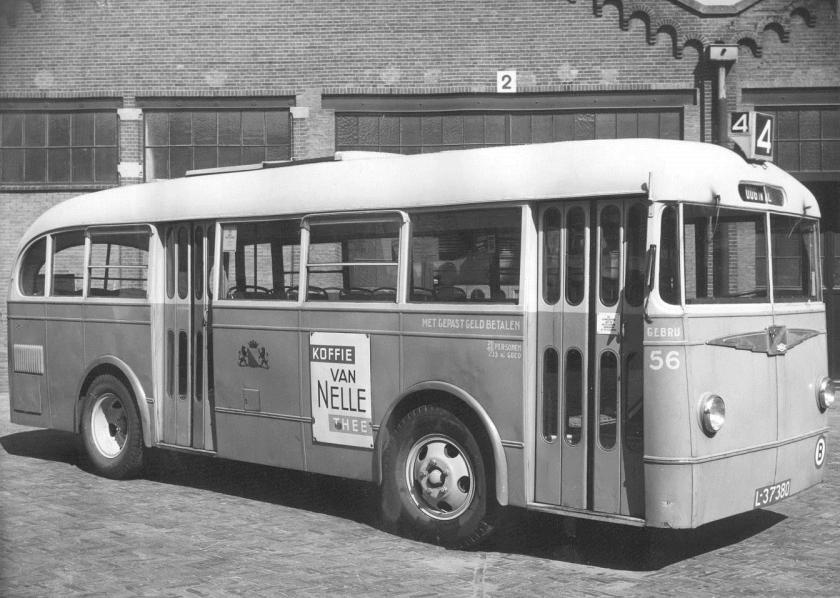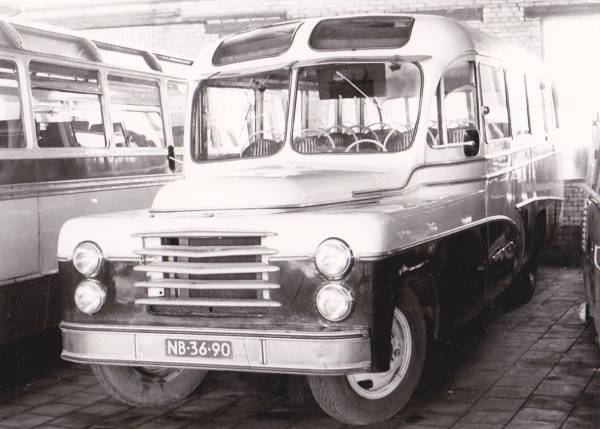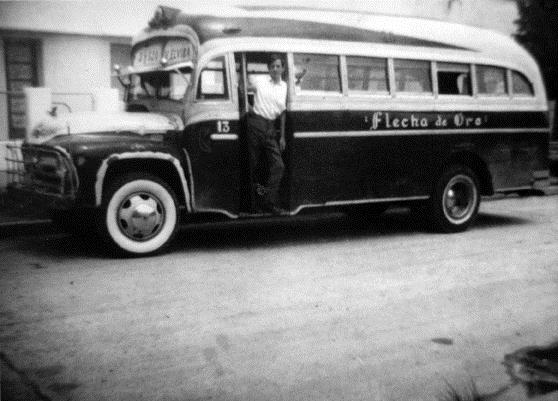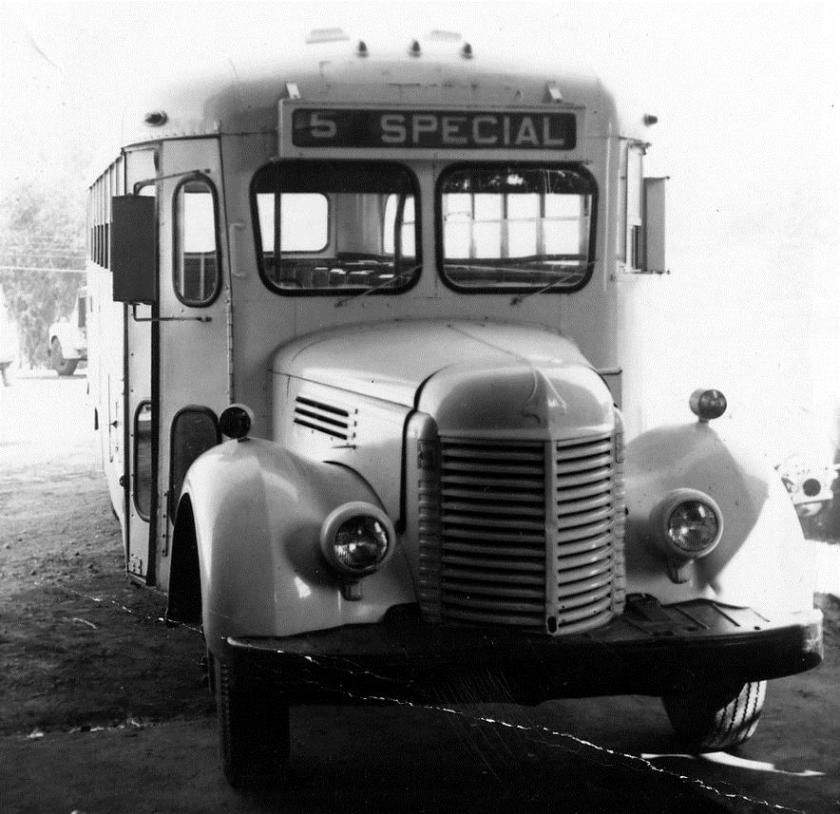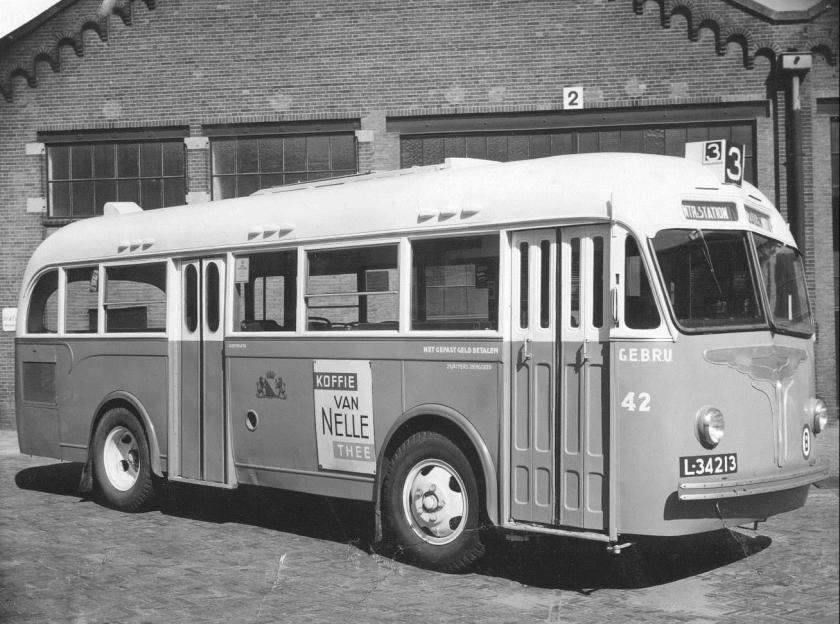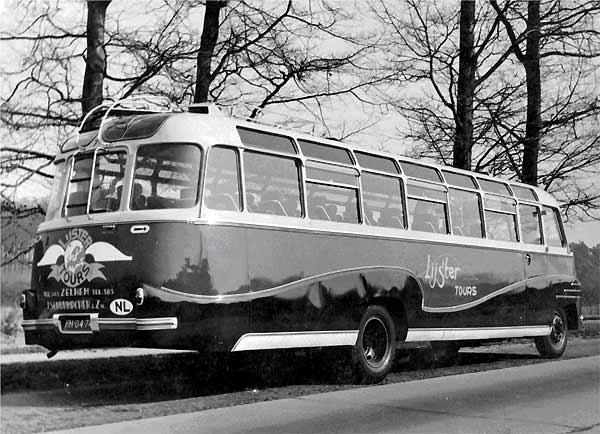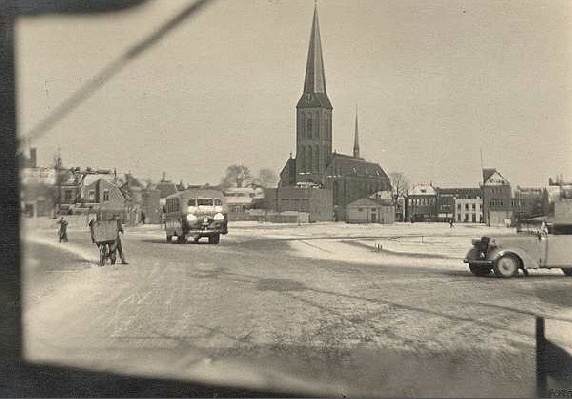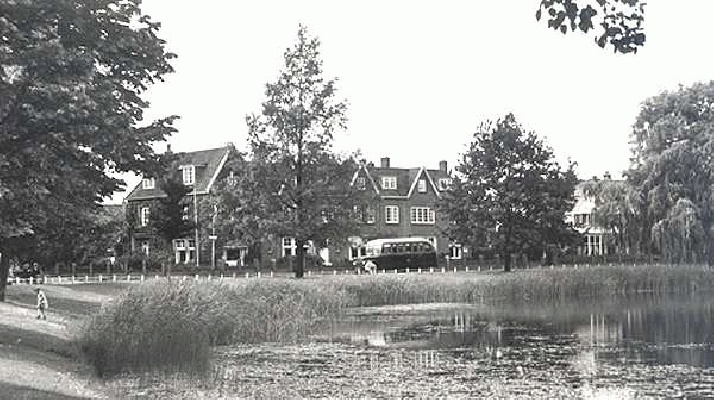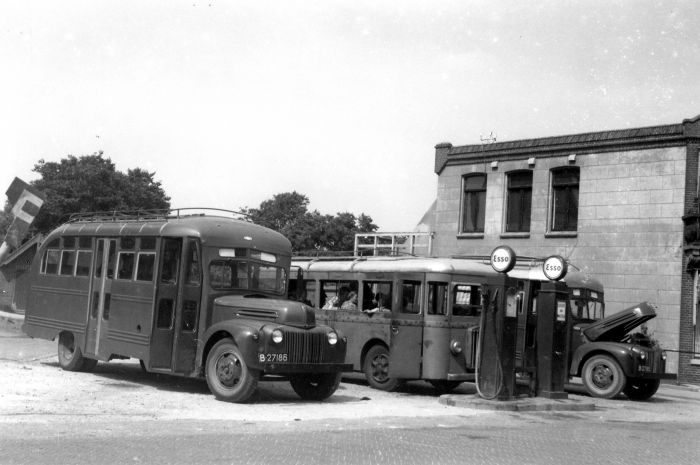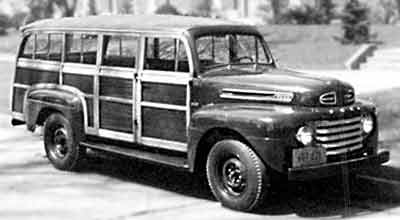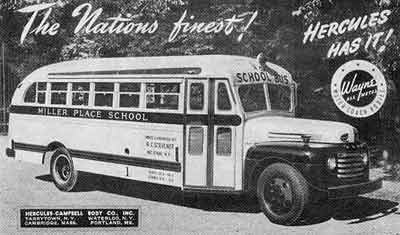FORD Motor Company
Dearborn Michigan USA 1903 – still going strong Part II
1896 Quadricycle at The Henry Ford Museum in Dearborn, MI
1899 Ford Model T
1903
1903 Ford Model A – original sales leaflet
Ford Model A (1903–04)
| Ford Model A | |
|---|---|
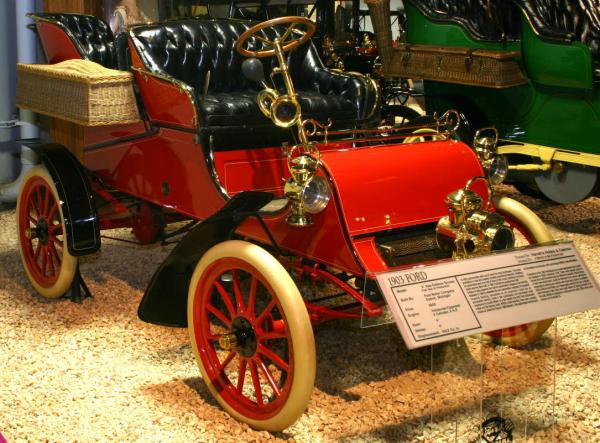 |
|
| Overview | |
| Manufacturer | Ford Motor Company |
| Also called | Fordmobile Ford Model AC |
| Production | 1903–1904 1700 produced |
| Designer | Henry Ford |
| Body and chassis | |
| Body style | 2-seat runabout rear-entry 4-seat tonneau |
| Powertrain | |
| Engine | Flat-2 1668 cc (101.788 cu in) 8hp. |
| Transmission | 2-speed planetary |
| Dimensions | |
| Wheelbase | 72 in (1.8 m) |
| Curb weight | 1,240 lb (562 kg) |
| Chronology | |
| Predecessor | Ford Quadricycle |
| Successor | Ford Model B Ford Model C |
The original Ford Model A is the first car produced by Ford Motor Company, beginning production in 1903. Ernst Pfennig, a Chicago dentist, became the first owner of a Model A on July 23, 1903. 1,750 cars were made from 1903 through 1904. The Model A was replaced by the Ford Model C during 1904 with some sales overlap.
1903 ford model A a
The car came as a two-seater runabout or four-seater tonneau model with an option to add a top. The horizontal-mounted flat-2, situated amidships of the car, produced 8 hp (6 kW). A planetary transmission was fitted with two forward speeds and reverse, a Ford signature later seen on the Ford Model T. The car weighed 1,240 lb (562 kg) and could reach a top speed of 28 mph (45 km/h). It had a 72 inch (1.8 m) wheelbase and sold for a base price of US$750. Options included a rear tonneau with two seats and a rear door for $100, a rubber roof for $30 or a leather roof for $50. Band brakes were used on the rear wheels. However, it was $150 more than its most direct competitor, the Oldsmobile Curved Dash, and so did not sell as well.
1904 Ford Model A
The company had spent almost its entire $28,000 initial investment funds with only $223.65 left in its bank account when the first Model A was sold. The success of this car model generated a profit for the Ford Motor Company, Henry Ford‘s first successful business.
1904 Ford Model A-C
Although Ford advertised the Model A as the “most reliable machine in the world”, it suffered from many problems common to vehicles of the era, including overheating and slipping transmission bands. The Model A was sold only in red by the factory, though some were later repainted in other colors.
Model AC
Some 1904 Model A cars were equipped with the larger, more powerful engine of the Model C and were sold as the Model AC.
Ford Model B (1904)
See also Ford Model B (1932)
| Ford Model B | |
|---|---|
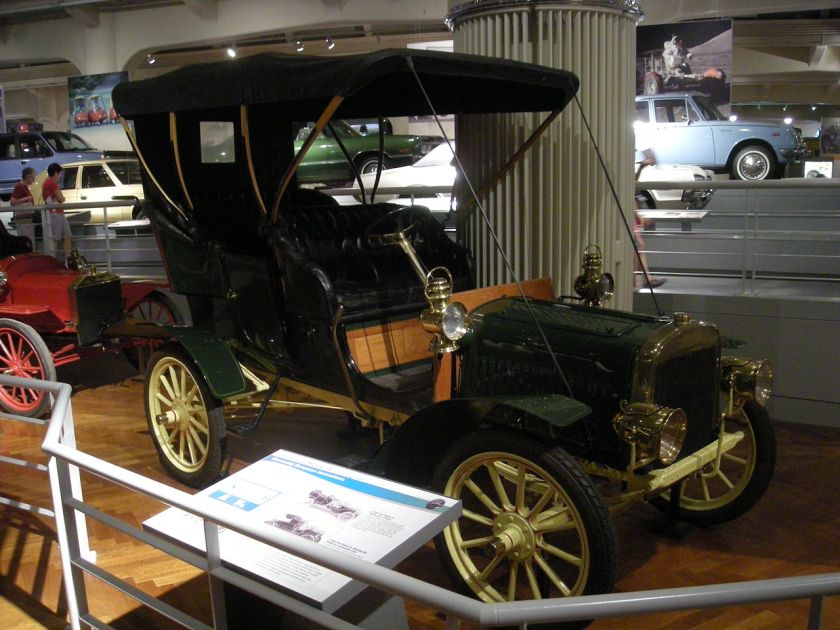 |
|
| Overview | |
| Manufacturer | Ford Motor Company |
| Production | 1904–1906 500 produced |
| Designer | Henry Ford |
| Body and chassis | |
| Body style | 2-row 4-passenger touring car |
| Related | Cadillac 8 1/2 |
| Powertrain | |
| Engine | 283.5CID 24hp Straight-4 |
| Transmission | 2-speed planetary |
| Dimensions | |
| Wheelbase | 92 in (2337 mm) |
| Curb weight | 1700lbs. |
| Chronology | |
| Predecessor | Ford Model A |
| Successor | Ford Model K |
Ford Model B was an upscale touring car (with polished wood and brass trim) introduced in 1904. It was Ford’s first car to use the front-engine layout, with a large 24 hp 4-cylinder engine positioned at the front behind a conventional radiator. The smaller Model A-derived Model C positioned its flat 2-cylinder motor under the seat.
1904 Ford Model B Touring
Priced at $2000 (equivalent to $52000 today), the Model B was a high end car. Produced for three years, sales were predictably slower than the Model C which was priced at 1/3 the cost. The Model B was replaced by the derivative Model K in 1906.
Ford Model C
| Ford Model C | |
|---|---|
| Overview | |
| Manufacturer | Ford Motor Company |
| Production | 1904–1905 800 produced |
| Designer | Henry Ford |
| Body and chassis | |
| Body style | 2-seat runabout rear-entry 4-seat tonneau |
| Powertrain | |
| Engine | 120.5CID 10hp Flat-2 |
| Transmission | 2-speed planetary |
| Dimensions | |
| Wheelbase | 78 in (198 cm) |
| Curb weight | 1,250 lb (567 kg) |
| Chronology | |
| Predecessor | Ford Model A |
| Successor | Ford Model F |
The Ford Model C was a version of the first Ford Model A with more modern look. It had a slightly more powerful engine and 15 cm (6 inches) longer wheelbase. It was the entry-level car in the Ford model lineup, slotting below the upscale Model B. Production ended in 1905 with 800 cars made. The Model C was replaced by the derivative Model F in 1905.
1904 Ford Model C
Both Models A and C were produced at the same time, but the Model A could also be bought with a Model C engine, an option called Ford Model AC. The Model C engine was a flat-2 giving 8 hp (6 kW) at first and 10 hp (7 kW) by 1905 with a claimed top speed of 38 mph.[1] The Model C was sold for $850 (equivalent to $22000 today), with the option of making it a four-seater for an extra $100. The top cost extra, rubber for $30 and leather for $50.
1904 Ford Model C
Although the Model C had a protruding front “box” like a modern car, unlike the flat-front Model A, this was purely ornamental — the engine remained under the seat (the gas tank was what was under the hood).
1904 Ford Model C runabout
1904 Ford Model C Runabout
1904 Ford Model C
1904 Ford Model C
The Model C was the first vehicle to be built at Ford Motor Company of Canada.
Ford Model F
| Ford Model F | |
|---|---|
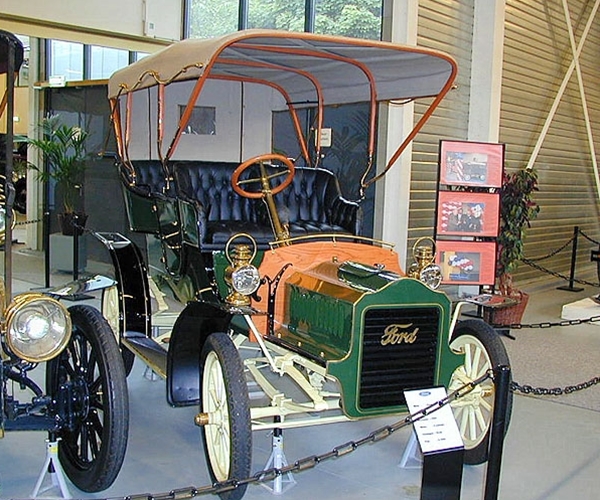 |
|
| Overview | |
| Manufacturer | Ford Motor Company |
| Production | 1905–1906 1000 produced |
| Designer | Henry Ford |
| Body and chassis | |
| Class | Entry-level car |
| Body style | 2-row phaeton |
| Powertrain | |
| Engine | 127CID 12hp Flat-2 |
| Transmission | 2-speed planetary |
| Dimensions | |
| Wheelbase | 84 in (2134 mm) |
| Curb weight | 1400 lb (635 kg) |
| Chronology | |
| Predecessor | Ford Model C |
| Successor | Ford Model N |
The Ford Model F is an automobile produced by the Ford Motor Company. It was a development of the Model A and Model C, but was larger, more modern, and more luxurious. It was a four-seater phaeton withrunning boards and a side-entrance tonneau standard. Production started in 1905 and ended in 1906 after about 1000 were made. In 1905, it was priced at US$2,000 ($52,496 in 2015); by contrast, the Colt Runabout was $1,500, the FAL was $1,750, the Cole 30 $1,500, the Enger 40 $2,000, and the Lozier Light Six Metropolitan $3,250. All had green bodies.
Ford Model K
| Ford Model K | |
|---|---|
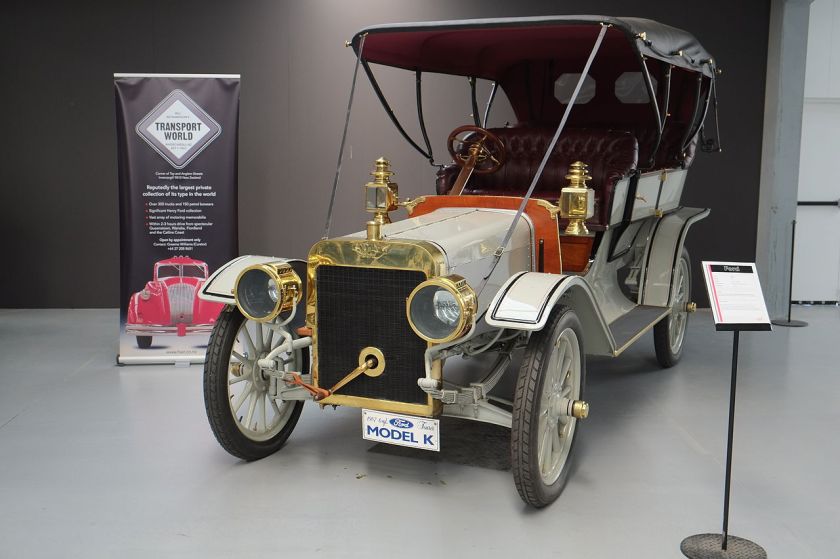 |
|
| Overview | |
| Manufacturer | Ford Motor Company |
| Production | 1906–1908 |
| Designer | Henry Ford |
| Body and chassis | |
| Class | Upscale |
| Body style | 2-row touring car |
| Powertrain | |
| Engine | 405CID cast iron block 40hp Straight-6 |
| Transmission | planetary 2-speed manual |
| Dimensions | |
| Wheelbase | 114 in (290 cm) |
| Curb weight | 2,400 lb (1,089 kg) |
| Chronology | |
| Predecessor | Ford Model B |
Ford Model K was an upscale automobile produced by the Ford Motor Company. It was introduced in 1906 and replaced the earlier Model B. The model K was aimed at the top end of the market and featured an inline-6 (the only Ford six until 1941) giving 40 hp (30 kW). The wheelbase was 120 in (2896 mm) and could be ordered either as touring or roadster. Contrary to popular folklore, the Model K was a good seller for Ford Motor Company. In 1906, the first year it was offered, the Model K produced over eighty five percent of Ford Motor Company’s new car profit (1906 Ford Motor Company internal audit records). In 1907, the second, and primary sales year of the Model K, almost five hundred Model K were sold, the best selling six cylinder model in the world. As period journals reported, Ford Motor Company went in another direction, moving to one chassis, a mid priced car, the Model T, leaving the multi-line business model used by most auto makers of the period. However, sales and profits from the Model K helped Ford Motor Company become the largest automaker in number of sales in 1907, and along with the Model N, was the only Ford model sold through three model years (1906-1908) prior to the advent of the Model T.
Ford Model N
| Ford Model N | |
|---|---|
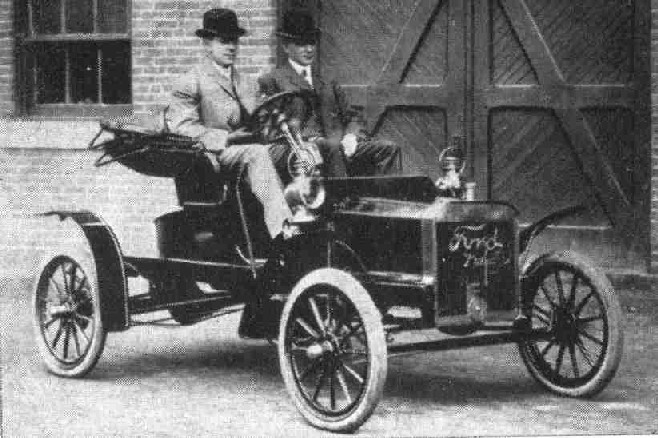 |
|
| Overview | |
| Manufacturer | Ford Motor Company |
| Also called | Ford Model R Ford Model S |
| Production | 1906–1908 13,250 produced |
| Designer | Henry Ford |
| Body and chassis | |
| Class | Entry-level car |
| Body style | 2-row phaeton |
| Powertrain | |
| Engine | 149CID 15hp Model N EngineStraight-4 |
| Transmission | 2-speed planetary |
| Dimensions | |
| Wheelbase | 84 in (213 cm) |
| Curb weight | 800 lb (363 kg) (1906); 1,050 lb (476 kg) (1907 Model N); 1,400 lb (635 kg) (1907 Models R and S) |
| Chronology | |
| Predecessor | Ford Model F |
| Successor | Ford Model T |
The Ford Model N is an automobile that was produced by the Ford Motor Company. It was introduced in 1906 as a successor to the Models A and C as the company’s inexpensive entry-level line.
The Model N diverged from its predecessors in that it was a front-engine car with a 4-cylinder engine. The 15 hp straight-4 drove the rear wheels via a long shaft. This was also the first American car to use vanadium steel. The car had a wheelbase size of 84 in (2.1 m).
A successful model, 7000 cars were made until production ended in 1908. At US$500 the car was viewed as highly affordable at the time; by contrast, the high-volume OldsmobileRunabout went for $650, Western‘s Gale Model A was $500, the Brush Runabout $485, the Black went for as low as $375, and the Success hit the amazingly low $250. Maroon was the only factory color for the Model N.
Ford Model R
1907 Ford Model R
The Model R was a higher trim level of the Model N with a larger body, wheels covered by full cycle fenders, running boards, and an oil lamp. Model R was $750, $150 above the $600 base Model N. The Model R was only produced in 1907, from April through October, and 2500 were sold. Its color was red.
Model S
1907-ford-model-s-drivers-side-front-view
The Model S was another adaptation of the Model N. Ford’s last US market right-hand-drive model, it featured a more modern cowl, with hood and fenders that flowed into full running boards. Another notable difference was the optional extra third mother-in-law seat behind the front bench. The basic model sold for $700. Extras such as a convertible top, gas lamps, as well as umbrella holders were available. 3750 cars were sold between 1907 and 1909.
1907 Ford Model S Runabout
1907 Ford S side
1908 Ford Model S Image
1908 Ford Model S Runabout
1909 logo
Ford Model T
| Ford Model T | |
|---|---|

1919 Ford Model T Coupe
|
|
| Overview | |
| Manufacturer | Ford Motor Company |
| Production | 1908–1927 |
| Assembly |
|
| Designer | Henry Ford, Childe Harold Wills, Joseph A. Galamb andEugene Farkas |
| Body and chassis | |
| Class | Full-size Ford, economy car |
| Body style |
|
| Layout | FR layout |
| Powertrain | |
| Engine | 177 C.I.D. (2.9 L) 20 hp I4 |
| Transmission | 2-speed planetary gear |
| Dimensions | |
| Wheelbase | 100.0 in (2,540 mm) |
| Length | 134 in (3,404 mm) |
| Curb weight | 1,200 pounds (540 kg) |
| Chronology | |
| Predecessor | Ford Model S |
| Successor | Ford Model A |
The Ford Model T (colloquially known as the Tin Lizzie, Tin Lizzy, T‑Model Ford,Model T, or T) is an automobile that was produced by Henry Ford‘s Ford Motor Company from October 1, 1908, to May 26, 1927. It is generally regarded as the first affordable automobile, the car that opened travel to the common middle-classAmerican; some of this was because of Ford’s efficient fabrication, including assembly lineproduction instead of individual hand crafting.
The Ford Model T was named the most influential car of the 20th century in the 1999 Car of the Century competition, ahead of the BMC Mini, Citroën DS, and Volkswagen Type 1, and still makes top ten list of most sold cars (ranked nr. 8) as of 2012.
Although automobiles had already existed for decades, their adoption had been limited, and they were still mostly scarce and expensive. Automobiles were considered extreme luxury for the common man until the Model T. The Model T set 1908 as the historic year that the automobile became popular for the mass market. The first production Model T was produced on August 12, 1908 and left the factory on September 27, 1908, at the Piquette Plant in Detroit, Michigan. On May 26, 1927, Henry Ford watched the 15 millionth Model T Ford roll off the assembly line at hisfactory in Highland Park, Michigan.
There were several cars produced or prototyped by Henry Ford from the founding of the company in 1903 until the Model T was introduced. Although he started with theModel A, there were not 19 production models (A through T); some were only prototypes. The production model immediately before the Model T was the Model S, an upgraded version of the company’s largest success to that point, the Model N. The follow-up was the Ford Model A (rather than any Model U). The company publicity said this was because the new car was such a departure from the old that Henry wanted to start all over again with the letter A.
The Model T was Ford’s first automobile mass-produced on moving assembly lines with completely interchangeable parts, marketed to the middle class. Henry Ford said of the vehicle:
I will build a car for the great multitude. It will be large enough for the family, but small enough for the individual to run and care for. It will be constructed of the best materials, by the best men to be hired, after the simplest designs that modern engineering can devise. But it will be so low in price that no man making a good salary will be unable to own one – and enjoy with his family the blessing of hours of pleasure in God’s great open spaces.
Although credit for the development of the assembly line belongs to Ransom E. Oldswith the first mass-produced automobile, the Oldsmobile Curved Dash, beginning in 1901, the tremendous advancements in the efficiency of the system over the life of the Model T can be credited almost entirely to the vision of Ford and his engineers.
Characteristics
The Model T was designed by Childe Harold Wills, and Hungarian immigrants Joseph A. Galamb and Eugene Farkas. Henry Love, C. J. Smith, Gus Degner and Peter E. Martin were also part of the team. Production of the Model T began in the third quarter of 1908. Collectors today sometimes classify Model Ts by build years and refer to these as “model years“, thus labeling the first Model Ts as 1909 models. This is a retroactive classification scheme; the concept of model years as we conceive it today did not exist at the time. The nominal model designation was “Model T”, although design revisions did occur during the car’s two decades of production.
Engine
The Model T had a front-mounted 177-cubic-inch (2.9 L) inline four-cylinder engine, producing 20 hp (15 kW), for a top speed of 40–45 mph (64–72 km/h). According to Ford Motor Company, the Model T had fuel economy on the order of 13–21 mpg-US(16–25 mpg-imp; 18–11 L/100 km). The engine was capable of running on gasoline,kerosene, or ethanol, although the decreasing cost of gasoline and the later introduction of Prohibition made ethanol an impractical fuel for most users.
The ignition system used an unusual trembler coil system to drive the spark plugs, as used for stationary gas engines, rather than the expensive magnetos that were used on other cars. This ignition also made the Model T more flexible as to the quality or type of fuel it used. The need for a starting battery and also Ford’s use of an unusual AC alternator located inside the flywheel housing encouraged the adoption of electric lighting, rather than oil or acetylene lamps, but it also delayed the adoption of electric starting.
Transmission and drive train
The Model T was a rear-wheel drive vehicle. Its transmission was a planetary geartype billed as “three speed”. In today’s terms it would be considered a two-speed, because one of the three speeds was reverse.
The Model T’s transmission was controlled with three foot pedals and a lever that was mounted to the road side of the driver’s seat. The throttle was controlled with a lever on the steering wheel. The left pedal was used to engage the gear. With the floor lever in either the mid position or fully forward and the pedal pressed and held forward the car entered low gear. When held in an intermediate position the car was in neutral. If the driver took his foot off the left pedal, the Model T entered high gear, but only when the lever was fully forward – in any other position the pedal would only move up as far as the central neutral position. This allowed the car to be held in neutral while the driver cranked the engine by hand. The car could thus cruise without the driver having to press any of the pedals. There was no separateclutch pedal.
When the car was in neutral, the middle pedal was used to engage reverse gear, and the right pedal operated the transmission brake – there were no separate brakes on the wheels. The floor lever also controlled the parking brake, which was activated by pulling the lever all the way back. This doubled as an emergency brake.
Although it was uncommon, the drive bands could fall out of adjustment, allowing the car to creep, particularly when cold, adding another hazard to attempting to start the car: a person cranking the engine could be forced backward while still holding the crank as the car crept forward, although it was nominally in neutral. As the car utilized a wet clutch, this condition could also occur in cold weather, where the thickened oil prevents the clutch discs from slipping freely. Power reached the differential through a single universal joint attached to a torque tube which drove the rear axle; some models (typically trucks, but available for cars as well) could be equipped with an optional two-speed Ruckstell rear axle shifted by a floor-mounted lever which provided an underdrive gear for easier hill climbing. All gears werevanadium steel running in an oil bath.
Transmission bands and linings
There were two main types of band lining material used:
- Cotton – Cotton woven linings were the original type fitted and specified by Ford. Generally, the cotton lining is “kinder” to the drum surface, with damage to the drum caused only by the retaining rivets scoring the drum surface. Although this in itself did not pose a problem, a dragging band resulting from improper adjustment caused overheating transmission and engine, diminished power, and—in the case of cotton linings—rapid destruction of the band lining.
- Wood – Wooden linings were originally offered as a “longer life” accessory part during the life of the Model T. They were a single piece of steam bent cottonwood fitted to the normal Model T Transmission band. These bands give a very different feel to the pedals, with much more of a “bite” feel. The sensation is of a definite “grip” of the drum and seemed to noticeably increase the feel, in particular of the brake drum.
Suspension and wheels
Model T suspension employed a transversely mounted semi-elliptical spring for each of the front and rear beam axles which allowed a great deal of wheel movement to cope with the dirt roads of the time.
The front axle was drop forged as a single piece of vanadium steel. Ford twisted many axles eight times and sent them to dealers to be put on display to demonstrate its superiority. The Model T did not have a modern service brake. The right foot pedal applied a band around a drum in the transmission, thus stopping the rear wheels from turning. The previously mentioned parking brake lever operated band brakes acting on the inside of the rear brake drums, which were an integral part of the rear wheel hubs. Optional brakes that acted on the outside of the brake drums were available from aftermarket suppliers.
Wheels were wooden artillery wheels, with steel welded-spoke wheels available in 1926 and 1927.
Tires were pneumatic clincher type, 30 in (76 cm) in diameter, 3.5 in (8.9 cm) wide in the rear, 3 in (7.5 cm) wide in the front. Clinchers needed much higher pressure than today’s tires, typically 60 psi (410 kPa), to prevent them from leaving the rim at speed. Horseshoe nails on the roads, together with the high pressure, made flat tires a common problem.
Balloon tires became available in 1925. They were 21 in × 4.5 in (53 cm × 11 cm) all around. Balloon tires were closer in design to today’s tires, with steel wires reinforcing the tire bead, making lower pressure possible – typically 35 psi (240 kPa) – giving a softer ride. The old nomenclature for tire size changed from measuring the outer diameter to measuring the rim diameter so 21 in (530 mm) (rim diameter) × 4.5 in (110 mm) (tire width) wheels has about the same outer diameter as 30 in (76 cm) clincher tires. All tires in this time period used an inner tube to hold the pressurized air; “tubeless” tires were not generally in use until much later.
Wheelbase was 100 inches (254 cm); while standard tread width was 56 in (142 cm), 60 in (152 cm) tread could be obtained on special order, “for Southern roads”, identical to the pre-Civil War track gauge for many railroads in the former Confederacy.
Colors
By 1918, half of all the cars in the US were Model Ts. However, it was a monolithic bloc; Ford wrote in his autobiography that in 1909 he told his management team that in the future “Any customer can have a car painted any color that he wants so long as it is black”.
However, in the first years of production from 1908 to 1913, the Model T was not available in black but rather only grey, green, blue, and red. Green was available for the touring cars, town cars, coupes, and Landaulets. Grey was only available for the town cars, and red only for the touring cars. By 1912, all cars were being painted midnight blue with black fenders. It was only in 1914 that the “any color so long as it is black” policy was finally implemented. It is often stated that Ford suggested the use of black from 1914 to 1926 due to the cheap cost and durability of black paint. During the lifetime production of the Model T, over 30 different types of black paint were used on various parts of the car. These were formulated to satisfy the different means of applying the paint to the various parts, and had distinct drying times, depending on the part, paint, and method of drying.
Body

Although Ford classified the Model T with a single letter designation throughout its entire life and made no distinction by model years, there were enough significant changes to the body over the production life that the car can be classified into five distinct generations. One of the most immediately visible and identifiable areas of change were in the hood and cowl areas although there were also many other changes made to the vehicle.
- 1909–1914 – T1 – Characterized by a nearly straight, five sided hood, with a flat top containing a center hinge and two side sloping sections containing the folding hinges. The firewall was flat from the windshield down with no distinct cowl.
- 1915–1916 – T2 – The hood design was nearly the same five sided design with the only obvious change being the addition of louvers to the vertical sides. There was a significant change to the cowl area with the windshield relocated significantly behind the firewall and joined with a compound contoured cowl panel.
- 1917–1923 – T3 – The hood design was changed to a tapered design with a curved top. the folding hinges were now located at the joint between the flat sides and the curved top. This is sometime referred to as the low hood to distinguish if from the later hoods. The back edge of the hood now met the front edge of the cowl panel so that no part of the flat firewall was visible outside of the hood. This design was used the longest and during the highest production years accounting for about half of the total number of Model T’s built.
- 1923–1925 – T4 – This change was made during the 1923 calendar year so models built earlier in the year have the older design while later vehicles have the newer design. The taper of the hood was increased and the rear section at the firewall is about an inch taller and several inches wider than the previous design. While this is a relatively minor change, the parts between the third and fourth generation are not interchangeable.
- 1926–1927 – T5 – This design change made the greatest difference in the appearance of the car. The hood was again enlarged with the cowl panel no longer a compound curve and blended much more with the line of the hood. The distance between the firewall and the windshield was also increased significantly. This style is sometimes referred to as the high hood.
The styling on the fifth generation was a preview for the following Model A but the two models are visually quite different as the body on the ‘A was much wider and had curved doors as opposed to the flat doors on the T.
Diverse applications
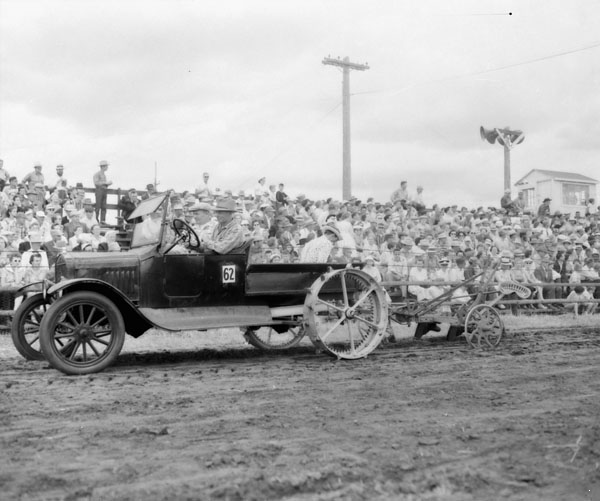
When the Model T was designed and introduced, the infrastructure of the world was quite different from today’s. Pavement was a rarity except for sidewalks and a few big-city streets. (The sense of the term “pavement” as equivalent with “sidewalk” comes from that era, when streets and roads were generally dirt and sidewalks were a paved way to walk along them.) Agriculture was the occupation of many people. Power tools were scarce outside factories, as were power sources for them;electrification, like pavement, was found usually only in larger towns. Rural electrification and motorized mechanization were embryonic in North America and Europe, and nonexistent elsewhere.
Henry Ford oversaw the requirements and design of the Model T based on the realities of that world. Consequently, the Model T was (intentionally) almost as much a tractor and portable engine as it was an automobile. It has always been well regarded for its all-terrain abilities and ruggedness. It could travel a rocky, muddy farm lane, ford a shallow stream, climb a steep hill, and be parked on the other side to have one of its wheels removed and a pulley fastened to the hub for a flat belt to drive a bucksaw, thresher, silo blower, conveyor for filling corn cribs or haylofts,baler, water pump (for wells, mines, or swampy farm fields), electrical generator, and countless other applications. One unique application of the Model T was shown in the October 1922 issue of Fordson Farmer magazine. It showed a minister who had transformed his Model T into a mobile church, complete with small organ.
During this era, entire automobiles (including thousands of Model Ts) were even hacked apart by their industrious owners and reconfigured into custom machinery permanently dedicated to a purpose, such as homemade tractors, ice saws, or many others. Dozens of aftermarket companies sold prefab kits to facilitate the T’s conversion from car to tractor. The Model T had been around for a decade before the Fordson tractor became available (1917–1918), and many Ts had been converted for field use. (For example, Harry Ferguson, later famous for his hitches and tractors, worked on Eros Model T tractor conversions before he worked with Fordsons and others.) During the next decade, Model T tractor conversion kits were harder to sell, as the Fordson and then the Farmall (1924), as well as other light and affordable tractors, served the farm market. But during the Depression(1930s), Model T tractor conversion kits had a resurgence, because by then used Model Ts and junkyard parts for them were plentiful and cheap.
Like many popular car engines of the era, the Model T engine was also used on home-built aircraft (such as the Pietenpol Sky Scout) and motorboats.
Many Model Ts were converted into vehicles which could travel across heavy snows with kits on the rear wheels (sometimes with an extra pair of rear-mounted wheels and two sets of continuous track to mount on the now-tandemed rear wheels, essentially making it a half-track) and skis replacing the front wheels. They were popular for rural mail delivery for a time. The common name for these conversions of cars and small trucks wassnowflyers. These vehicles were extremely popular in the northern reaches of Canada where factories were set up to produce them.
A number of companies built Model T–based railcars. In The Great Railway Bazaar, Paul Theroux mentions a rail journey in India on such a railcar. The New Zealand Railways Department‘s RM class included a few.
Production
Mass production
The knowledge and skills needed by a factory worker were reduced to 84 areas. When introduced, the T used the building methods typical at the time, assembly by hand, and production was small. Ford’s Piquette plant could not keep up with demand for the Model T, and only 11 cars were built there during the first full month of production. More and more machines were used to reduce the complexity within the 84 defined areas. In 1910, after assembling nearly 12,000 Model Ts, Henry Ford moved the company to the new Highland Park complex.
As a result, Ford’s cars came off the line in three-minute intervals, much faster than previous methods, reducing production time by a factor of eight (requiring 12.5 hours before, 93 minutes afterwards), while using less manpower. By 1914, the assembly process for the Model T had been so streamlined it took only 93 minutes to assemble a car. That year Ford produced more cars than all other automakers combined. The Model T was a great commercial success, and by the time Henry made his 10 millionth car, 50 percent of all cars in the world were Fords. It was so successful that Ford did not purchase any advertising between 1917 and 1923, instead it became so famous that people now considered it a norm; more than 15 million Model Ts were manufactured, reaching a rate of 9,000 to 10,000 cars a day in 1925, or 2 million annually, more than any other model of its day, at a price of just $260 (or about $3,230 in 2015 dollars). Model T production was finally surpassed by the Volkswagen Beetle on February 17, 1972.
Henry Ford’s ideological approach to Model T design was one of getting it right and then keeping it the same; he believed the Model T was all the car a person would, or could, ever need. As other companies offered comfort and styling advantages, at competitive prices, the Model T lost market share. Design changes were not as few as the public perceived, but the idea of an unchanging model was kept intact. Eventually, on May 26, 1927, Ford Motor Company ceased US production and began the changeovers required to produce the Model A. Some of the other Model T factories in the world continued a short while.
Model T engines continued to be produced until August 4, 1941. Almost 170,000 were built after car production stopped, as replacement engines were required to service already produced vehicles. Racers and enthusiasts, forerunners of modern hot rodders, used the Model T’s block to build popular and cheap racing engines, including Cragar, Navarro, and famously the Frontenacs (“Fronty Fords”) of the Chevrolet brothers, among many others.
The Model T employed some advanced technology, for example, its use of vanadium steel alloy. Its durability was phenomenal, and many Model Ts and their parts remain in running order nearly a century later. Although Henry Ford resisted some kinds of change, he always championed the advancement of materials engineering, and often mechanical engineering and industrial engineering.
In 2002, Ford built a final batch of six Model Ts as part of their 2003 centenary celebrations. These cars were assembled from remaining new components and other parts produced from the original drawings. The last of the six was used for publicity purposes in the UK.
Although Ford no longer manufactures parts for the Model T, many parts are still manufactured through private companies as replicas to service the thousands of Model Ts still in operation today. On May 26, 1927 Henry Ford and his son Edsel, drove the 15 millionth Model T out of the factory. This marked the famous automobile’s official last day of production at the main factory.
Price and Production
The assembly line system allowed Ford to sell his cars at a price lower than his competitors due to the efficiency of the system. As he continued to fine tune the system, he was able to keep reducing his costs. As his volume increased, he was able to also lower the prices due to fixed costs being spread over a larger number of vehicles. Other factors affected the price such a material costs and design changes.
The figures below are US production numbers compiled by R.E. Houston, Ford Production Department, August 3, 1927. The figures between 1909 and 1920 are for Ford’s fiscal year. From 1909 to 1913, the fiscal year was from October 1 to September 30 the following calendar year with the year number being the year it ended in. For the 1914 fiscal year, the year was October 1, 1913 through July 31, 1914. Starting in August 1914, and through the end of the Model T era, the fiscal year was August 1 through July 31. Beginning with January 1920 the figures are for the calendar year.
| Year | Production | Price for Runabout |
Notes |
|---|---|---|---|
| 1909 | 10,666 | $825 | ($21,650 in 2015) Touring car was $850 |
| 1910 | 19,050 | $900 | |
| 1911 | 34,858 | $680 | |
| 1912 | 68,773 | $590 | |
| 1913 | 170,211 | $525 | |
| 1914 | 202,667 | $440 | Fiscal year was only 10 months long due to change in end date from Sep 30 to July 31 |
| 1915 | 308,162 | $390 | |
| 1916 | 501,462 | $345 | |
| 1917 | 735,020 | $500 | |
| 1918 | 664,076 | $500 | |
| 1919 | 498,342 | $500 | |
| 1920 | 941,042 | $395 | Production for fiscal year 1920, (August 1, 1919 through July 31, 1920) Price was $550 in March but dropped by Sept |
| 1920 | 463,451 | $395 | Production for balance of calendar year, August 1 though Dec 31 Total ‘1920’ production (17 months) = 1,404,493 |
| 1921 | 971,610 | $325 | Price was $370 in June but dropped by Sept. |
| 1922 | 1,301,067 | $319 | |
| 1923 | 2,011,125 | $364 | |
| 1924 | 1,922,048 | $265 | |
| 1925 | 1,911,705 | $260 | ($3,500 in 2015) Touring car was $290 |
| 1926 | 1,554,465 | $360 | |
| 1927 | 399,725 | $360 | Production ended before mid-year to allow retooling for the Model A |
Recycling
Henry Ford used wood scraps from the production of Model Ts to make charcoal. Originally named Ford Charcoal, the name was changed to Kingsford Charcoal after Ford’s brother-in-law E. G. Kingsford brokered the selection of the new charcoal plant site.
First global car


The Ford Model T was the first automobile built by various countries simultaneously since they were being produced in Walkerville, Canada and in Trafford Park, Greater Manchester, England starting in 1911 and were later assembled in Germany,Argentina, France, Spain, Denmark, Norway, Belgium, Brazil, Mexico, and Japan, as well as several locations throughout the US. Ford made use of the knock-down kitconcept almost from the beginning of the company as freight cost had Ford assembling on the west coast of the US.
The Aeroford was an English automobile manufactured in Bayswater, London, from 1920 to 1925. It was a Model T with distinct hood and grille to make it appear to be a totally different design, what later would have been called badge engineering. The Aeroford sold from £288 in 1920, dropping to £168-214 by 1925. It was available as a two-seater, four-seater, or coupé.
Advertising and marketing
Ford created a massive publicity machine in Detroit to ensure every newspaper carried stories and advertisements about the new product. Ford’s network of local dealers made the car ubiquitous in virtually every city in North America. As independent dealers, the franchises grew rich and publicized not just the Ford but the very concept of automobiling; local motor clubs sprang up to help new drivers and to explore the countryside. Ford was always eager to sell to farmers, who looked on the vehicle as a commercial device to help their business. Sales skyrocketed – several years posted 100% gains on the previous year.
Car clubs
Cars built before 1919 are classed as veteran cars and later models as vintage cars. Today, four main clubs exist to support the preservation and restoration of these cars: the Model T Ford Club International, the Model T Ford Club of America and the combined clubs of Australia. With many chapters of clubs around the world, the Model T Ford Club of Victoria has a membership with a considerable number of uniquely Australian cars. (Australia produced its own car bodies, and therefore many differences occurred between the Australian bodied tourers and the US/Canadian cars.) In the UK, the Model T Ford Register of Great Britain celebrated its 50th anniversary in 2010. Many steel Model T parts are still manufactured today, and even fiberglass replicas of their distinctive bodies are produced, which are popular for T-bucket style hot rods (as immortalized in the Jan and Dean surf music song “Bucket T”, which was later recorded by The Who). In 1949, more than twenty years after the end of production, 200,000 Model Ts were registered in the United States. In 2008, it was estimated that about 50,000 to 60,000 Ford Model T remain roadworthy.
In popular media
- John Steinbeck‘s Cannery Row contains a passage about the Model T:
Someone should write an erudite essay on the moral, physical, and aesthetic effect of the Model T Ford on the American nation. Two generations of Americans knew more about the Ford coil than about the clitoris, about the planetary system of gears than the solar system of stars. With the Model T, part of the concept of private property disappeared. Pliers ceased to be privately owned and a tire iron belonged to the last man who had picked it up. Most of the babies of the period were conceived in Model T Fords and not a few were born in them. The theory of the Anglo Saxon home became so warped that it never quite recovered.
- In Aldous Huxley‘s Brave New World, where Henry Ford is regarded as a messianic figure, graveyard crosses have been truncated to T’s. Additionally, the calendar is converted to an “A.F.” system, wherein the first calendar year leads from the introduction of the Model T.
- The phrase to “go the way of the Tin Lizzie” is a colloquialism referring to the decline and elimination of a popular product, habit, belief or behavior as a now outdated historical relic which has been replaced by something new.
- The Tin Lizzie is mentioned (simply as “Lizzie”) in George and Ira Gershwin‘s song They All Laughed.
Gallery
| Model T Ford Automobile Chronology | ||||||||||||||||||||||||||||||||||||
|---|---|---|---|---|---|---|---|---|---|---|---|---|---|---|---|---|---|---|---|---|---|---|---|---|---|---|---|---|---|---|---|---|---|---|---|---|
|
(1932–1937, UK)Ford Model Y
| Ford Model Y | |
|---|---|
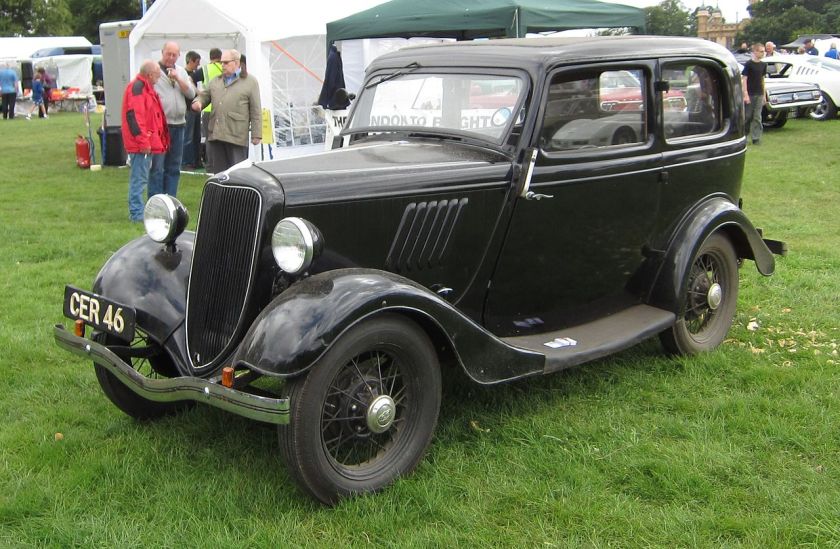 |
|
| Overview | |
| Manufacturer | Ford of Britain Ford SAF Ford Germany |
| Production | 1932–37 175,000 made. |
| Body and chassis | |
| Body style | 2-door saloon 4-door saloon 2-door estate 2-door van 2-door pickup |
| Powertrain | |
| Engine | 0.9 L Straight-4 |
| Dimensions | |
| Wheelbase | 78 in (1,981 mm) |
| Length | 141 in (3,581 mm) |
| Width | 55 in (1,397 mm) |
| Height | 64 in (1,626 mm) |
| Curb weight | 1,540 lb (700 kg) |
| Chronology | |
| Successor | Ford 7Y |
The Model Y is the first Ford automobile specifically designed for markets outside the United States of America, replacing the Model A in Europe.
Production locations
It was in production in England, where it is sometimes remembered as the “Ford Eight”,reflecting its fiscal horsepower rating, from 1932 until September 1937,
The car was also produced in France (where it was known as the Ford 6 CV, despite actually falling within the 5CV French car tax band) from 1932 to 1934, and in Germany as the Ford Köln from 1933 to 1936.
Smaller numbers were assembled in Australia (where a coupé version was also produced), Japan, Latvia (branded as the Ford Junior) and in Spain (branded as the Ford Forito). Plans to build it in the U.S. were scrubbed when a cost accounting showed that it would only be slightly cheaper to build than the Ford Model B.
The car
The car was powered by a 933 cc, 8 (RAC)hp Ford Sidevalve engine. The little Ford was available in two and four-door versions. In June 1935 a reduced specification two-door model was the only closed-body car ever to sell in Britain for just £100, a price it held until July 1937.
The suspension was by the traditional Ford transverse leaf springs front and rear and the engine drove the rear wheels through a three-speed gearbox which, right from the start, featured synchromesh between the top two ratios. The maximum speed was just under 60 mph (95 km/h) and fuel consumption was 32 miles per imperial gallon (8.8 L/100 km; 27 mpg-US).
Even by the standards of the time, the UK-built Ford 8, like its major competitor the Austin 7, was found noteworthy for its “almost unbelievable lack of brakes.”
Evolution
For the first 14 months the original model with a short radiator grille was produced, this is known as the “short rad”. After this in October 1933 the “long rad” model, with its longer radiator grille and front bumper with the characteristic dip was produced. By gradually improving production efficiency and by simplifying the body design the cost of a “Popular” Model Y was reduced to £100, making it the cheapest true 4-seater saloon ever, although most customers were persuaded to pay extra for a less austere version. Both 4-door (Fordor) and 2-door (Tudor) saloons were produced and these could be had either with a fixed roof, or the slightly more expensive sliding “sun” roof.
Additional body version
Also offered was an attractive 5 cwt van, which proved very popular with small businesses.
Ford did not produce an open-top car because it was thought that the chassis was too flexible, but several specialist coach builders produced a range of Model Y tourers.
Commercial
Market reaction in Britain
Although of American design, the Model Y took the British market by storm, and when it was first introduced it made a major dent in the sales figures of Austin, Morris, Singer, and Hillman. It went on to take more than 50 per cent of the 8(RAC)HP sales.
Volumes
Some 175,000 Model Ys were produced worldwide (153,117 in England, 11,121 in Germany) and the ‘Y’ and ‘C’ Register has knowledge of approximately 1250 survivors.
Ford Model C:a successor in Germany but not in Britain
In Britain the larger and faster 10(RAC)hp Model C never sold in such great numbers as the Model Y although there was a very attractive factory produced tourer. In 1935 the styling was enhanced with some small modifications and the model was designated the CX.
In Germany the position was reversed. The locally produced Ford Model C was branded as the Ford Eifel, and remained in production for four years after the manufacturer had given up on the locally produced Type Y, the Ford Köln. The Ford Köln was outcompeted by the Opel 1.0/1.2 litre, and only 11,121 Kölns were produced, while a more respectable 62,495 Ford Eifels were manufactured between 1935 and 1940.
End of Part II
